Laird Connectivity RM191 RM191-SM User Manual Revised v0 4
Laird Technologies RM191-SM Users Manual Revised v0 4
Contents
- 1. Users Manual Revised v0_4
- 2. Users Manual Vv 0_4
- 3. Reference Antenna Info A
- 4. Reference Antenna Info B
- 5. Users Manual
Users Manual Revised v0_4
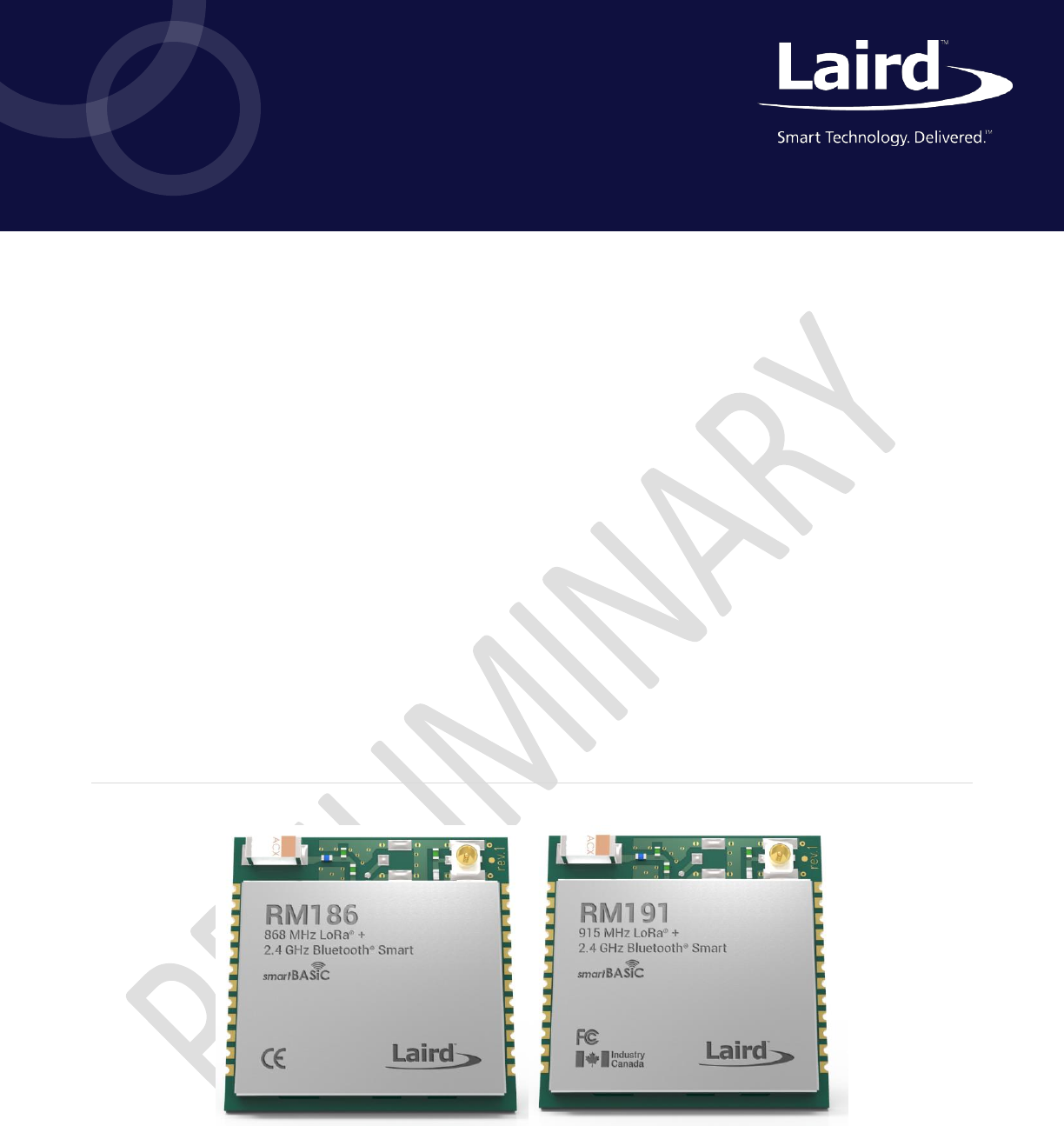
A
Hardware Integration Guide
LoRa/Bluetooth Low Energy (BLE) Module
Part Numbers: RM186 and RM191
Preliminary Version 0.04
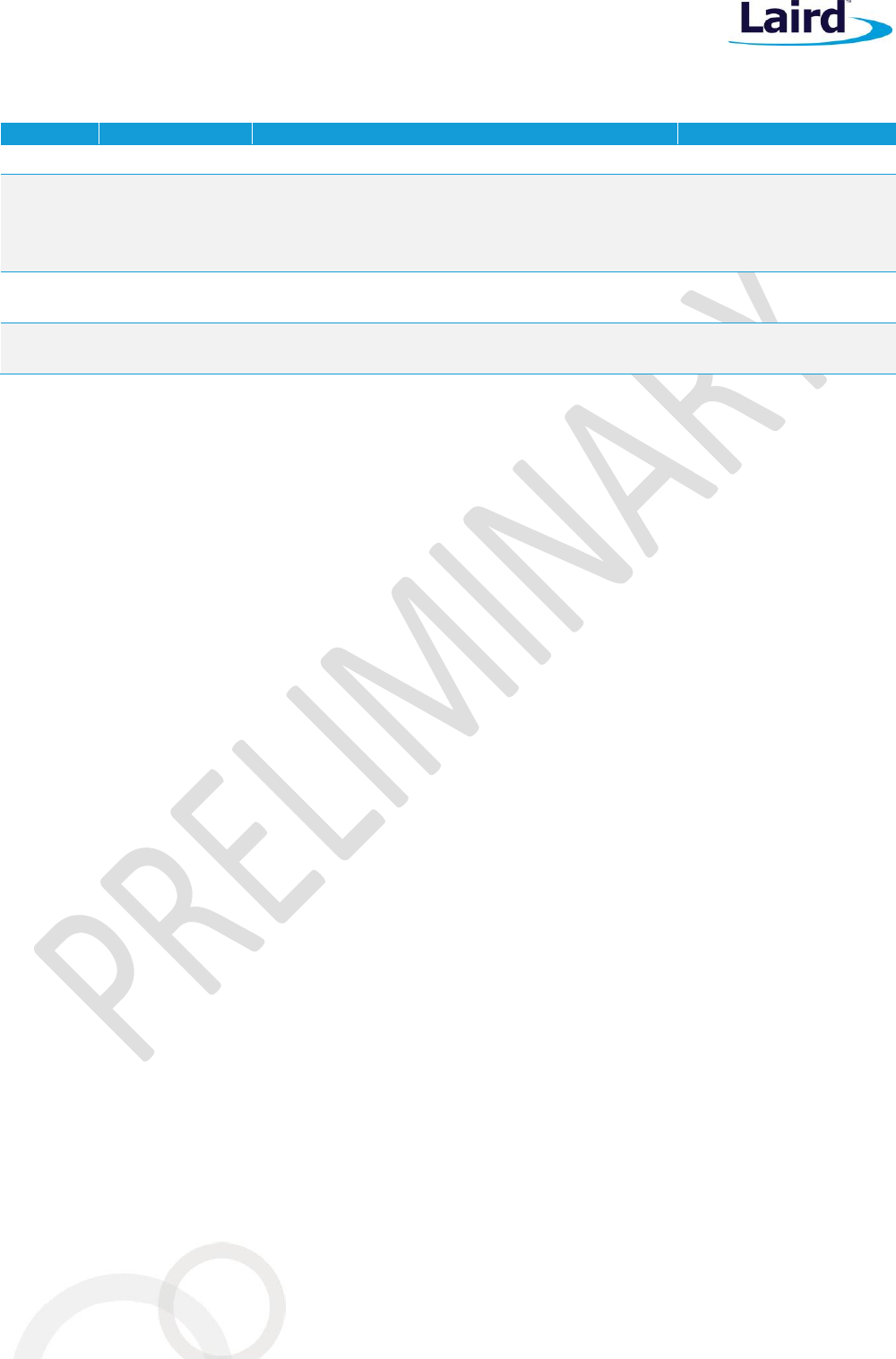
LoRa/BLE Modules
Hardware Integration Guide
Embedded Wireless Solutions Support Center:
http://ews-support.lairdtech.com
www.lairdtech.com/wireless
2
© Copyright 2016 Laird. All Rights Reserved
Americas: +1-800-492-2320
Europe: +44-1628-858-940
Hong Kong: +852 2923 0610
REVISION HISTORY
Version
Date
Notes
Approver
0.01
28 Mar 2016
Preliminary Release
Jonathan Kaye
0.02
31 Mar 2016
Deleted Note 3 for power supply rise time in
section ”Recommended Operating Parameters”
Modified section “FCC and IC Regulatory
Statements“
John Talley
0.03
28 April 2016
Updated Max Transmit power, temperatures, and
DVK descriptions.
Jonathan Kaye
0.04
29 April 2016
Update to IC Radiation Exposure Statement,
Operating temperatures.
John Talley
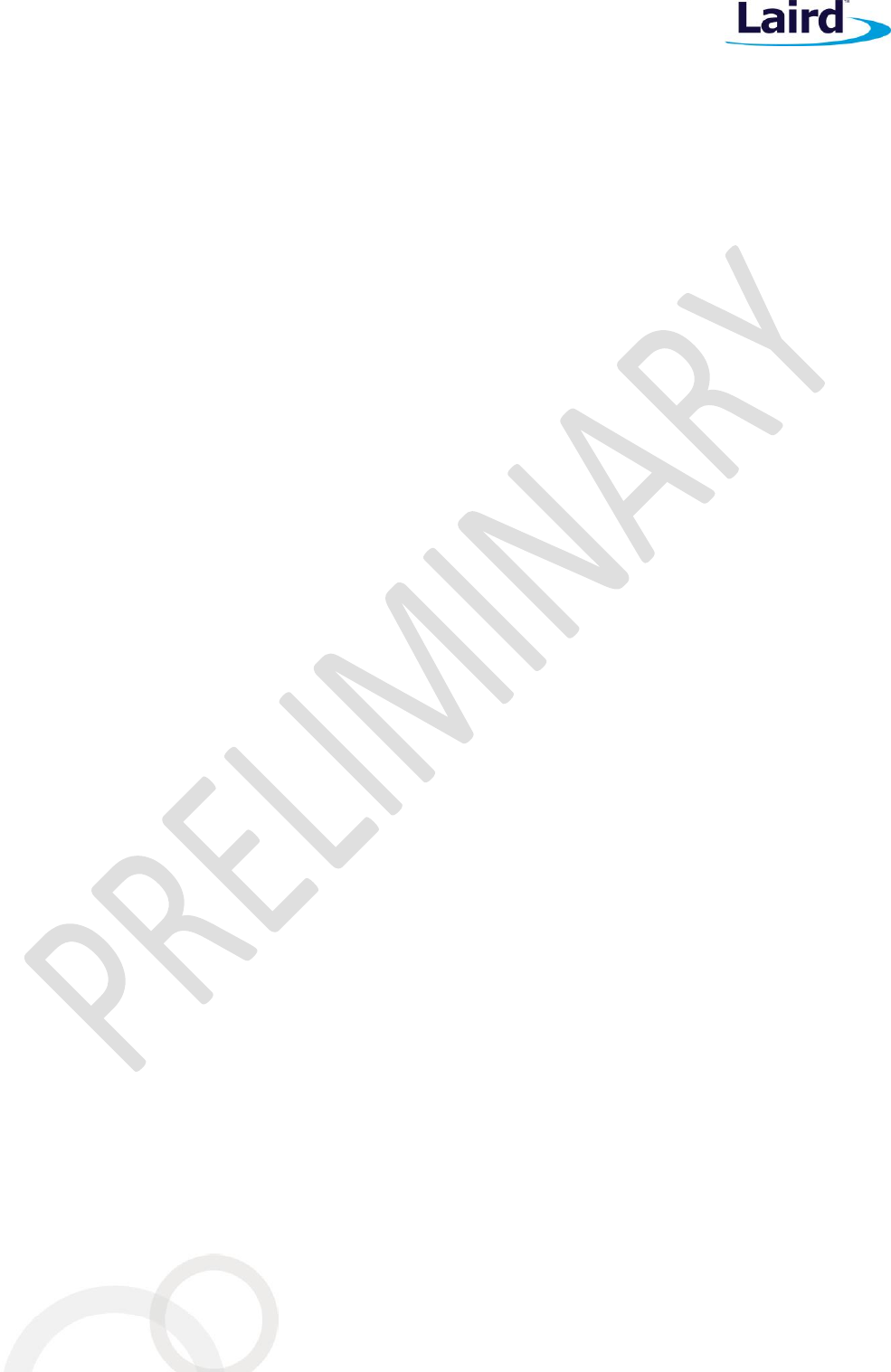
LoRa/BLE Modules
Hardware Integration Guide
Embedded Wireless Solutions Support Center:
http://ews-support.lairdtech.com
www.lairdtech.com/wireless
3
© Copyright 2016 Laird. All Rights Reserved
Americas: +1-800-492-2320
Europe: +44-1628-858-940
Hong Kong: +852 2923 0610
CONTENTS
Overview and Key Features ........................................................................................................................................5
Features and Benefits .............................................................................................................................................5
Application Areas ....................................................................................................................................................5
Specifications ..............................................................................................................................................................6
Hardware Specifications .............................................................................................................................................9
Block Diagram and Pin-out .....................................................................................................................................9
Pin Definitions ..................................................................................................................................................... 10
Electrical Specifications ....................................................................................................................................... 12
Absolute Maximum Ratings............................................................................................................................. 12
Recommended Operating Parameters ............................................................................................................ 12
nAutoRUN Pin and Operating Modes .............................................................................................................. 14
LoRa Power Consumption ....................................................................................................................................... 15
BLE Power Consumption ......................................................................................................................................... 15
BLE Measured Peak Current Waveforms during Connection ............................................................................. 17
Peripheral Block Current Consumption ............................................................................................................... 17
Functional Description ............................................................................................................................................. 18
Power Management (includes brown-out and power on reset) ........................................................................ 18
Clocks and Timers ................................................................................................................................................ 19
Clocks ............................................................................................................................................................... 19
Timers .............................................................................................................................................................. 19
Memory for smartBASIC Application Code ......................................................................................................... 19
RF ......................................................................................................................................................................... 19
UART Interface .................................................................................................................................................... 19
SPI Bus ................................................................................................................................................................. 20
I2C Interface ........................................................................................................................................................ 21
General Purpose I/O, ADC and PWM/FREQ ........................................................................................................ 21
GPIO ................................................................................................................................................................. 21
ADC .................................................................................................................................................................. 21
PWM and FREQ Signal Output on up to Two SIO Pins .................................................................................... 22
nRESET Pin ........................................................................................................................................................... 22
nAutoRUN Pin ...................................................................................................................................................... 22
Two-Wire SWD Programming/Debug Interface .................................................................................................. 22
RM1xx on-board chip antenna characteristics .................................................................................................... 23
Hardware Integration Suggestions .......................................................................................................................... 23
Circuit .................................................................................................................................................................. 23
PCB Layout on Host PCB - General ...................................................................................................................... 25
Antenna Keep-out on Host PCB ....................................................................................................................... 25
Antenna Keep-out and Proximity to Metal or Plastic ...................................................................................... 26
LoRa External Antenna Integration with RM1xx ................................................................................................. 27
Mechanical Details .................................................................................................................................................. 27
RM1xx Mechanical Details .................................................................................................................................. 27
Host PCB Land Pattern and Antenna Keep-out for RM1xx.................................................................................. 28
Application Note for Surface Mount Modules ........................................................................................................ 28
Introduction ......................................................................................................................................................... 28
Shipping ............................................................................................................................................................... 29
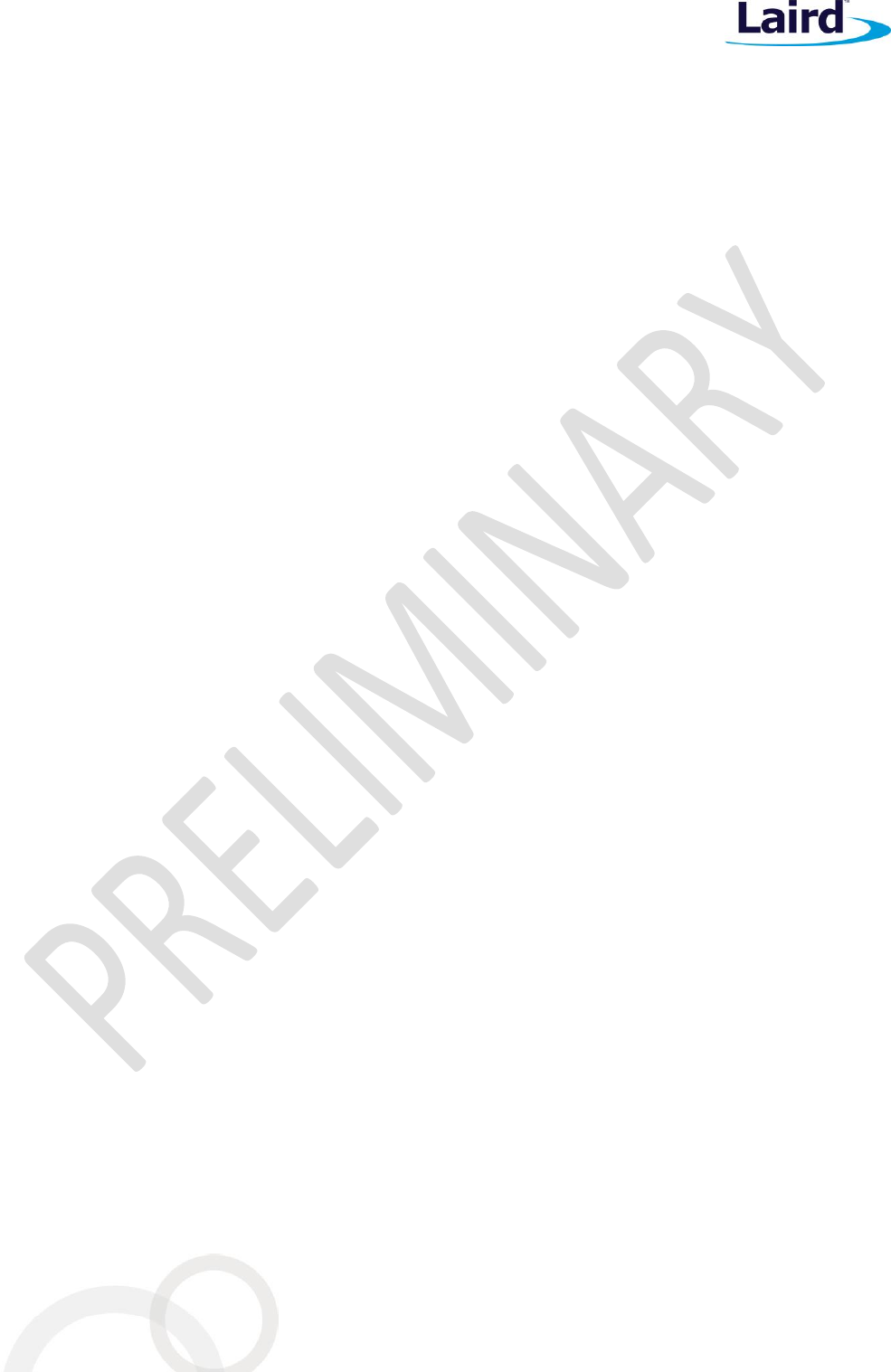
LoRa/BLE Modules
Hardware Integration Guide
Embedded Wireless Solutions Support Center:
http://ews-support.lairdtech.com
www.lairdtech.com/wireless
4
© Copyright 2016 Laird. All Rights Reserved
Americas: +1-800-492-2320
Europe: +44-1628-858-940
Hong Kong: +852 2923 0610
Reflow Parameters .............................................................................................................................................. 29
FCC and IC Regulatory Statements .......................................................................................................................... 31
Power Exposure Information............................................................................................................................... 32
OEM Responsibilities ........................................................................................................................................... 32
CE Regulatory .......................................................................................................................................................... 34
Antenna Information ........................................................................................................................................... 35
EU Declarations of Conformity ................................................................................................................................ 36
RM186-SM ........................................................................................................................................................... 36
Ordering Information .............................................................................................................................................. 37
General Comments .............................................................................................................................................. 37
Bluetooth SIG Qualification ..................................................................................................................................... 37
Overview .............................................................................................................................................................. 37
Qualification Steps When Deviating From a Laird End Product Design .............................................................. 38
Additional Assistance .......................................................................................................................................... 39
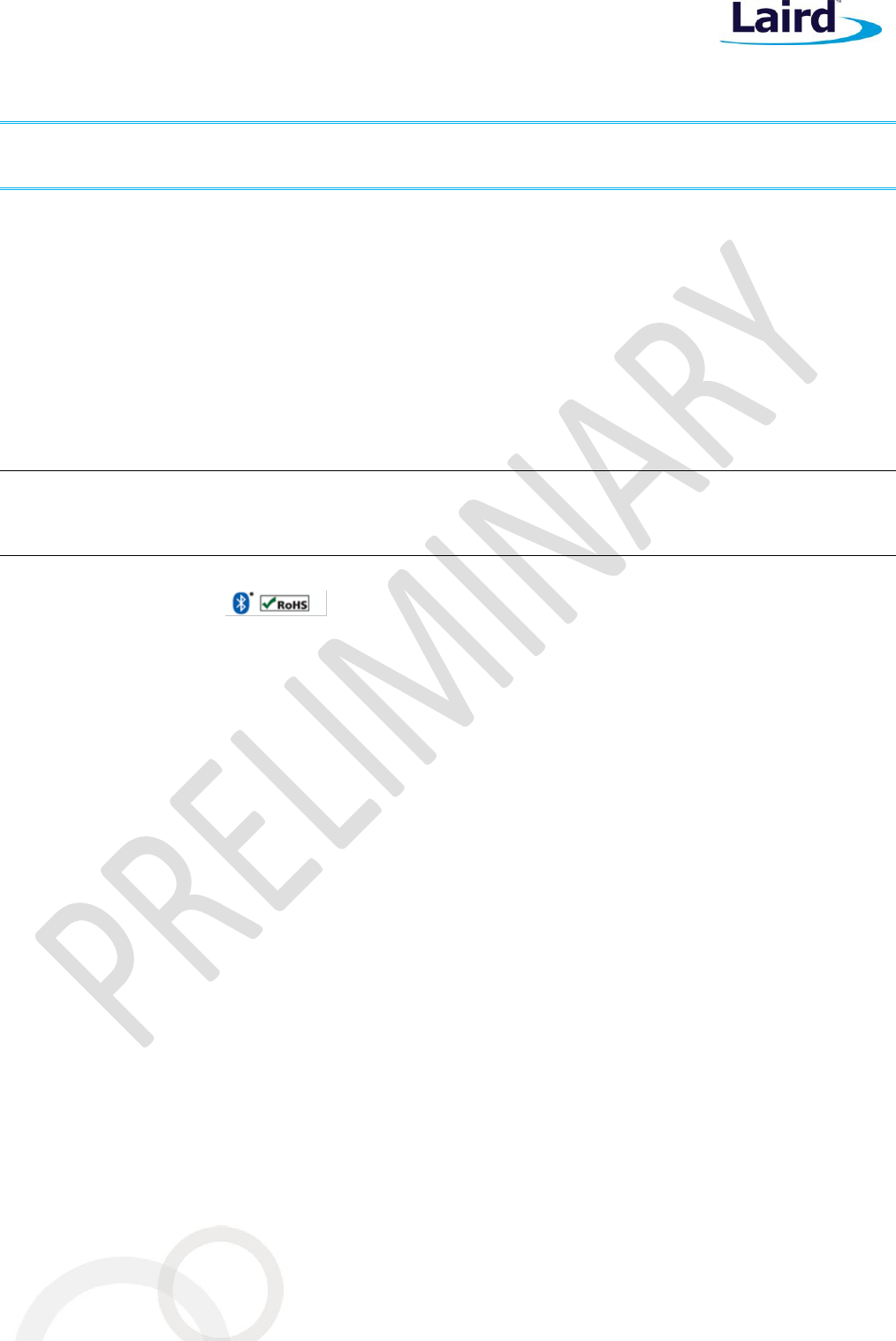
LoRa/BLE Modules
Hardware Integration Guide
Embedded Wireless Solutions Support Center:
http://ews-support.lairdtech.com
www.lairdtech.com/wireless
5
© Copyright 2016 Laird. All Rights Reserved
Americas: +1-800-492-2320
Europe: +44-1628-858-940
Hong Kong: +852 2923 0610
OVERVIEW AND KEY FEATURES
This Hardware Integration Guide describes both the RM186 (868MHz band for EU) and RM191 (915MHz band
for US). The differences will be outlined in the Radio Specifications.
Every RM1xx Series module is designed to enable OEMs to add a long range LoRa radio link as well as central
role Bluetooth Low Energy (BLE) to small, portable, power-conscious devices. The RM1xx modules are enabled
with Laird’s smart BASIC, an event-driven programming language that enables OEMs to make their product
development quicker and simpler, significantly reducing time to market. smartBASIC enables customers to
develop a complete embedded application inside the compact RM1xx hardware, connecting to a wide array of
external sensors via its I2C, SPI, UART, ADC or GPIO interfaces.
Based on the world-leading Nordic Semiconductor nRF51822 (BLE) and Semtech Sx1272 (LoRa) chipsets, the
RM1xx modules provide ultra-low power consumption with outstanding wireless range using the LoRa radio link
and local BLE connections via 3 dBm of transmit power. This document should be read in conjunction with the
smart BASIC user manual.
Note: This is a PRELIMINARY version of the RM1xx Hardware Integration Guide. Information in this
document is subject to change. Please contact Laird to obtain the most recent version of this
document – http://ews-support.lairdtech.com.
Features and Benefits
Application Areas
Bluetooth v4.0 – Central Mode
On Board BLE Chip Antenna
u.FL for external LoRa antenna
smartBASIC programming language
Bluetooth SIG Listed
Compact Footprint
Long Range LoRa range up to 15km
BLE Programmable TX power +3 dBm to -20 dBm
BLE TX whisper mode (-30 dBm, -55 dBm)
BLE RX sensitivity: -91 dBm
Ultra-low power consumption
BLE TX: 11.6 mA peak (at +3 dBm) (See Note 4 in the Power
Consumption section)
BLE RX: 8.8 mA peak (See Note 4 in the Power Consumption
section)
Standby Doze: TBD
Deep Sleep: TBD (See Note 4 in the Power Consumption
section)
UART, GPIO, ADC, PWM FREQ output, TIMERS, I2C, and SPI
interfaces
Fast Time to Market
FCC/IC (RM191-SM), CE (RM186-SM)
No external components required
Public or Private Networks
Irrigation / Agriculture
Parking
Lighting
Asset Tracking
Tank Monitoring
Smart Home – smoke alarms,
heating,
Access Control – security
Industrial Automation –
Factory
Any long range, battery
powered sensor application!
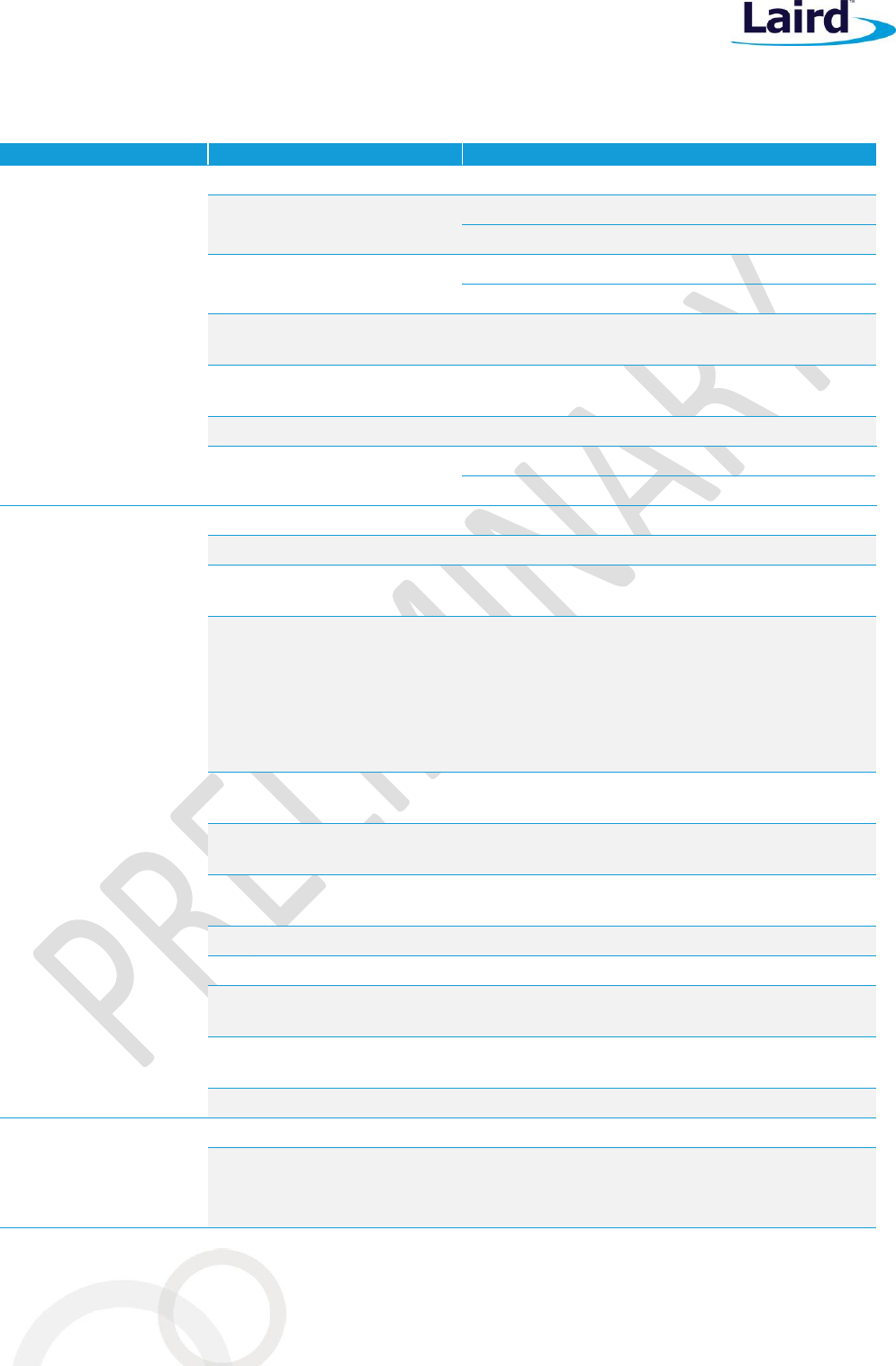
LoRa/BLE Modules
Hardware Integration Guide
Embedded Wireless Solutions Support Center:
http://ews-support.lairdtech.com
www.lairdtech.com/wireless
6
© Copyright 2016 Laird. All Rights Reserved
Americas: +1-800-492-2320
Europe: +44-1628-858-940
Hong Kong: +852 2923 0610
SPECIFICATIONS
Table 1: Specifications
Categories
Feature
Implementation
LoRa Wireless
Specification
LoRa®
LoRaWAN 1.01 (End Device)
Frequency
902-928MHz
RM191
865-870 MHz
RM186
Maximum Transmit Power
Setting
15.5 dBm
RM191
13.5 dBm
RM186
Minimum Transmit Power
Setting
1.5 dBm
Receive Sensitivity
Up to -135 dBm
(Bandwidth 125 kHz Spreading Factor 12)
Range
Up to 15 km in free space
Raw Data Rates
(over the air)
250 bps – 50 kbps
RM186
980 bps – 21.9kbps
RM191
BLE Wireless
Specification
Bluetooth® (BLE)
V4.0 – Central Mode
Frequency
2.402 - 2.480 GHz
Maximum Transmit Power
Setting
3 dBm (into -1.5 dBi chip antenna)
Minimum Transmit Power
Setting
-20 dBm (in 4 dB steps) with smartBASIC command
-16 dBm
-12 dBm
-8 dBm
-4 dBm
0 dBm
TX Whisper Mode 1
Transmit Power
-30 dBm (min.) with smartBASIC command
TX Whisper Mode 2 Transmit
Power
-55 dBm (min.) with smartBASIC command
Receive Sensitivity
(0.1% BER)
-91 dBm typical
Link Budget
95 dB (@ 1 Mbps)
Range
Up to 100 m in free space
TX Whisper Modes
Range reduction feature with TX Whisper modes
with smartBASIC command.
Range
(TX Whisper Mode 2)
<~30 cm
Raw Data Rates
1 Mbps (over the air)
Host Interface and
Peripherals
Total
14 x Multifunction I/O lines
UART
TX, RX, CTS, RTS
DCD, RI, DTR, DSR, CTS, RTS (Note 1)
Default 115200, n, 8, 1
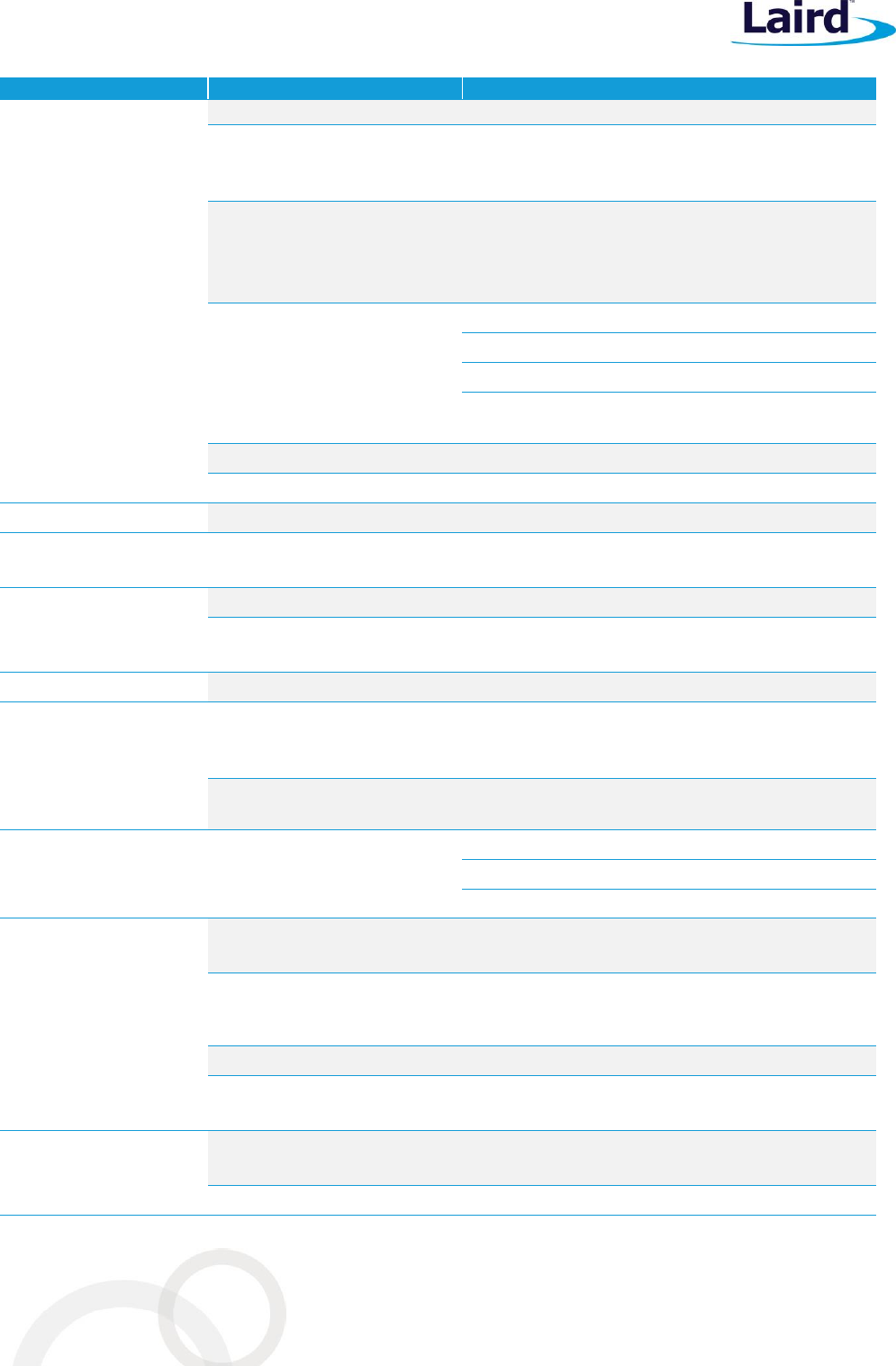
LoRa/BLE Modules
Hardware Integration Guide
Embedded Wireless Solutions Support Center:
http://ews-support.lairdtech.com
www.lairdtech.com/wireless
7
© Copyright 2016 Laird. All Rights Reserved
Americas: +1-800-492-2320
Europe: +44-1628-858-940
Hong Kong: +852 2923 0610
Categories
Feature
Implementation
From 1,200 to 460800 bps
GPIO
Up to 14
With configurable I/O direction, O/P drive strength
(standard 0.5 mA or high 5 mA), pull-up/pull-down
ADC
Four 10-bit channels (including ADC reference)
10 bit resolution
1.2 V internal reference
1/1, 2/3, 1/3 pre-scaling
PWM or FREQ output
PWM or FREQ output on up to two GPIO output pins:
PWM output duty cycle
0%-100%
PWM output frequency
Up to 500 kHz (Note 7)
FREQ output frequency
0 MHz-4 MHz
(50% duty cycle)
I2C
One I2C interface (up to 400 kbps) (Note 2)
SPI
One SPI Master interface (up to 4 Mbps) (Note 3)
Services
Services supported
GATT client and capabilities
FW Upgrade
smartBASIC runtime engine FW
upgrade
(1) Via UART
(2) Via 2-Wire SWD Programming/Debug Interface
Programmability
smartBASIC
On-board programming language similar to BASIC.
smartBASIC application
download
(1) Via UART.
(2) Via 2-Wire SWD Programming/Debug Interface
Control Protocols
Any
User defined via smartBASIC
Operating Modes
Self-contained Run mode
Selected by nAutoRun pin status:
nAutoRun = LOW (0V): Then runs $autorun$
(smartBASIC application script) if it exists.
Interactive / development
mode
nAutoRun = HIGH (VCC): Then runs via at+run (and
“file name” of smartBASIC application script).
Supply Voltage
Supply (VCC)
2.1V – 3.5V
Internal DCDC converter (Note 5)
1.8V – 2.1V
Internal LDO
DCDC switched on if VCC >2.1V at power-up
Power Consumption
Active modes peak current
(for Max TX PWR 3 dBm)
Connected mode
11.6 mA peak TX
8.9 mA peak RX
Active modes peak current
(for TX Whisper mode2 PWR -
55 dBm)
Connected mode
5 mA peak TX
8.5 mA peak RX
Active modes average current
Depends on many factors. See Power Consumption.
Ultra-low power modes
Standby Doze
Deep Sleep
2.6 uA typical (Note 6)
600 nA (Note 6)
Antenna Options
BLE (Internal) chip antenna
On-board ceramic chip monopole antenna
-1.5 dBi
LoRa (External)
Dipole antenna with U.FL (IPEX) connector up to 2 dBi
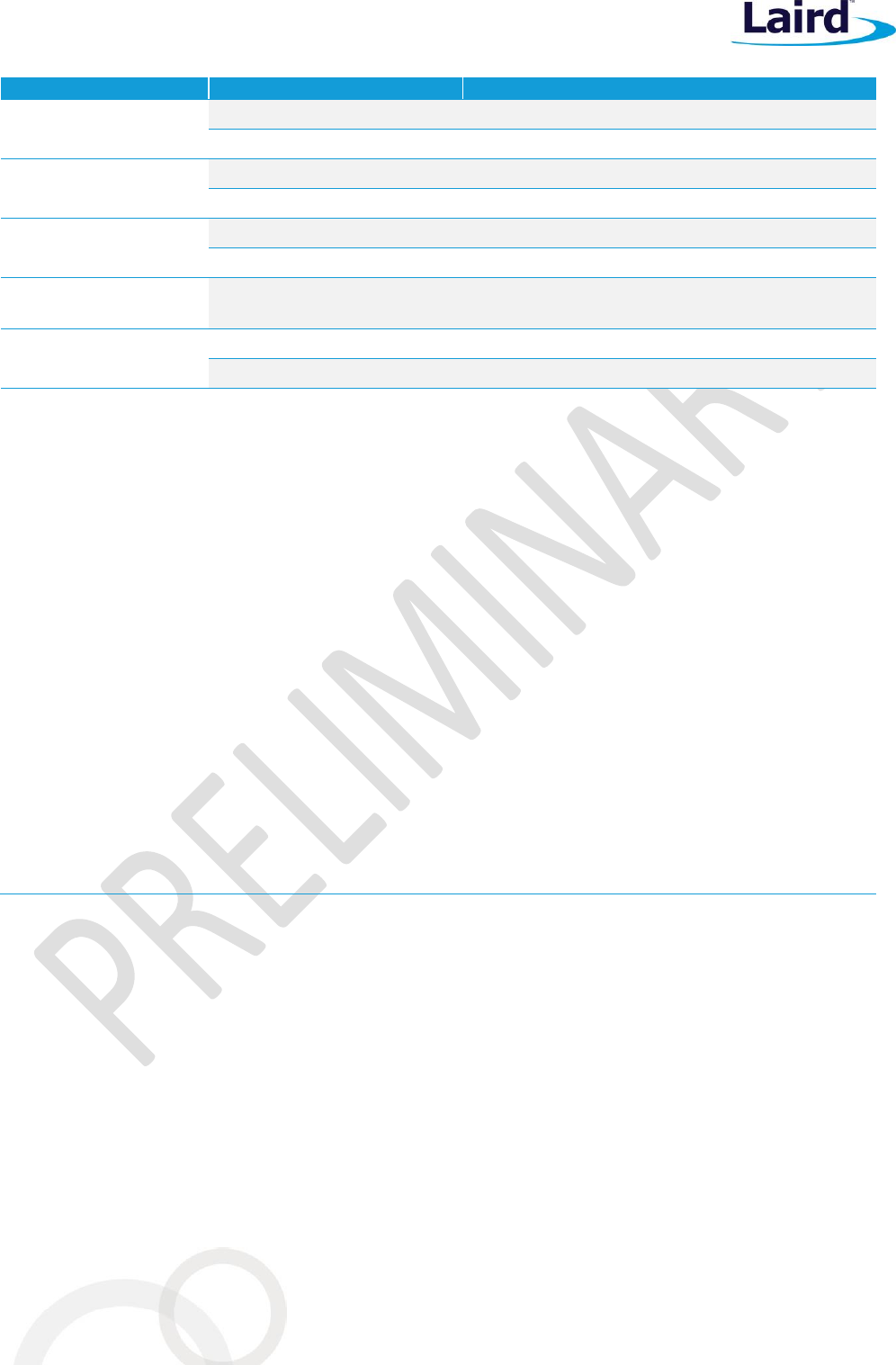
LoRa/BLE Modules
Hardware Integration Guide
Embedded Wireless Solutions Support Center:
http://ews-support.lairdtech.com
www.lairdtech.com/wireless
8
© Copyright 2016 Laird. All Rights Reserved
Americas: +1-800-492-2320
Europe: +44-1628-858-940
Hong Kong: +852 2923 0610
Categories
Feature
Implementation
Physical
Dimensions
25.4 mm x 25.4 mm x 3.1 mm
Weight
3 grams
Environmental
Operating
-40 ˚C to +85 ˚C (VCC 1.8V – 3.5 V)
Storage
-40 ˚C to +85 ˚C
Miscellaneous
Lead Free
Lead-free and RoHS compliant
Warranty
5-Year Limited Lifetime
Development Tools
Development Kit
Development Kit DVK-RM1xx and
Free Software Tools
Approvals
Bluetooth®
SIG Listed – Declaration ID
FCC / IC / CE
RM191-SM: FCC/IC, RM186-SM: CE
Note 1: DSR, DTR, RI, and DCD can be implemented in the smart BASIC application.
Note 2: With I2C interface selected, pull-up resistors on I2C SDA and I2C SCL MUST be connected
externally as per I2C standard.
Note 3: SPI interface (master) consists of SPI MOSI, SPI MISO and SPI CLK. SPI CS is created by
customer using any spare SIO pin within their smartBASIC application script allowing multi-
dropping.
Note 4: RM1xx module comes loaded with smart BASIC runtime engine FW, but does not come
loaded with any smart BASIC application script (as that is dependent on customer end
application or use). Laird provides many sample smart BASIC application scripts covering the
services listed. Additional applications being added every quarter.
Note 5: Laird suggests using Vcc of 3.3V +/-5% (3.13V-3.46V) for maximum LoRa output power.
WARNING: above 3.5V, the LoRa transmitter will be disabled to maintain regulatory compliance
Note 6: Deep Sleep current <1000nA (typical).
Standby Doze current TBD (typical).
Note 7: PWM output signal has a frequency and duty cycle property. PWM output is generated
using 32-bit hardware timers. The timers are clocked by a 1MHz (1uS period) clock source.
Trade-off PWM output frequency with resolution. For example:
PWM output frequency of 500kHz (2uS) results in resolution of 1:2
PWM output frequency of 100kHz (10uS) results in resolution of 1:10
PWM output frequency of 10kHz (100uS) results in resolution of 1:100
PWM output frequency of 1kHz(1000uS) results in resolution of 1:1000
Refer to the smartBASIC user guide for details.
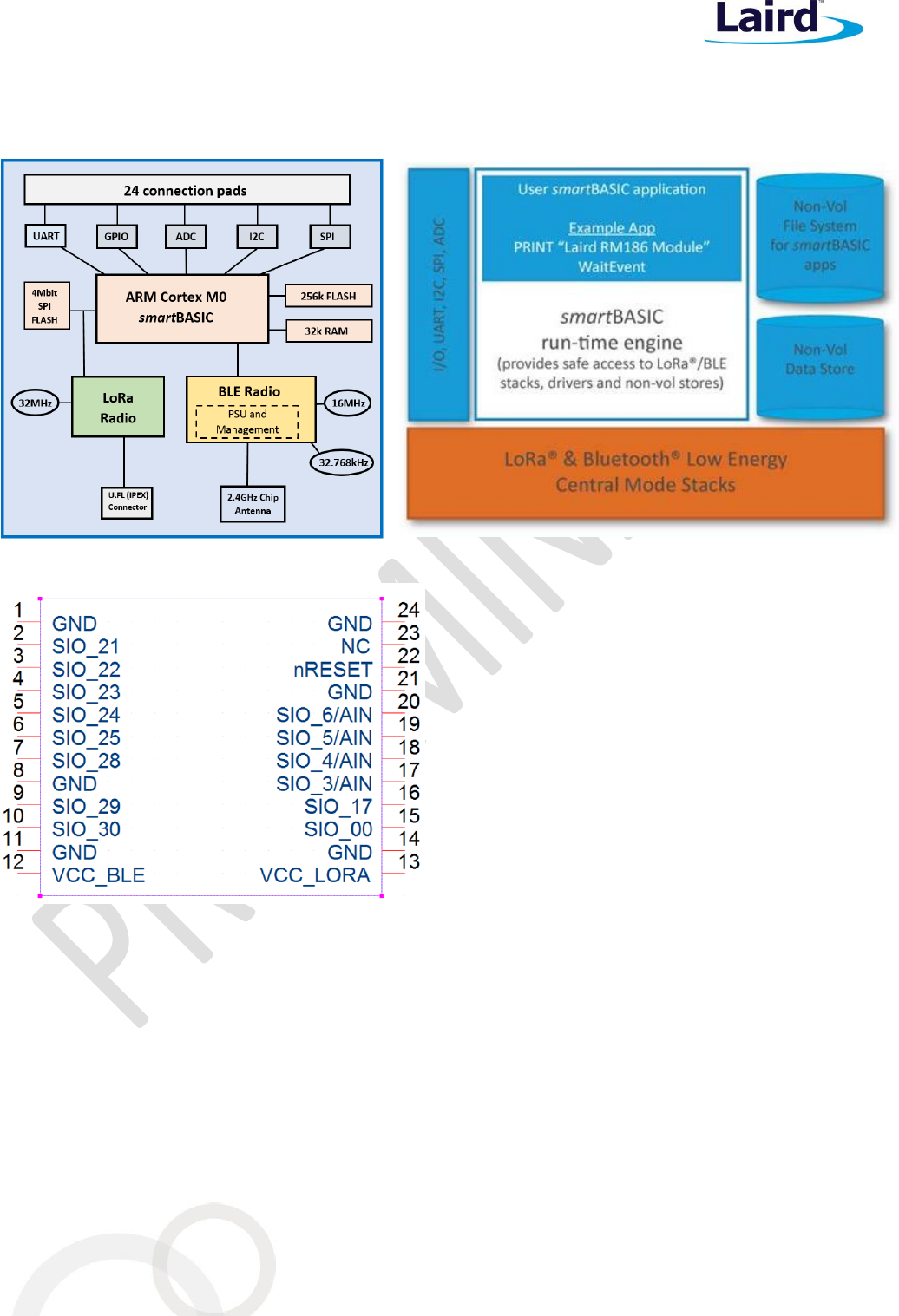
LoRa/BLE Modules
Hardware Integration Guide
Embedded Wireless Solutions Support Center:
http://ews-support.lairdtech.com
www.lairdtech.com/wireless
9
© Copyright 2016 Laird. All Rights Reserved
Americas: +1-800-492-2320
Europe: +44-1628-858-940
Hong Kong: +852 2923 0610
HARDWARE SPECIFICATIONS
Block Diagram and Pin-out
Figure 1: Functional HW and SW block diagram for RM1xx series smartBASIC modules
Figure 2: RM186/RM191 module pin-out (top view)
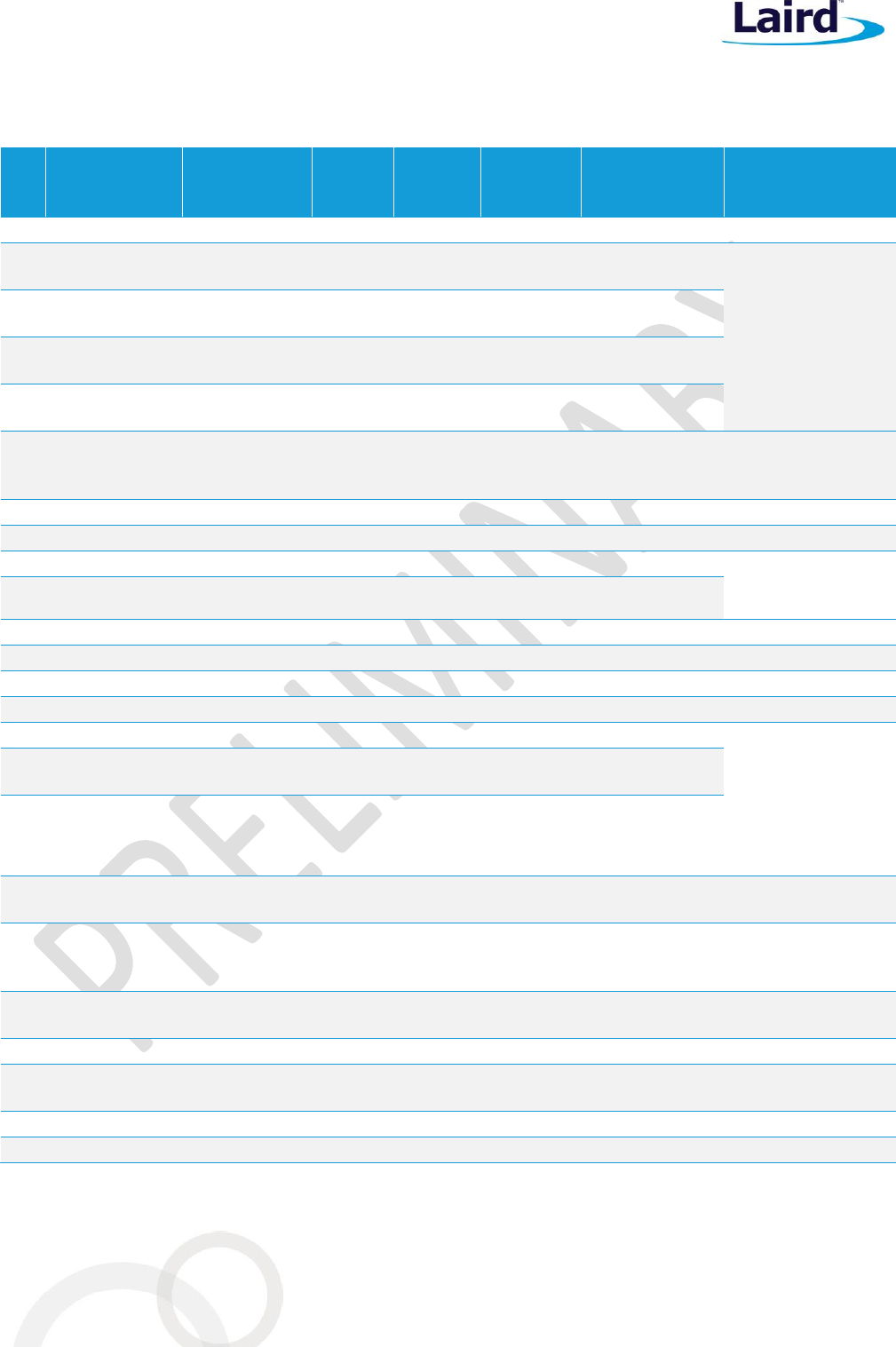
LoRa/BLE Modules
Hardware Integration Guide
Embedded Wireless Solutions Support Center:
http://ews-support.lairdtech.com
www.lairdtech.com/wireless
10
© Copyright 2016 Laird. All Rights Reserved
Americas: +1-800-492-2320
Europe: +44-1628-858-940
Hong Kong: +852 2923 0610
Pin Definitions
Table 2: Pin definitions
Pin
#
Pin
Name
Default
Function
Alt.
Funct.
Default
Direction
Note14
Pull-up/
Pull-down
Note14
Notes
Comment
1
GND
-
-
-
-
-
-
2
SIO_21
DIO
UART TX
OUT
Set high in
FW
1,2,4,6,7
UARTCLOSE() selects
DIO functionality
and UARTOPEN()
selects UART comms
behaviour
3
SIO_22
DIO
UART
RX
IN
PULL-UP
1,2,4,6,7
4
SIO_23
DIO
UART
RTS
OUT
Set low in
FW
1,2,4,6,7
5
SIO_24
DIO
UART
CTS
IN
PULL-
DOWN
1,2,4,6,7
6
SIO_25
nAutoRUN/DIO
DIO
IN
NONE
IN ONLY
Laird Devkit,
UART_DSR via J10,
J12
7
SIO_28
DIO
-
IN
PULL-UP
13,1,2,6
Laird DevKit: J6
8
GND
-
-
-
-
-
9
SIO_29
DIO
I2C SCL
IN
PULL-UP
1,2,6,11
I2COPEN() in
smartBASIC selects
I2C function
10
SIO_30
DIO
I2C SDA
IN
PULL-UP
1,2,6,11
11
GND
12
VCC_BLE
-
-
-
-
-
Vcc for BLE Radio
13
VCC_LORA
-
-
-
-
-
Vcc for Lora Radio
14
GND
-
-
-
-
-
15
SIO_00
DIO
SPI CLK
IN
PULL-UP
1,2,6,11
SPIOPEN() in
smartBASIC selects
SPI function, MOSI
and CLK will be
outputs when in SPI
master mode. See
note 11
16
SIO_17
DIO
SPI
MISO
IN
PULL-UP
1,2,6,11
17
SIO_03/AIN
DIO/AIN
SPI
MOSI
IN
PULL-UP
1,2,3,4,5,6,11
18
SIO_04/AIN
DIO
AIN
IN
PULL-UP
1,2,3,4,5,6,11
Laird Devkit: SPI
Slave Select
19
SIO_05/AIN
DIO
AIN
IN
PULL-UP
1,2,3,4,5,6,11
Laird Devkit:
Button2 or Ana
Temp Sensor via J7
20
SIO_06/AIN
DIO
AIN
IN
PULL-UP
1,2,3,4,5,6,11
Laird Devkit: LED5 or
Arduino A0 Via J8
21
GND
22
nRESET
IN
9,10
System Reset (Active
low)
23
NC
9
DO NOT CONNECT
24
GND
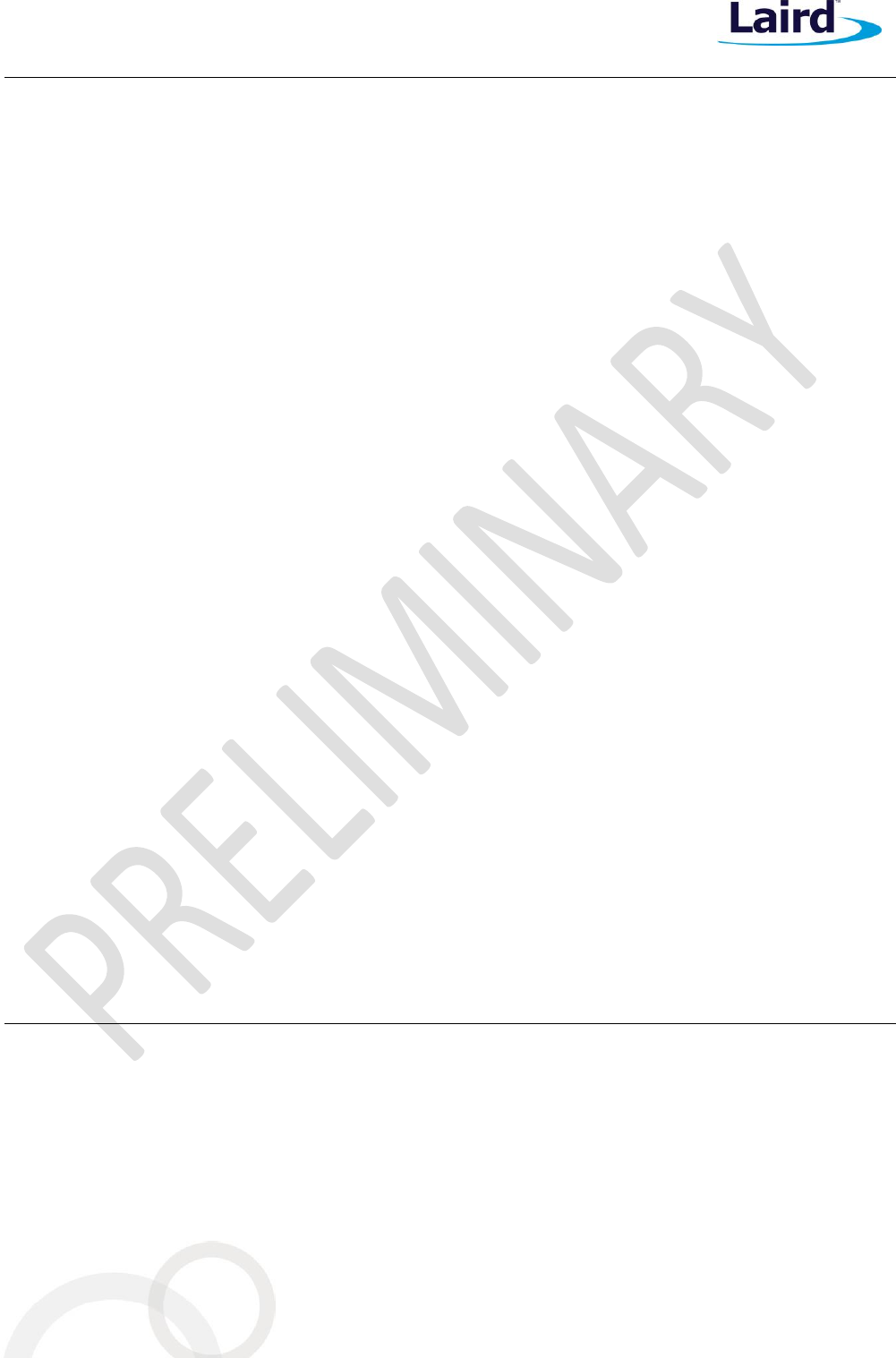
LoRa/BLE Modules
Hardware Integration Guide
Embedded Wireless Solutions Support Center:
http://ews-support.lairdtech.com
www.lairdtech.com/wireless
11
© Copyright 2016 Laird. All Rights Reserved
Americas: +1-800-492-2320
Europe: +44-1628-858-940
Hong Kong: +852 2923 0610
Note 1: Secondary function is selectable in smartBASIC application.
Note 2: DIO = Digital Input or Output. I/O voltage level tracks VCC.
Note 3: AIN = Analog Input
Note 4: DIO or AIN functionality is selected using the GpioSetFunc() function in smartBASIC.
Note 5: AIN configuration selected using GpioSetFunc() function.
Note 6: I2C, UART, SPI controlled by xxxOPEN() functions in smart BASIC.
Note 7: SIO_21 to SIO_24 are DIO by default when $autorun$ app runs on power up.
Note 8: N/A
Note 9: Hidden 2-Wire SWD Programming/Debug Interface, pin22 (SWDIO) and pin23 (SWDCLK). Used for
upgrading smartBASIC runtime engine FW with J-link programmer. Using this hidden 2-Wire SWD
Programming/Debug Interface on customers host PCB requires header connector Samtec FTSH-105-
01-L-DV, refer to section 2-Wire SWD Programming/Debug Interface for details.
Note 10: Pull the nRESET pin (pin 22) low for minimum 100 mS to reset the module.
Note11: SPI CS is created by customer using any spare SIO pin within their smartBASIC application script
allowing multi-dropping.
Note12: N/A
Note13: N/A
Note14: smart BASIC runtime engine has DIO (Default Function) INPUT pins, have by default PULL-UP enabled.
This was done to avoid floating inputs (which can also cause current consumption in low power
modes (e.g. StandbyDoze) to drift with time. In any case customer can disable the PUL-UP through
their smart BASIC application.
All the SIO pins (with a default function of DIO are inputs – apart from SIO_21 and SIO_23, which are
outputs):
- SIO_21 (alternative function UART_TX) is an output, set high (in FW).
- SIO_23 (alternative function UART_RTS) is an output, set low (in FW).
- SIO_22 (alternative function UART_RX) is an input, set with internal pull-up (in FW).
- SIO_24 (alternative function UART_CTS) is an input, set with internal pull-down (in FW).
The RM1xx module is delivered with the integrated smartBASIC runtime engine FW loaded (but no onboard
smartBASIC application script). Because of this, it starts up in AT command mode by default.
At reset, all SIO lines are configured as the defaults shown above.
SIO lines can be configured through the smart BASIC application script to be either inputs or outputs with pull-
ups or pull-downs. When an alternative SIO function is selected (such as I2C or SPI), the firmware does not allow
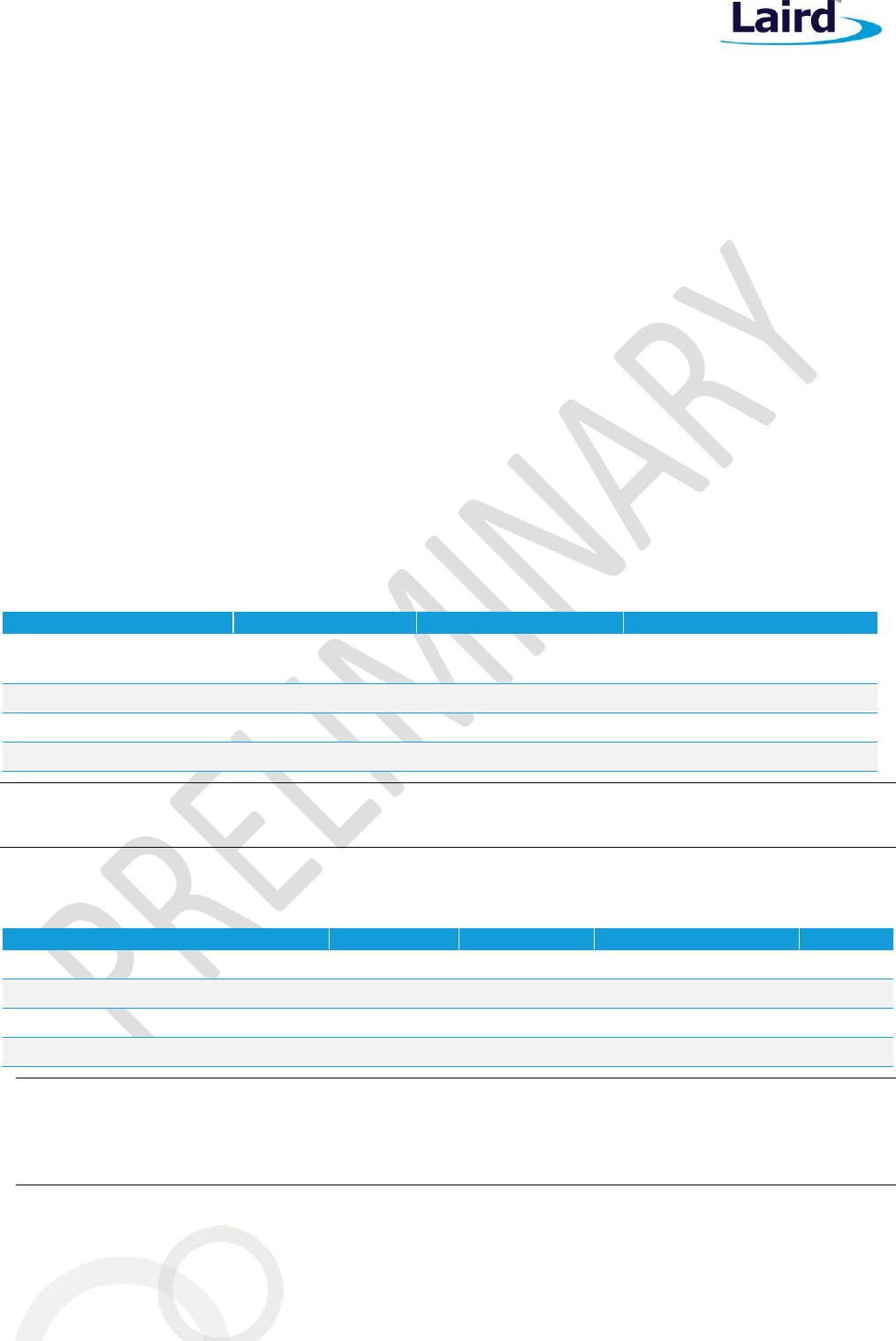
LoRa/BLE Modules
Hardware Integration Guide
Embedded Wireless Solutions Support Center:
http://ews-support.lairdtech.com
www.lairdtech.com/wireless
12
© Copyright 2016 Laird. All Rights Reserved
Americas: +1-800-492-2320
Europe: +44-1628-858-940
Hong Kong: +852 2923 0610
the setup of internal pull-up/pull-down. Therefore, when I2C interface is selected, pull-up resistors on I2C SDA
and I2C SCL MUST be connected externally as per I2C standard.
UART_RX, UART_TX, UART_CTS are Vcc logic levels (if VCC is 3.3 V, i.e. SIO pin I/O levels track VCC). For example,
when RX and TX are idle, they sit at 3.3 V (if VCC is 3.3 V). Conversely, handshaking pins CTS and RTS at 0 V are
treated as assertions.
Pin 6 (nAutoRUN) is an input, with active low logic. In the development kit (DVK-RM1xx-SM) it is connected so
that the state is driven by the host’s DTR output line. The nAutoRUN pin must be externally held high or low to
select between the following two operating modes:
Self-contained Run mode (nAutoRUN pin held at 0 V).
Interactive / development mode (nAutoRUN pin held at VCC).
smartBASIC runtime engine firmware checks for the status of nAutoRUN during power-up or reset. If it is low
and if there is a smartBASIC application script named $autorun$, then the smartBASIC runtime engine FW
executes the application script automatically; hence the name Self-contained Run Mode.
Electrical Specifications
Absolute Maximum Ratings
Absolute maximum ratings for supply voltage and voltages on digital and analogue pins of the module are listed
below; exceeding these values causes permanent damage (Table 3).
Table 3: Maximum Current Ratings
Parameter
Minimum
Maximum
Unit
Voltage at VCC_BLE &
VCC_LORA pin
-0.3
+3.6 (Note 1)
V
Voltage at GND pin
0
V
Voltage at SIO pin
-0.3
VCC+0.3
V
Storage temperature
-40
+85
ºC
Note 1: Absolute Max Rating for VCC pin (max) is 3.6V, however we recommend 3.3V +/-5% as the spec for
maximum Vcc.
The LoRa transmitter shuts down if the voltage exceeds 3.5V
.
Recommended Operating Parameters
Table 4: Power Supply Operating Parameters
Parameter
Minimum
Typical
Maximum
Unit
VCC1
1.8
3
3.5
V
VCC Maximum ripple or noise2
10
mV
VCC rise time
TBD
mS
Operating Temperature Range
-40
-
+85
ºC
Note 1: Internal DCDC is used if VCC >2.1 V on power-up; otherwise internal LDO is used.
If supply voltage is greater than 3.5V, the LoRa transmitter will be disabled.
Note 2: The maximum VCC ripple or noise (at any frequency) that does not disturb the radio.
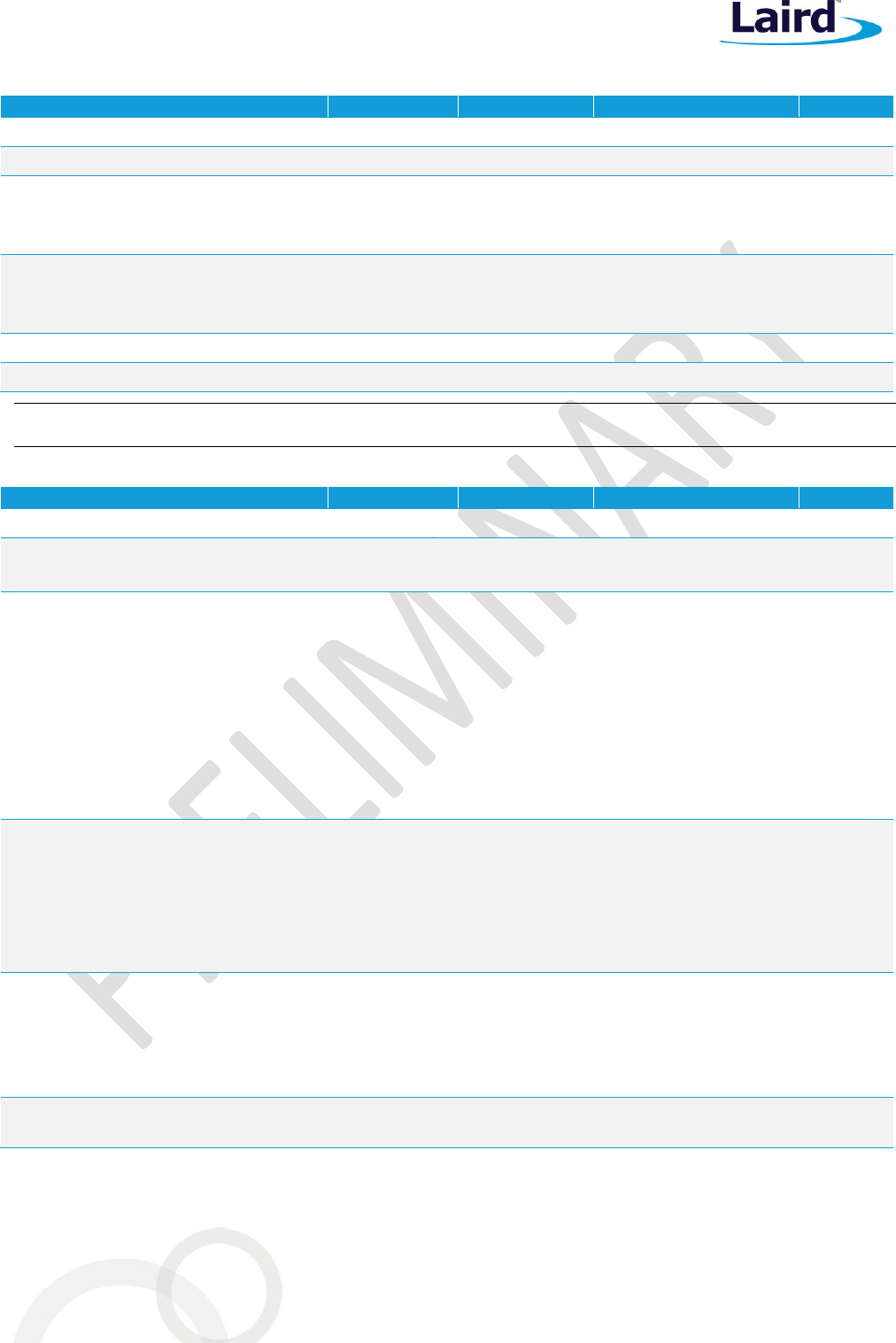
LoRa/BLE Modules
Hardware Integration Guide
Embedded Wireless Solutions Support Center:
http://ews-support.lairdtech.com
www.lairdtech.com/wireless
13
© Copyright 2016 Laird. All Rights Reserved
Americas: +1-800-492-2320
Europe: +44-1628-858-940
Hong Kong: +852 2923 0610
Table 5: Signal Levels for Interface, SIO
Parameter
Minimum
Typical
Maximum
Unit
VIH Input high voltage
0.7VCC
VCC
V
VIL Input low voltage
VSS
0.3
V
VOH Output high voltage
(std. drive, 0.5mA)
(high-drive, 5mA) (Note 1)
VCC-0.3
VCC-0.3
VCC
VCC
V
V
VOL Output low voltage
(std. drive, 0.5mA)
(high-drive, 5mA) (Note 1)
VSS
VSS
0.3
0.3
V
V
Pull up resistance
11
13
16
kΩ
Pull down resistance
11
13
16
kΩ
Note 1: Maximum number of pins with 5mA high drive is three.
Table 6: SIO pin alternative function AIN (ADC) specification
Parameter
Minimum
Typical
Maximum
Unit
ADC Internal reference voltage
-1.5%
1.2 V
+1.5%
%
ADC pin input
internal selectable scaling
1/1, 1/3, 2/3
Scaling
ADC input pin (AIN) voltage maximum
without damaging ADC w.r.t
VCC Prescaling
3.3 V 1/1
3.3 V 2/3
3.3 V 1/3
1.8 V 1/1
1.8 V 2/3
1.8 V 1/3
2.4
3.6
3.6
2.1
2.1
2.1
V
V
V
V
V
V
ADC input pin (AIN) voltage maximum
without saturating ADC (with 1.2V
internal reference)1
1/1 prescaling
2/3 prescaling
1/3 prescaling
1.2
1.8
3.6
V
V
V
Time required to convert single
sample in
10bit mode
9bit mode2
8 bit mode2
68
36
20
uS
uS
uS
ADC input impedance (during
operation)3
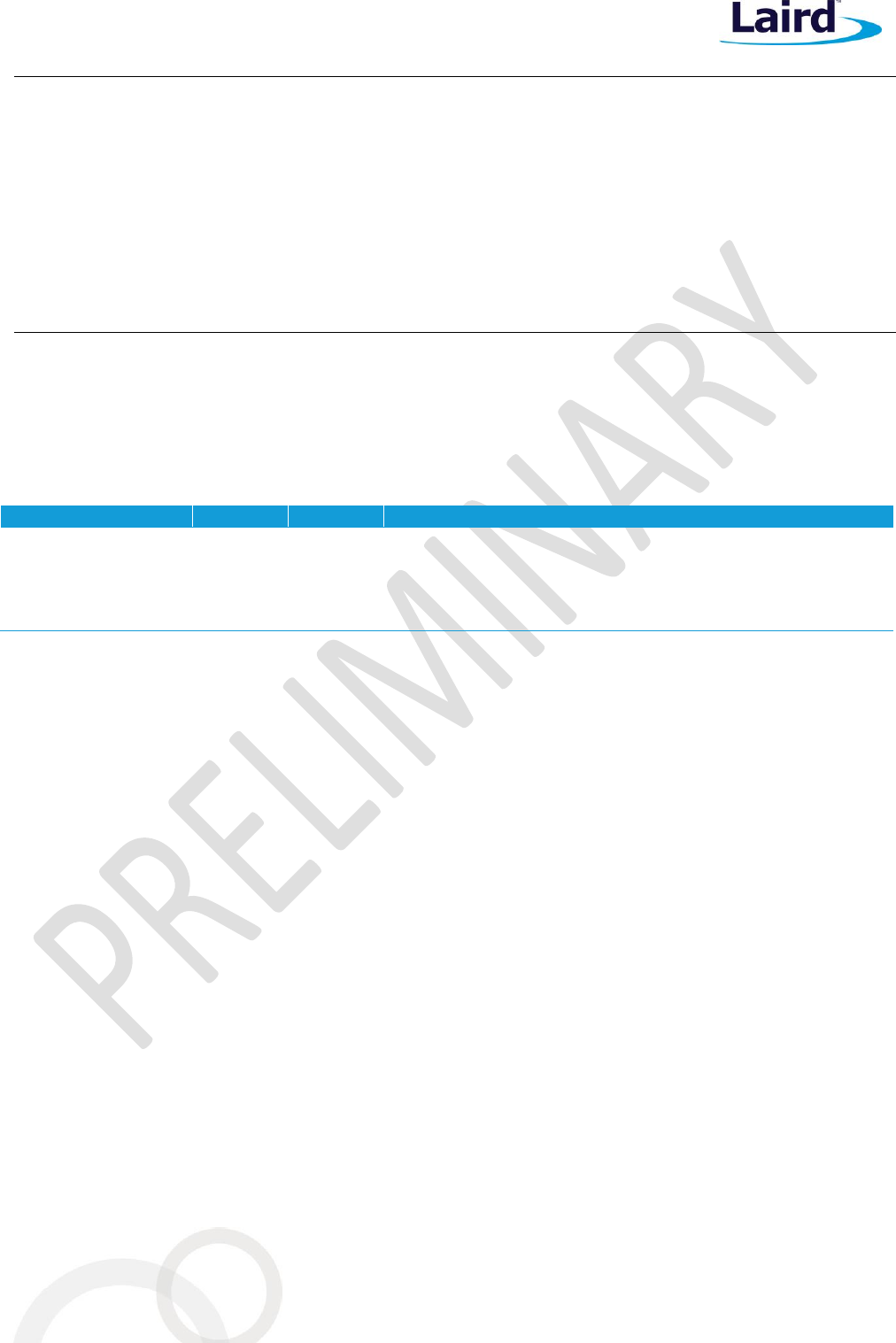
LoRa/BLE Modules
Hardware Integration Guide
Embedded Wireless Solutions Support Center:
http://ews-support.lairdtech.com
www.lairdtech.com/wireless
14
© Copyright 2016 Laird. All Rights Reserved
Americas: +1-800-492-2320
Europe: +44-1628-858-940
Hong Kong: +852 2923 0610
Note 1: Stay within internal 1.2 V reference voltage with given prescaling on AIN pin and do not violate ADC
maximum input voltage (for damage) for a given VCC, e.g. If VCC is 1.8 V can only expose AIN pin to
2.1 V (VCC+0.3).
Note 2: Currently, the smartBASIC runtime engine firmware only allows 10-bit mode.
Note 3: ADC input impedance is estimated mean impedance of the ADC (AIN) pins. The tolerance is +/-20%.
The ADC is highly sensitive to the impedance of the source. The ADC (AIN) input impedance is 200k-
600k depending on your ADC gain (pre-scaling) setting. Normally, when not sampling, the ADC (AIN)
impedance will have very high value and can consider it to be an open circuit. The moment ADC is
sampling, ADC(AIN) impedance is 200k-600k.
nAutoRUN Pin and Operating Modes
Operating modes (refer to the smartBASIC manual for details):
Self-contained mode
Interactive/Development mode
Table 7: nAutoRUN pin
Signal Name
Pin #
I/O
Comments
nAutoRUN (SIO_25)
6
I
Input with active low logic.
Operating mode selected by nAutoRun pin status:
If Low (0V), runs $autorun$ if it exists;
If High (VCC), runs via at+run (and “file name” of application).
Pin 40 (nAutoRUN) is an input, with active low logic. In the development board (DVK-RM1xx) it is connected so
that the state is driven by the host’s DTR output line. nAutoRUN pin needs to be externally held high or low to
select between the two RM1xx operating modes:
Self-contained Run mode (nAutoRUN pin held at 0V).
Interactive/Development mode (nAutoRUN pin held at VCC)
smartBASIC runtime engine firmware checks for the status of nAutoRUN during power-up or reset. If it is low
and if there is a smartBASIC application named $autorun$ then the smartBASIC runtime engine executes the
application automatically; hence the name self-contained run mode.
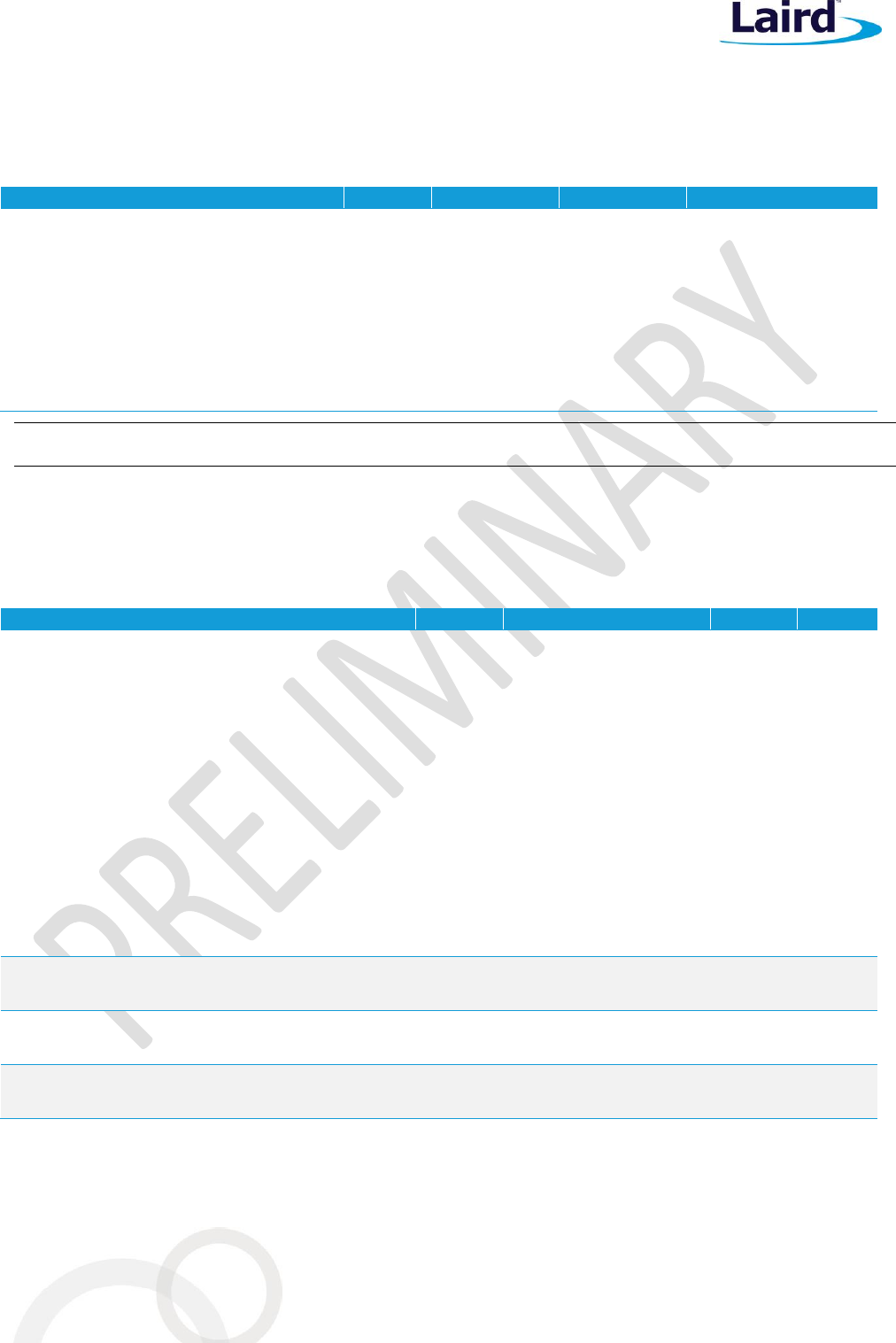
LoRa/BLE Modules
Hardware Integration Guide
Embedded Wireless Solutions Support Center:
http://ews-support.lairdtech.com
www.lairdtech.com/wireless
15
© Copyright 2016 Laird. All Rights Reserved
Americas: +1-800-492-2320
Europe: +44-1628-858-940
Hong Kong: +852 2923 0610
LORA POWER CONSUMPTION
Data taken at VCC 3.3V with DCDC converter ON (see Note1) at 25ºC. All peripherals turned off except for UART.
Table 8: Power consumption
Parameter
Min
Typical
Max
Unit
RM191 TX Currents
TX current @TXpwr= +15 dBm
TX current @TXpwr= 1 dBm
RM186 TX Currents
TX current @TXpwr= 13.5dBm
TX current @TXpwr= 1 dBm
RM1xx Receive Current
RX current
50
TBD
38
TBD
13
mA
mA
mA
mA
mA
Note 1: At VCC = 3.3V, the DCDC converter will be active.
BLE POWER CONSUMPTION
Data taken at VCC 3.3V (see Note1) and 25ºC.
Table 9: Power consumption
Parameter
Min
Typical
Max
Unit
Active Mode ‘peak’ current – (Note 1)
(Connection)
TX only run peak current @TXpwr= + 3 dBm
TX only run peak current @T pwr= 0 dBm
TX only run peak current @TXpwr= -4 dBm
TX only run peak current @TXpwr= -8 dBm
TX only run peak current @TXpwr= -12 dBm
TX only run peak current @TXpwr= -16 dBm
T X only run peak current @TXpwr= -20 dBm
TX Whisper Mode 1
TX only run peak current @TXpwr= -30 dBm
TX Whisper Mode 2
TX only run peak current @TXpwr= -55 dBm
11.6
8.4
7.1
6.9
6.4
6.1
5.5
5.4
5.0
mA
mA
mA
mA
mA
mA
mA
mA
mA
Active Mode
RX only ‘peak’ current
8.7
mA
Ultra Low Power Mode1 (Note 2)
Standby Doze
2.6
uA
Ultra Low Power Mode2 (Note 3)
Deep Sleep (no RAM retention)
600 (Note 4)
nA
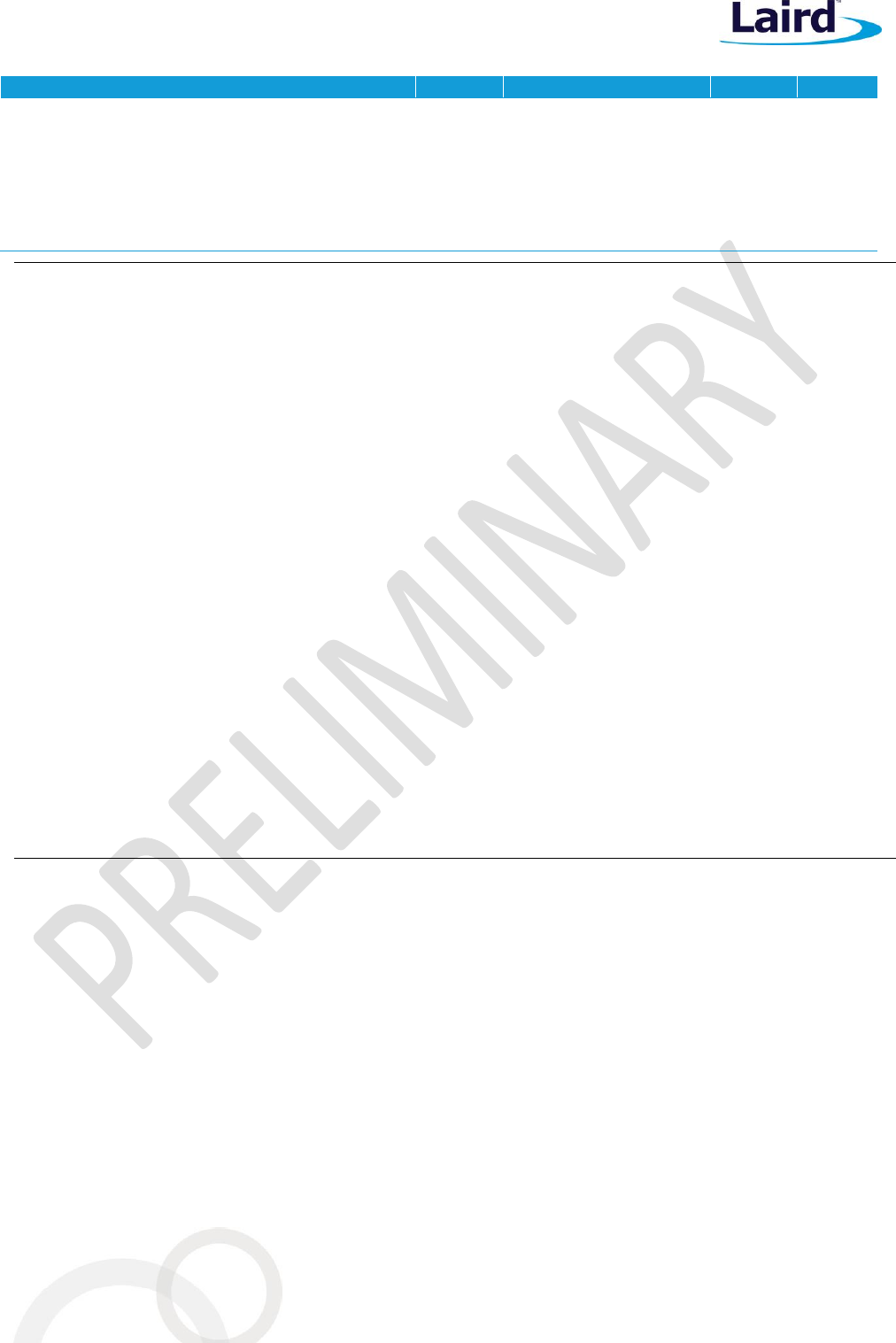
LoRa/BLE Modules
Hardware Integration Guide
Embedded Wireless Solutions Support Center:
http://ews-support.lairdtech.com
www.lairdtech.com/wireless
16
© Copyright 2016 Laird. All Rights Reserved
Americas: +1-800-492-2320
Europe: +44-1628-858-940
Hong Kong: +852 2923 0610
Parameter
Min
Typical
Max
Unit
Active Mode Average current (Note 4)
Connection Average Current draw
Max with connection interval (min) 7.5 mS
with connection interval 67.5 mS
Min with connection interval (max) 4000 mS
~400
~2.6-4.1
uA
uA
Note 1: If VCC reduces to 2.1V (operating range of DCDC), the peak current consumption would increase
from 11.6mA to ~15.5mA for TX power setting of +3dBm.
Note 2: RM1xx: Standby Doze current TBD typical. Standby Doze is entered automatically (when waitevent
statement is encountered within a smartBASIC application script). See individual peripherals current
consumption in tables in section Peripheral block current consumption 4.3.
Note 3: In Deep Sleep, everything is disabled and the only wake-up sources are reset and changes on pins on
which sense is enabled. A reset is required to exit Deep Sleep.
Note 4: Data taken with TX power 3 dBm and all peripherals off (UART OFF after radio event). Average
current consumption depends on a number of factors (including TX power, VCC and accuracy of 16
MHz and 32.768 kHz crystals). With these factors fixed, the largest variable is the connection
interval.
Connection Interval Range:
7.5 ms to 4000 ms in multiples of 1.25 ms.
For a connection event:
- The minimum average current consumption is when the connection interval is large 4000 mS
– The maximum average current consumption is with the shortest connection interval of 7.5 ms; no
slave latency.
Other factors that are also related to average current consumption include whether transmitting 6
packets per connection interval & each packet contains 20 bytes (which is the maximum for each
packet) and an inaccurate 32 kHz master clock accuracy would increase the average current
consumption.
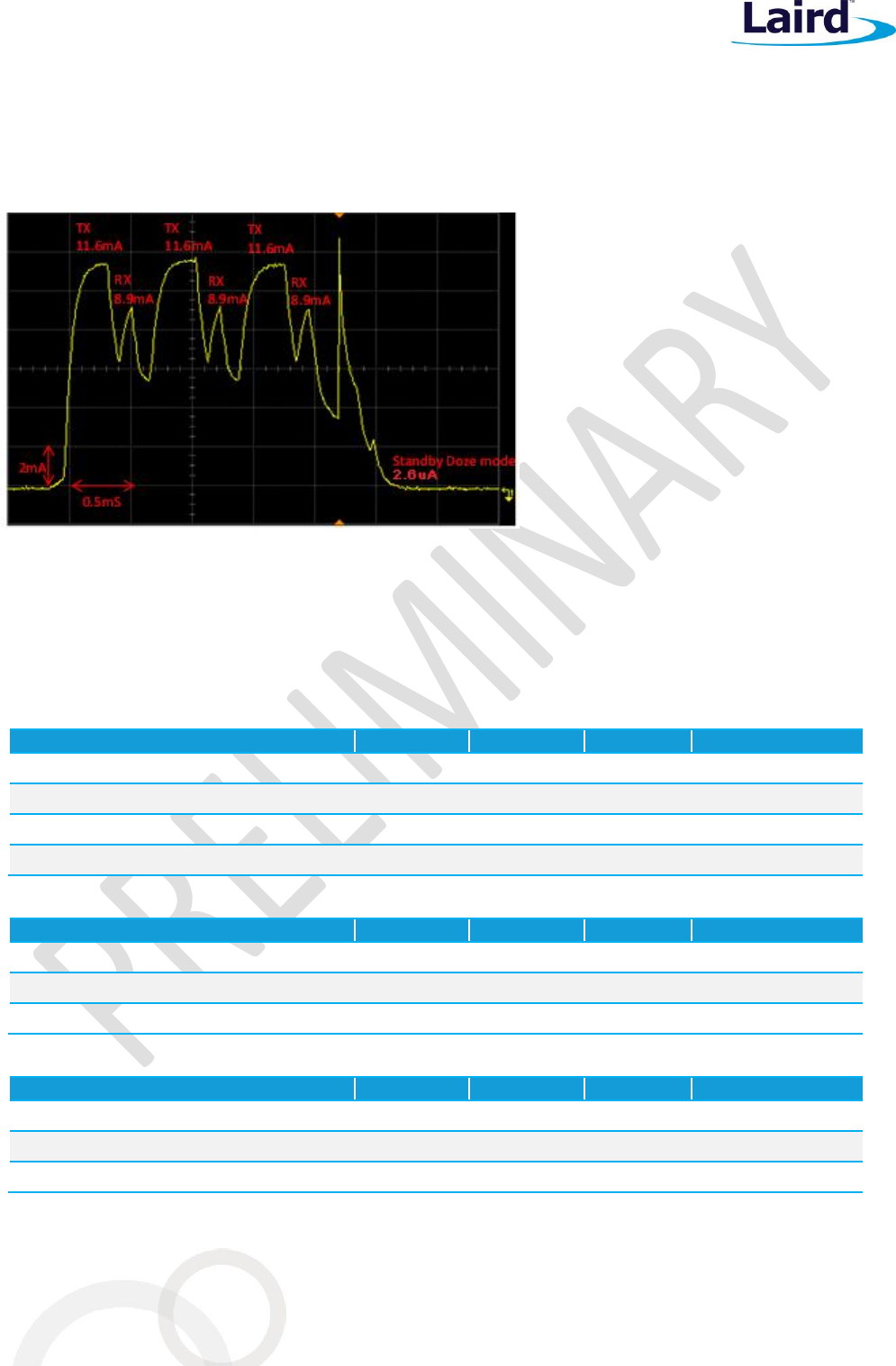
LoRa/BLE Modules
Hardware Integration Guide
Embedded Wireless Solutions Support Center:
http://ews-support.lairdtech.com
www.lairdtech.com/wireless
17
© Copyright 2016 Laird. All Rights Reserved
Americas: +1-800-492-2320
Europe: +44-1628-858-940
Hong Kong: +852 2923 0610
BLE Measured Peak Current Waveforms during Connection
The following figures illustrate BLE current waveforms observed as the RM1xx module performs during
connection functionality.
TBD: Update plot
Figure 3: Typical peak current consumption profile with TBD conditions
Note: In the above picture, UART is ON. X-axis time (1 mS per square), Y-axis current (2 mA per square).
Peripheral Block Current Consumption
The values below are calculated for a typical operating voltage of 3 V.
Table 10: UART Power Consumption
Parameter
Min
Typ
Max
Unit
UART Run current @ Max Baud Rate
230
uA
UART Run current @ 115200 bps
220
uA
UART Run current @ 1200 bps
210
uA
UART Baud rate
1200
460800
bps
Table 11: SPI Power Consumption
Parameter
Min
Typ
Max
Unit
SPI Master Run current @ 125 kbps
180
uA
SPI Master Run current @ 4 Mbps
200
uA
SPI bit rate
0.125
4
Mbps
Table 12: I2C Power Consumption
Parameter
Min
Typ
Max
Unit
I2C Run current @ 100 kbps
380
uA
I2C Run current @ 400 kbps
400
uA
I2C Bit rate
100
400
kbps
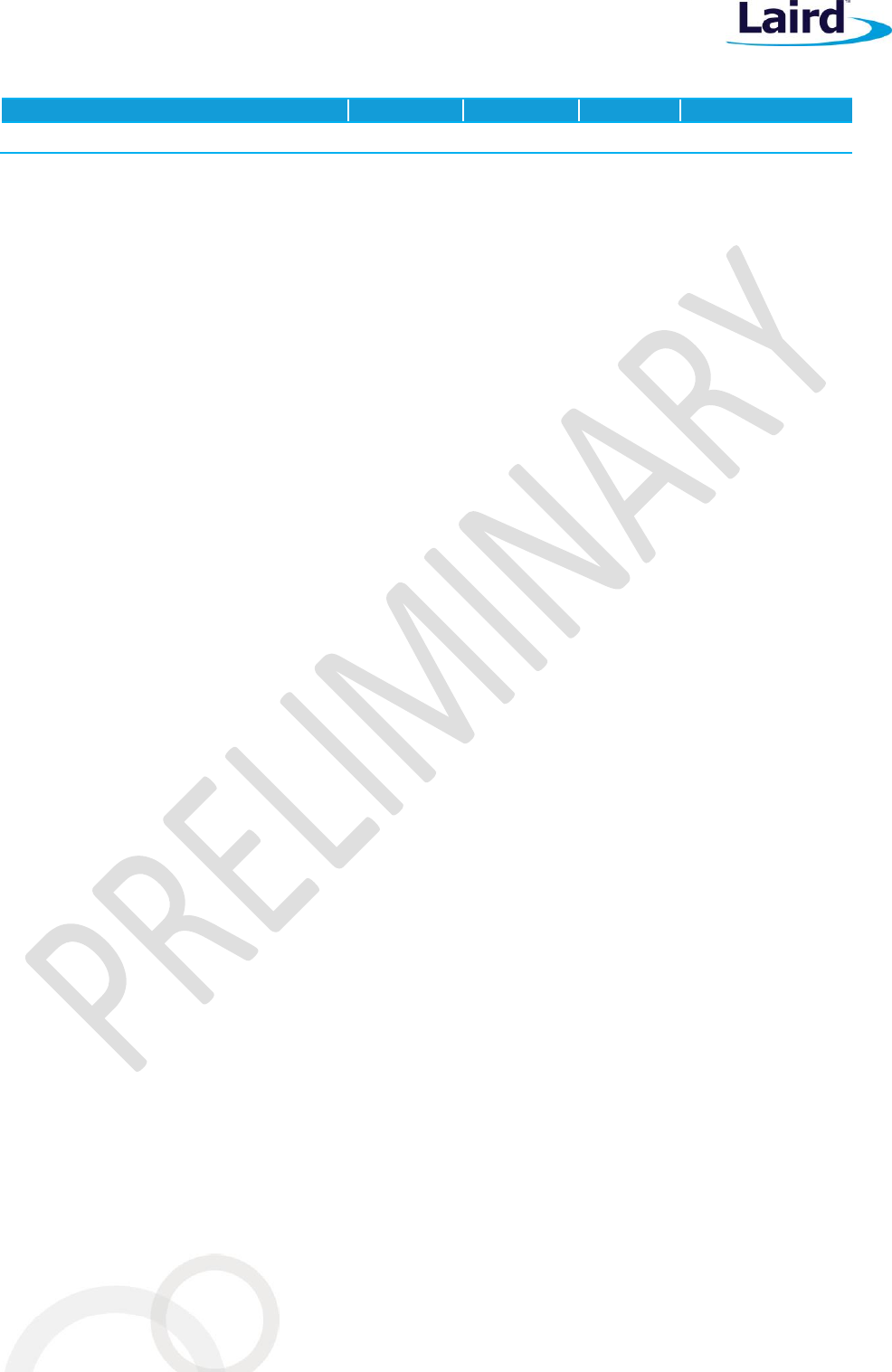
LoRa/BLE Modules
Hardware Integration Guide
Embedded Wireless Solutions Support Center:
http://ews-support.lairdtech.com
www.lairdtech.com/wireless
18
© Copyright 2016 Laird. All Rights Reserved
Americas: +1-800-492-2320
Europe: +44-1628-858-940
Hong Kong: +852 2923 0610
Table 13: ADC Power Consumption
Parameter
Min
Typ
Max
Unit
ADC current during conversion
260
uA
For asynchronous interface like the UART (asynchronous as the other end can communicate at any time), the
UART (on RM1xx) must kept open (by a command in smart BASIC application script) resulting in the base current
consumption penalty.
For synchronous interface like the I2C or SPI (since RM1xx side is the master), the interface can be closed and
opened only (by a command in smart BASIC application script) when needed, resulting in current saving (no base
current consumption penalty). Similar argument for ADC (open ADC when needed).
FUNCTIONAL DESCRIPTION
The RM1xx module is a self-contained LoRa/Bluetooth Low Energy product and requires only power and a user’s
smartBASIC application to implement full LoRa and BLE functionality. The LoRa radio in conjunction with its
external 2 dBi antenna implements a long range, low data rate connection to a LoRa gateway up to 15 km. The
integrated, high performance BLE antenna combined with the RF and base-band circuitry provides the Bluetooth
Low Energy wireless link to connect to local BLE sensors. The RM1xx SIO lines provide the OEM’s chosen
interface connection to the wired serial/SPI/I2C/analog sensors. The user’s smartBASIC application binds the
sensors to the LoRa and BLE wireless functionality.
The variety of hardware interfaces and the smartBASIC programming language allow the RM1xx module to serve
a wide range of wired/wireless applications, whilst reducing overall time to market and the learning curve for
developing LoRa and BLE products.
To provide the widest scope for integration a variety of physical host interfaces/sensors are provided. The major
RM1xx series module functional blocks described below.
Power Management (includes brown-out and power on reset)
Power management features:
System Standby Doze/Deep Sleep modes
Brownout Reset
Open/Close peripherals (UART, SPI, I2C, SIO’s and ADC). Peripherals consume current when open; each
peripheral can be individually closed to save power consumption (with a command in a smartBASIC
application script).
Two-region RAM retention (No RAM retention in Deep Sleep mode)
smartBASIC command allows the VCC voltage to be read (through the internal ADC)
Pin wake-up system from deep sleep
Power supply features:
Supervisor hardware to manage power on reset, brownout (and power fail).
1.8V to 3.5V supply range.
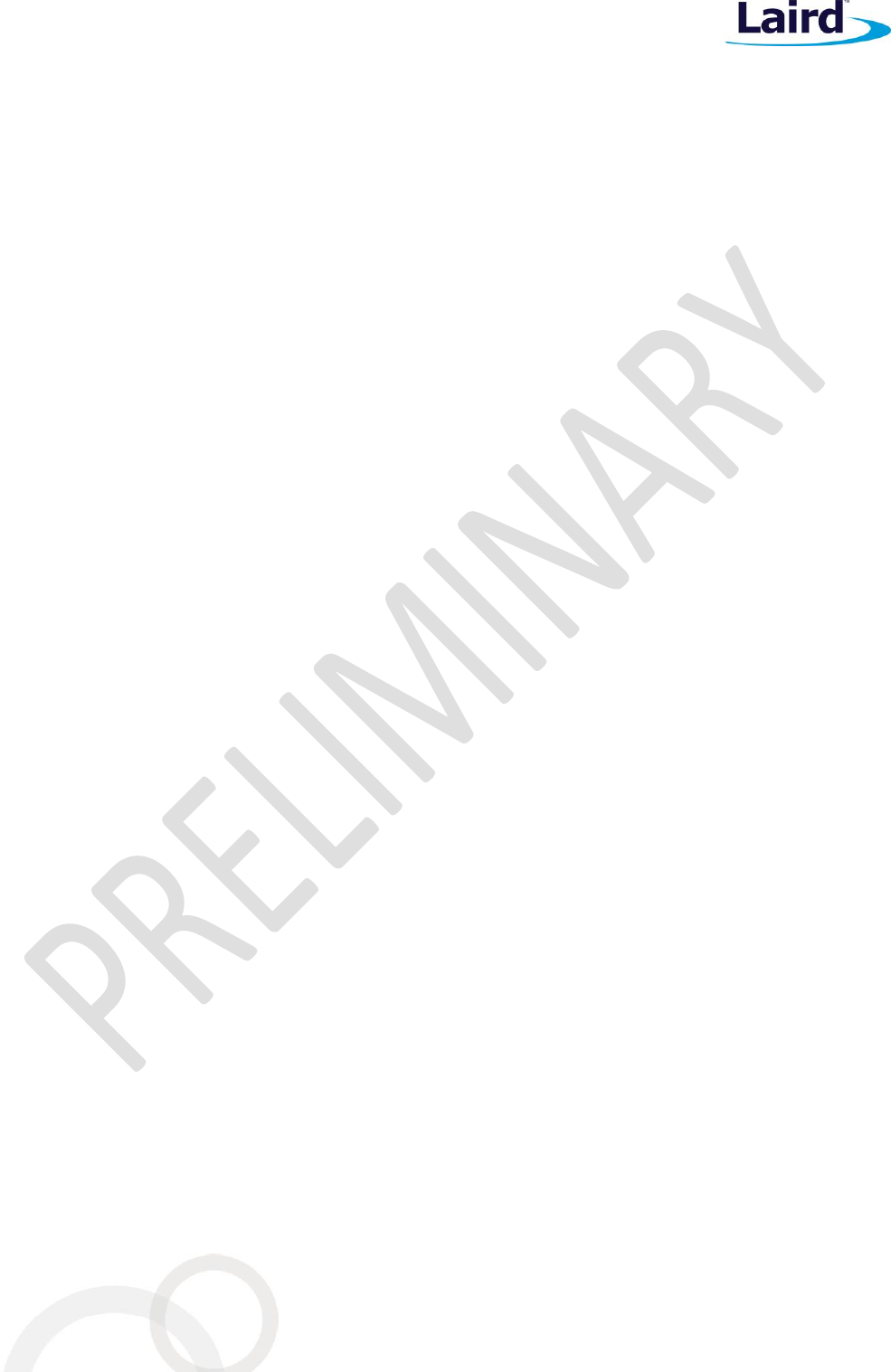
LoRa/BLE Modules
Hardware Integration Guide
Embedded Wireless Solutions Support Center:
http://ews-support.lairdtech.com
www.lairdtech.com/wireless
19
© Copyright 2016 Laird. All Rights Reserved
Americas: +1-800-492-2320
Europe: +44-1628-858-940
Hong Kong: +852 2923 0610
Clocks and Timers
Clocks
The integrated high accuracy (+/-20 ppm) 32.768 kHz crystal oscillator provides protocol timing and helps with
radio power consumption in the system Standby Doze/Deep sleep modes by reducing the time that the RX
window needs to be open. Standard accuracy clocks tend to have lower accuracy +/-250 ppm.
The integrated high accuracy 16 MHz (+/-10 ppm) crystal oscillator helps with radio operation and also helps
reduce power consumption in the active modes.
Timers
In keeping with the event-driven paradigm of smartBASIC, the timer subsystem enables smartBASIC applications
to be written which allow future events to be generated based on timeouts.
Regular Timer – There are eight built-in timers (regular timers) derived from a single RTC clock which are
controlled solely by smart BASIC functions. The resolution of the regular timer is 976 microseconds.
Tick Timer – A 31-bit free running counter that increments every 1 millisecond. The resolution of this
counter is 488 microseconds. This counter can be accessed using the functions GetTickCount() and
GetTickSince().
Refer to the smart BASIC user guide for more information.
Memory for smartBASIC Application Code
User has up to TBD Kbytes of data memory available for smart BASIC application script.
RF
865 – 870MHz (250 – 11000 bps over the air data rate)
RM186 protocol can optionally employs 50kbps FSK when enabled by the gateway
RM191 Lora radio: 902 – 928MHz (980 – 21900 bps over the air data rate)
Bluetooth Low Energy radio: 2402–2480MHz (1Mbps over the air data rate).
BLE TX output power of +3dBm programmable (via smartBASIC command) to -20dBm in steps of 4dB.
BLE TX Whisper mode1 -30dBm (via smartBASIC command).
BLE TX Whisper mode2 -55dBm (via smartBASIC command).
BLE Receiver (with integrated channel filters) to achieve maximum sensitivity -91dBm @ 1Mbps BLE.
BLE Antenna: Integrated monopole chip antenna on RM1xx
UART Interface
The Universal Asynchronous Receiver/Transmitter offers fast, full-duplex, asynchronous serial communication
with built-in flow control support (UART_CTS, UART_RTS) in HW. Parity checking is supported.
UART_TX, UART_RX, UART_RTS, and UART_CTS form a conventional asynchronous serial data port with
handshaking. The interface is designed to operate correctly when connected to other UART devices such as the
16550A. The signaling levels are CMOS logic levels that track VCC, and are inverted with respect to the signaling
on an RS232 cable.
Two-way hardware flow control is implemented by UART_RTS and UART_CTS. UART_RTS is an output and
UART_CTS is an input. Both are active low.

LoRa/BLE Modules
Hardware Integration Guide
Embedded Wireless Solutions Support Center:
http://ews-support.lairdtech.com
www.lairdtech.com/wireless
20
© Copyright 2016 Laird. All Rights Reserved
Americas: +1-800-492-2320
Europe: +44-1628-858-940
Hong Kong: +852 2923 0610
These signals operate according to normal industry convention. UART_RX, UART_TX, UART_CTS, UART_RTS are
all CMOS logic levels that track VCC. For example, when RX and TX are idle they sit at a high logic level (VCC).
Conversely for handshaking pins CTS, RTS at 0 V is treated as an assertion.
The module communicates with the customer application using the following signals (Figure 4):
Port /TXD of the application sends data to the module’s UART_RX signal line
Port /RXD of the application receives data from the module’s UART_TX signal line
Figure 4: UART Signals
Note: The RM1xx serial module output is at CMOS logic levels that track VCC. Level conversion must be
added to interface with an RS-232 level compliant interface.
Some serial implementations link CTS and RTS to remove the need for handshaking. Laird does not recommend
linking CTS and RTS other than for testing and prototyping. If these pins are linked and the host sends data at the
point that the RM1xx deasserts its RTS signal, then there is significant risk that internal receive buffers will
overflow, which could lead to an internal processor crash. This will drop the connection and may require a
power cycle to reset the module. Laird recommends that the correct CTS/RTS handshaking protocol be adhered
to for proper operation.
Table 14: UART Interface
Signal Name
Pin #
I/O
Comments
SIO_21/UART_TX
2
O
SIO_21 (alternative function UART_TX) is an output, set high (in FW).
SIO_22/UART_RX
3
I
SIO_22 (alternative function UART_RX) is an input, set with internal pull-
up (in FW).
SIO_23/UART_RTS
4
O
SIO_23 (alternative function UART_RTS) is an output, set low (in FW).
SIO_24/UART_CTS
5
I
SIO_24 (alternative function UART_CTS) is an input, set with internal pull-
down (in FW).
The UART interface is also used to load customer developed smartBASIC application script.
SPI Bus
The SPI interface is an alternate function on SIO pins, configurable by smartBASIC.
The module is a master device that uses terminals SPI_MOSI, SPI_MISO, and SPI_CLK. SPI_CSB is implemented
using any spare SIO digital output pins to allow for multi-dropping.
The SPI interface enables full duplex synchronous communication between devices. It supports a three-wire
(SPI_MOSI, SPI_MISO, SPI_SCK,) bidirectional bus with fast data transfers to and from multiple slaves. Individual
chip select signals are necessary for each of the slave devices attached to a bus, but control of these is left to the
application through use of SIO signals. I/O data is double buffered.
The SPI peripheral supports SPI mode 0, 1, 2, and 3.
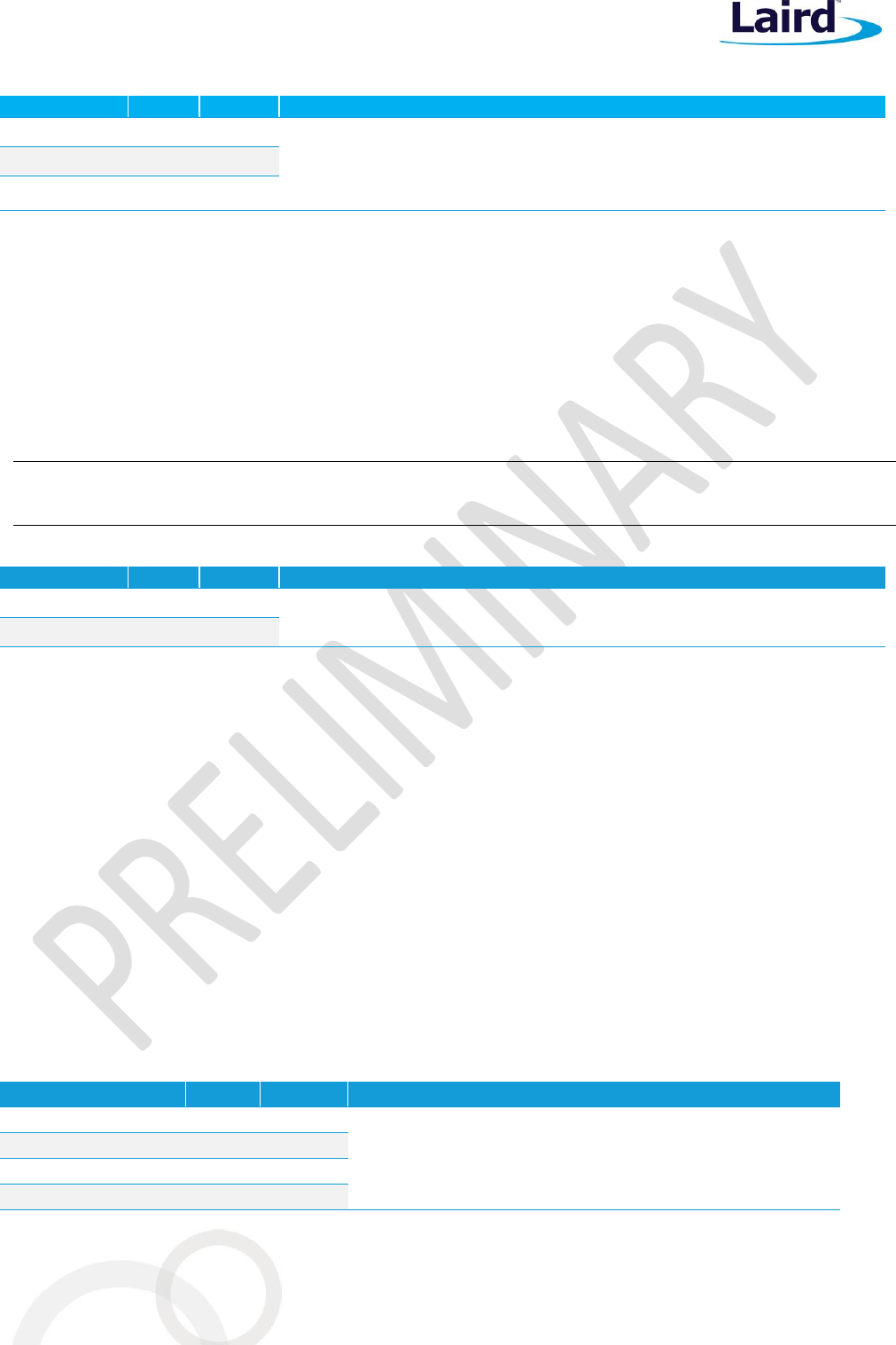
LoRa/BLE Modules
Hardware Integration Guide
Embedded Wireless Solutions Support Center:
http://ews-support.lairdtech.com
www.lairdtech.com/wireless
21
© Copyright 2016 Laird. All Rights Reserved
Americas: +1-800-492-2320
Europe: +44-1628-858-940
Hong Kong: +852 2923 0610
Table 15: Peripheral supports
Signal Name
Pin #
I/O
Comments
SPI_MOSI
17
O
This interface is an alternate function configurable by
smart BASIC. Default in the FW pin 15 and 17 are inputs. SPIOPEN() in
smart BASIC selects SPI function and changes pin14 and 16 to outputs
(when in SPI master mode).
SPI_MISO
16
I
SPI_CLK
15
O
I2C Interface
The I2C interface is an alternate function on SIO pins, configurable by smart BASIC command.
The two-wire interface can interface a bi-directional wired-OR bus with two lines (SCL, SDA) and has master
/slave topology. The interface is capable of clock stretching. Data rates of 100 kbps and 400 kbps are supported.
An I2C interface allows multiple masters and slaves to communicate over a shared wired-OR type bus consisting
two lines which normally sit at VCC. The RM1xx module can only be configured as an I2C master with additional
constraint that it be the only master on the bus. The SCL is the clock line which is always sourced by the master
and SDA is a bi-directional data line which can be driven by any device on the bus.
IMPORTANT: It is essential to remember that pull-up resistors on both SCL and SDA lines are not provided
in the module and MUST be provided external to the module.
Table 16: I2C Interface
Signal Name
Pin #
I/O
Comments
I2C_SDA
10
I/O
This interface is an alternate function on each pin, configurable by
smartBASIC. I2COPEN() in smartBASIC selects I2C function.
I2C_SCL
9
I/O
General Purpose I/O, ADC and PWM/FREQ
GPIO
All SIO pins are configurable by smartBASIC. They can be accessed individually. Each has the following user
configured features:
Input/output direction
Output drive strength (standard drive 0.5mA or high drive 5mA)
Internal pull up and pull down resistors (13K typical) or no pull-up/down
Wake-up from high or low level triggers on all pins
ADC
The ADC is an alternate function on four select SIO pins, configurable by smart BASIC. This enables sampling up
to four external signals via an internal MUX to the 10 bit ADC. The ADC has configurable input pre-scaling and
sample resolution.
Analog Interface (ADC)
Table 17: Analog interface
Signal Name
Pin No
I/O
Comments
AIN – Analog Input
17
I
This interface is an alternate function on each pin,
configurable by smartBASIC. AIN configuration selected
using GpioSetFunc() function.
10 bit resolution. Voltage scaling 1/1, 2/3, 1/3.
AIN – Analog Input
18
I
AIN – Analog Input
19
I
AIN – Analog Input
20
I
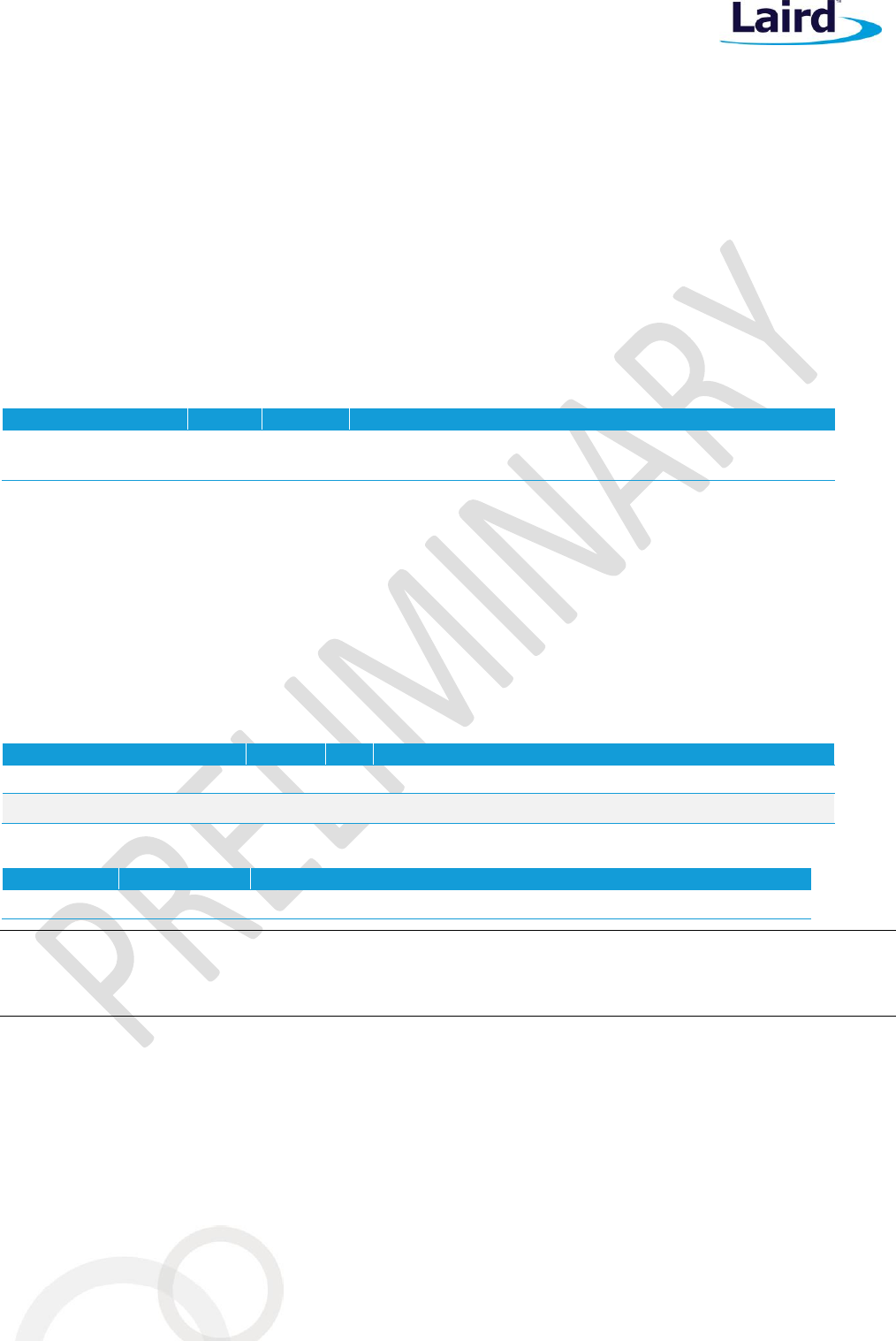
LoRa/BLE Modules
Hardware Integration Guide
Embedded Wireless Solutions Support Center:
http://ews-support.lairdtech.com
www.lairdtech.com/wireless
22
© Copyright 2016 Laird. All Rights Reserved
Americas: +1-800-492-2320
Europe: +44-1628-858-940
Hong Kong: +852 2923 0610
PWM and FREQ Signal Output on up to Two SIO Pins
The PWM and FREQ output is an alternate function on SIO pins, configurable by smart BASIC.
The ability to output a PWM (Pulse Width Modulated) signal or FREQ output signal on up to 2 GPIO (SIO) output
pins can be selected using GpioSetFunc() function.
PWM output signal has a frequency and duty cycle property. PWM output is generated using 32-bit hardware
timers. The timers are clocked by a 1MHz clock source. Frequency is adjustable (up to 1 MHz) and the Duty
cycle can be set over range from 0% to 100% (both configurable by smart BASIC command). Note, the frequency
driving each of the 2 SIO pins is the same but the duty cycle can be independently set for each pin.
FREQ output signal frequency can be set over a range of 0Hz to 4MHz (with 50% mark-space ratio).
nRESET Pin
Table 18: nRESET pin
Signal Name
Pin No
I/O
Comments
nRESET
22
I
HW reset (active low). Pull the nRESET pin low for
minimum 100mS in order for the RM1xx to reset.
nAutoRUN Pin
Refer to section nAutoRUN pin and Operating Modes regarding operating modes and the nAutoRUN pin.
Self-contained Run mode
Interactive / Development mode
Two-Wire SWD Programming/Debug Interface
Customers have the option to use the 2-wire (SWD Programming/Debug) interface, during production, to clone
the file system of a Golden preconfigured RM1xx to others using the Flash Cloning process described in the app
note: TBD
Signal Name (hidden name)
Pin No
I/O
Comments
nRESET (SWDIO)
22
I/O
NC (SWDCLK)
23
I
The connector for the (2-Wire SWD Programming/Debug Interface) MPN is as follows:
Reference
Part
Description
JP1 Note1
FTSH-105
Header, 1.27mm, SMD, 10-way, FTSH-105-01-L-DV Samtec
Note 1: Reference the RM1xx development board schematic. Figure 5 shows the wiring for the 2-Wire SWD
Programming/Debug Interface connector and RM1xx module hidden 2-Wire SWD
Programming/Debug Interface pins.
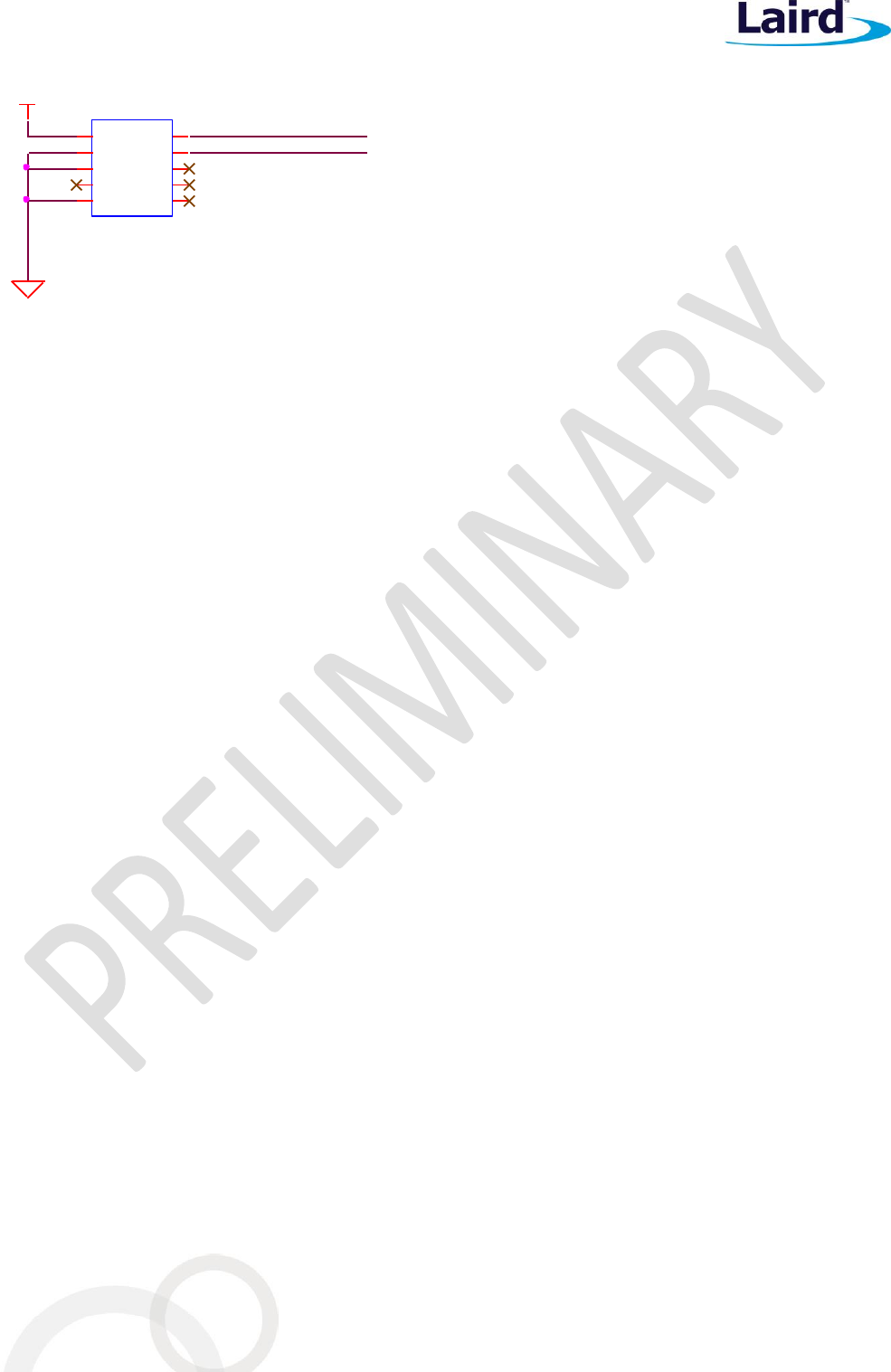
LoRa/BLE Modules
Hardware Integration Guide
Embedded Wireless Solutions Support Center:
http://ews-support.lairdtech.com
www.lairdtech.com/wireless
23
© Copyright 2016 Laird. All Rights Reserved
Americas: +1-800-492-2320
Europe: +44-1628-858-940
Hong Kong: +852 2923 0610
Figure 5: Wiring for 2-Wire SWD Programming/Debug Interface connector to SWD Programming/Debug interface on RM1xx module
RM1xx on-board chip antenna characteristics
The RM1xx on-board chip monopole antenna radiated performance depends on the host PCB layout.
RM1xx development board was used for RM1xx development and antenna performance evaluation. To obtain
similar performance follow guidelines in section PCB Layout on Host PCB for RM1xx to allow the on-board
antenna to radiate and reduce proximity effects due to nearby host PCB GND copper or metal covers.
RM1xx on-board antenna part number: ACX: AT5020-E3R0HBANT/LF
HARDWARE INTEGRATION SUGGESTIONS
Circuit
The RM1xx-series module is easy to integrate requiring no external components on the customer’s board apart
from those required by customer for development and in customers end application.
Checklist (for Schematic):
VCC
External power source within the operating range, rise time and noise/ripple specification of RM1xx.
Add decoupling capacitors for filtering the external source. Power-on reset circuitry within RM1xx series
module incorporates brown-out detector, thus simplifying power supply design. Upon application of
power, the internal power-on reset ensures module starts correctly.
AIN (ADC) and SIO pin IO voltage levels
RM1xx SIO operating voltage levels are from 0V to VCC. Ensure input voltage levels into SIO do not exceed
VCC also (if VCC source is a battery whose voltage will drop). Ensure ADC pin maximum inpu voltage for
damage is not violated.
AIN (ADC) impedance and external voltage divider setup
If one wanted to measure with ADC, a voltage higher than 3.6V then one can connect a high impedance
voltage divider to lower the voltage to the ADC input pin. Other methods are to use a voltage buffer or
FET transistor in conjunction with a low resistance voltage divider.
High impedance values of a voltage divider connected to an AIN pin will introduce ADC inaccuracy. Laird
recommends the following solution for setup of a voltage divider when used with the RM1xx ADC:
– Connect a capacitor between AIN and ground (if the voltage divider presents high impedance).
Normally, when ADC is not sampling, the ADC (AIN) impedance is a very high value and can be
considered an open circuit. The moment ADC is sampling, ADC (AIN) impedance is 200k-600k and
JP1
FTSH-105
1 2
3 4
5 6
7 8
910
SWDCLK
VCC_IO
nRESET/SWDIO
GND
(RM1xx Pin 22)
(RM1xx Pin 23)

LoRa/BLE Modules
Hardware Integration Guide
Embedded Wireless Solutions Support Center:
http://ews-support.lairdtech.com
www.lairdtech.com/wireless
24
© Copyright 2016 Laird. All Rights Reserved
Americas: +1-800-492-2320
Europe: +44-1628-858-940
Hong Kong: +852 2923 0610
lowers the AIN voltage. However, when the capacitor is connected it should keep the AIN voltage at
previous level for an adequate time period while sampling, minimizing the effect of the high
resistance value of the external voltage divider. The capacitor should be big enough to hold voltage
up for the required time period, i.e. 20 us for 8 bit sampling or 68 us for 10 bit sampling. If you use a
FET transistor to open the current flow through the circuit momentarily before sampling, allow
enough time for the capacitor to fully charge before sampling. During the sampling period, multiple
samples are made and the ADC output value is the mean value from the sample pool. The sample
pool is created during 20 us period for 8 bit sampling, 36 us period for 9 bit sampling, and 68 bit
period for 10 bit sampling.
Two-Wire SWD Programming/Debug Interface
Required if Flash Cloning will be used during production to load RM1xx smartBASIC application and/or
the firmware, add 2-Wire SWD Programming/Debug Interface as detailed in section 2-Wire SWD
Programming/Debug Interface
UART
Required for loading customer smartBASIC application and firmware. Add connector to allow UART to
be interfaced to PC (via UART –RS232 or UART- USB).
UART_RX and UART_CTS
SIO_22 (alternative function UART_RX) is an input, set with internal weak pull-up (in FW). The pull-up
prevents the module from going into deep sleep when UART_RX line is idling.
SIO_24 (alternative function UART_CTS) is an input, set with internal weak pull-down (in FW). This pull-
down ensures the default state of the UART_CTS will be asserted which means can send data out of the
UART_TX line. In the case when UART_CTS is not connected (which we do not recommend).
nAutoRUN pin and operating mode selection
nAutoRUN pin needs to be externally held high or low to select between the two RM1xx operating
modes at power-up:
– Self-contained Run mode (nAutoRUN pin held at 0V).
– Interactive/development mode (nAutoRUN pin held at VCC).
Make provision to allow operation in the required mode. Add jumper to allow nAutoRUN pin to be held
high or low (via 10K resistor) OR driven by host GPIO.
I2C
It is essential to remember that pull-up resistors on both I2C_SCL and I2C_SDA lines are not provided in
the RM1xx module and MUST be provided external to the module as per I2C standard.
SPI
Implement SPI chip select using any unused SIO pin within your smartBASIC application script then
SPI_CS is controlled from smartBASIC application allowing multi-dropping.
SIO pin direction
RM1xx modules shipped from production with smart BASIC runtime engine FW, all SIO pins (with
“default function” of “DIO”) are mostly digital inputs (see Pin Definitions Table2). Use your smart BASIC
application script to change the direction of any SIO pin that is required to be an output in your design.
Also these SIO pins that are inputs have by default (in FW) an internal pull-up or pull-down resistor-
enabled (see Pin Definitions Table2). This was done to avoid floating inputs (which can also cause
current consumption in low power modes (e.g. StandbyDoze) to drift with time. In any case customer
can disable the PULL-UP through their smart BASIC application.
nRESET pin (active low)
Hardware reset. Wire out to push button or drive by host.
By default module is out of reset when power applied to VCC pin.
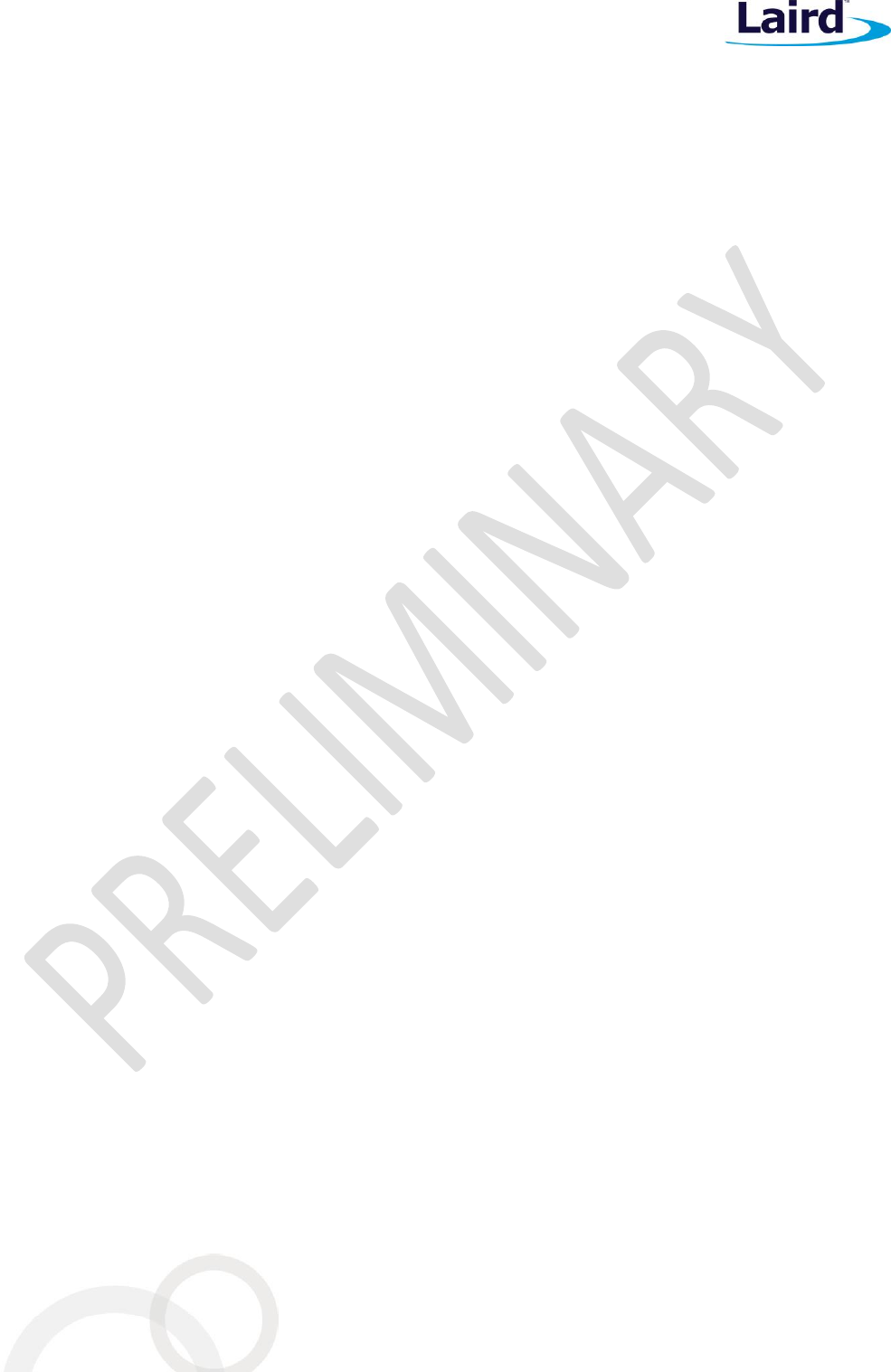
LoRa/BLE Modules
Hardware Integration Guide
Embedded Wireless Solutions Support Center:
http://ews-support.lairdtech.com
www.lairdtech.com/wireless
25
© Copyright 2016 Laird. All Rights Reserved
Americas: +1-800-492-2320
Europe: +44-1628-858-940
Hong Kong: +852 2923 0610
PCB Layout on Host PCB - General
Checklist (for PCB):
MUST locate RM1xx module close to the edge of PCB (mandatory for RM1xx for on-board chip antenna
to radiate properly).
Use solid GND plane on inner layer (for best EMC and RF performance).
All module GND pins MUST be connected to host PCB GND.
Place GND vias close to module GND pads as possible.
Unused PCB area on surface layer can be flooded with copper but place GND vias regularly to connect
copper flood to inner GND plane. If GND flood copper exists on the top PCB layer (under of the RM1xx
module), then connect with GND vias to inner GND plane and ensure that it is covered with solder mask.
Route traces to avoid noise being picked up on VCC supply and AIN (analogue) and SIO (digital) traces.
Ensure no exposed copper beneath the module (refer to land pattern of RM1xx development board).
Antenna Keep-out on Host PCB
Ensure there is no copper in the antenna keep-out area on any layers of the host PCB. Keep all mounting
hardware and metal clear of the area to allow proper antenna radiation.
For best antenna performance, place the RM1xx module on the edge of the host PCB, preferably in the
corner with the antenna facing the corner.
The RM1xx development board has the RM1xx module on the edge of the board (not in the corner).
The antenna keep-out area is defined by the RM1xx development board which was used for module
development and antenna performance evaluation is shown in Figure 6, where the antenna keep-out
area is composed of PCB dielectric (no copper) sitting under the RM1xx antenna.
A different host PCB thickness dielectric will have small effect on antenna.
The antenna-keep-out defined in Host PCB Land Pattern and Antenna Keepout applies when the RM1xx
is placed in the corner of the host PCB. When RM1xx-SM cannot be placed as such, it must be placed on
the edge of the host PCB and the antenna keep out must be observed. An example is shown in Figure 6.
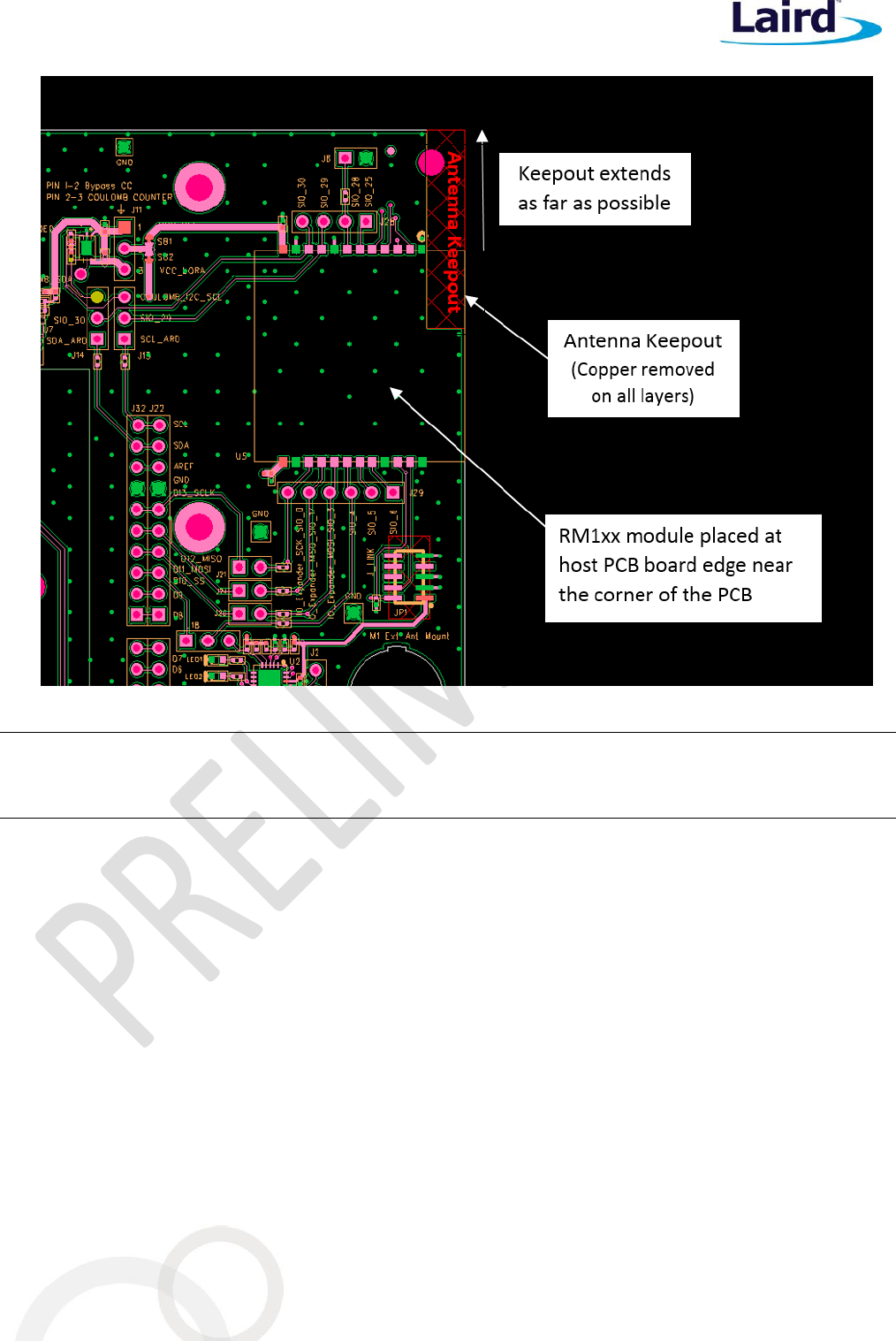
LoRa/BLE Modules
Hardware Integration Guide
Embedded Wireless Solutions Support Center:
http://ews-support.lairdtech.com
www.lairdtech.com/wireless
26
© Copyright 2016 Laird. All Rights Reserved
Americas: +1-800-492-2320
Europe: +44-1628-858-940
Hong Kong: +852 2923 0610
Figure 6: Antenna keepout on DVK-RM1xx PCB (shown in red) with RM1xx module placed near the corner.
Note: 1. RM1xx module placed on edge of host PCB (close to the corner of the PCB).
2. Copper cut-away on all layers in “antenna Keep-out” for a host PCB.
Antenna Keep-out and Proximity to Metal or Plastic
Checklist (for metal /plastic enclosure):
Minimum safe distance for metals without seriously compromising the antenna (tuning) is 40mm
top/bottom and 30mm left or right.
Metal close to the RM1xx chip monopole antenna (bottom, top, left, right, any direction) will have
degradation on the antenna performance. How much; that is entirely system dependent which means
some testing by customer required (in their host application).
Anything metal closer than 20mm will start to significantly degrade performance (S11, gain, radiation
efficiency).
It is best that the customer tests the Range with mock-up (or actual prototype) of the product to assess
effects of enclosure height (and material whether metal or plastic).
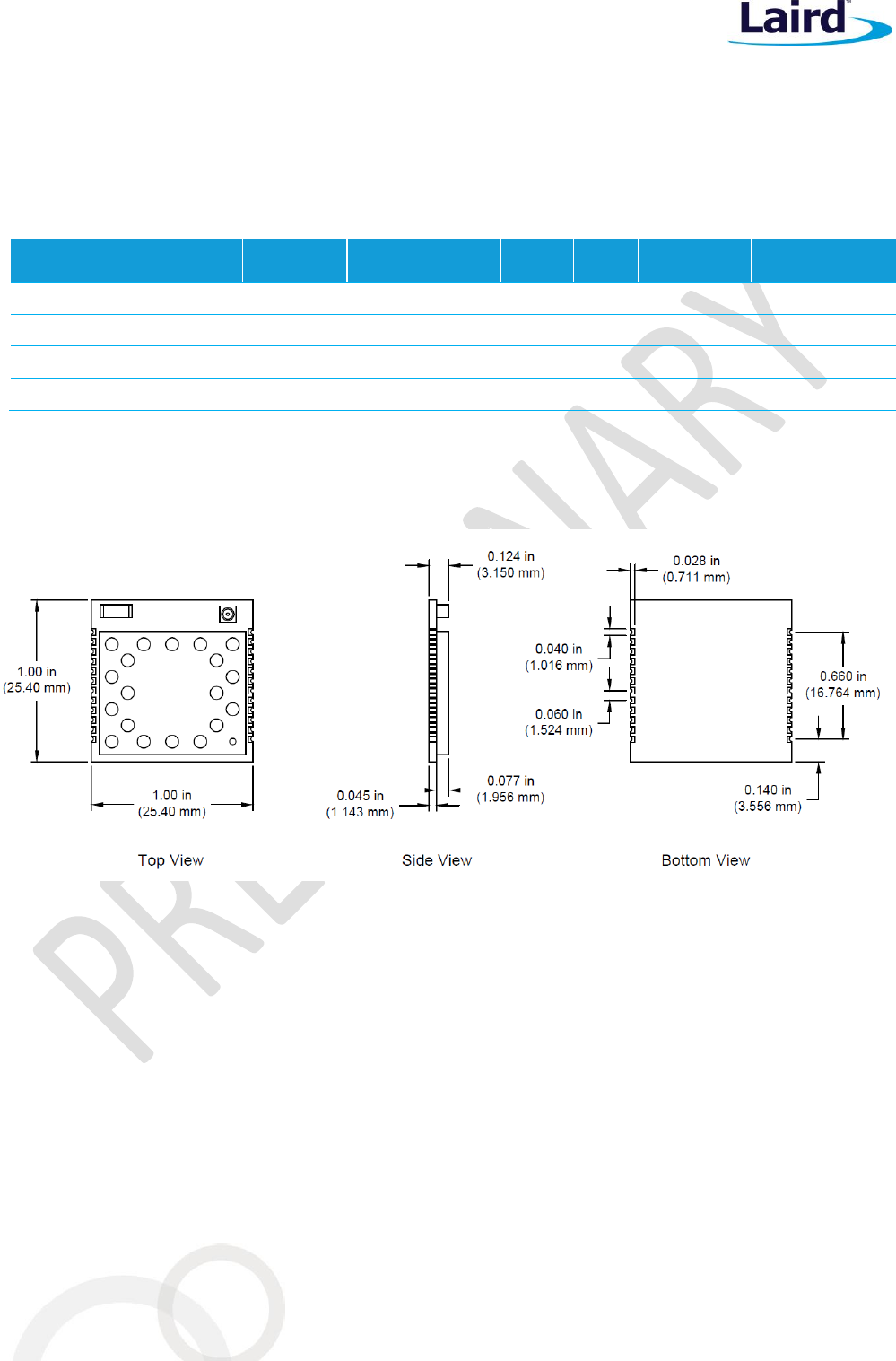
LoRa/BLE Modules
Hardware Integration Guide
Embedded Wireless Solutions Support Center:
http://ews-support.lairdtech.com
www.lairdtech.com/wireless
27
© Copyright 2016 Laird. All Rights Reserved
Americas: +1-800-492-2320
Europe: +44-1628-858-940
Hong Kong: +852 2923 0610
LoRa External Antenna Integration with RM1xx
Please refer to the regulatory sections for FCC/IC, and CE, for details of use of RM1xx with external antennas.
The RM1xx has been designed to operate with the below external antennas (with a maximum gain of 2dBi). The
required antenna impedance is 50 ohms. See Table 19.
Table 19: LoRa External antennas for the RM1xx
External Antenna Part
Number
Laird Part
Number
Mfg.
Type
Gain
(dBi)
Connector
Type
RM1xx Part
number
RFDPA131015IMBB301
TBD
Walsin
Dipole
0.9
U.FL
RM191/RM186
WPANTDP036-R5A
-
World Products
Dipole
2.0
U.FL
RM191/RM186
S152CL-L-PX-915S
-
Nearson
Dipole
2.0
U.FL
RM191
S152CL-L-PX-868S
-
Nearson
Dipole
2.0
U.FL
RM186
MECHANICAL DETAILS
RM1xx Mechanical Details
Figure 7: RM1xx Mechanical drawings
Development Kit Schematics can be found in the Documentation tab of the RM1xx product page:
www.lairdtech.com/products/rm1xx-lora-modules
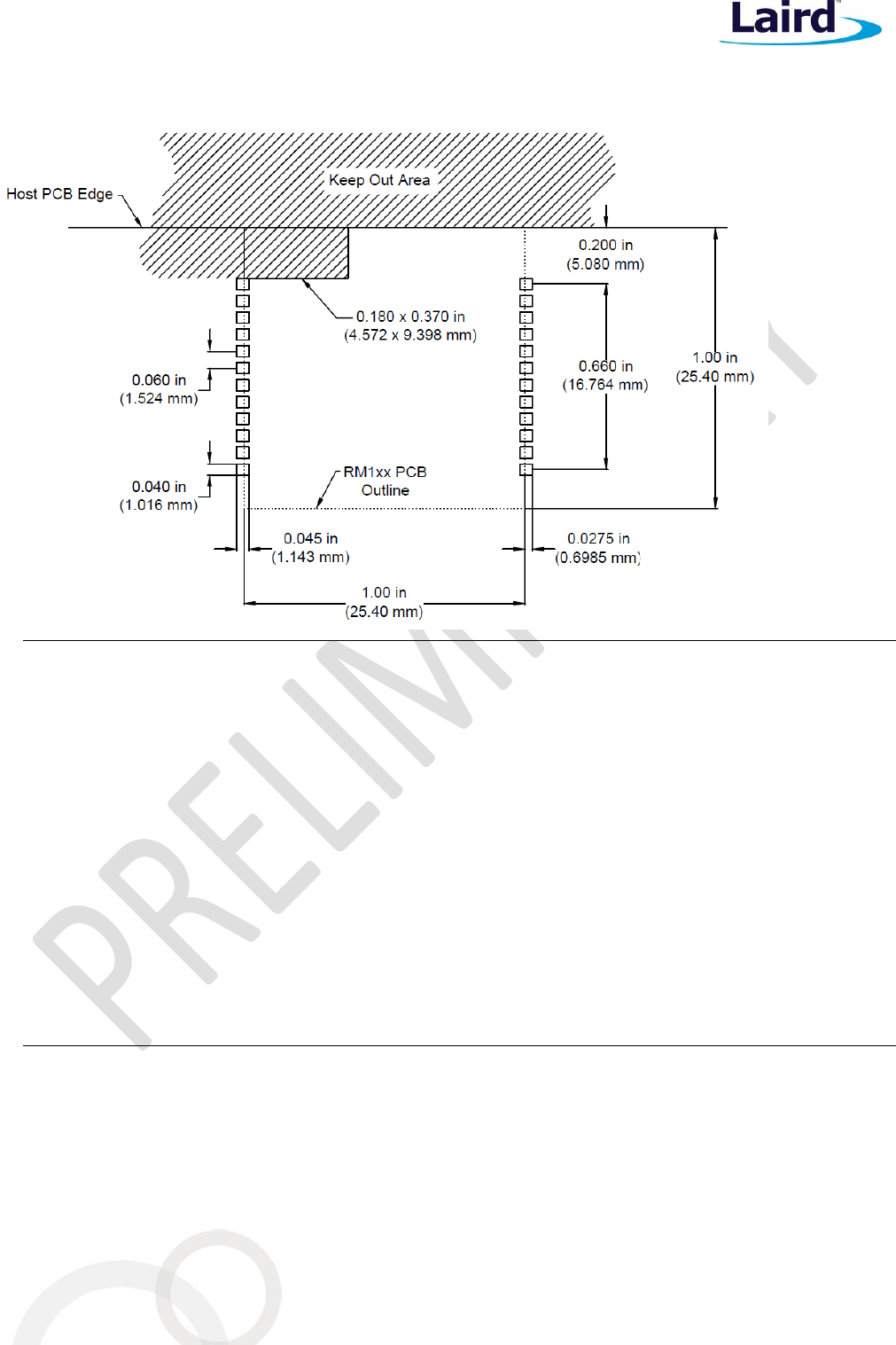
LoRa/BLE Modules
Hardware Integration Guide
Embedded Wireless Solutions Support Center:
http://ews-support.lairdtech.com
www.lairdtech.com/wireless
28
© Copyright 2016 Laird. All Rights Reserved
Americas: +1-800-492-2320
Europe: +44-1628-858-940
Hong Kong: +852 2923 0610
Host PCB Land Pattern and Antenna Keep-out for RM1xx
Application Notes
1. Ensure there is no copper in the antenna ‘keep out area’ on any layers of the host PCB. Also keep all
mounting hardware or any metal clear (Refer to 0) on of the area to reduce effects of proximity
detuning the antenna and to help antenna radiate properly.
3. For best BLE chip antenna performance, the module MUST be placed on the edge of the host PCB
(preferably in the corner) with the antenna facing the corner. If RM1xx is not placed in corner, but on
edge of host PCB, the antenna “Keep Out Area” is extended (see Note 4).
4. RM1xx development board has an RM1xx placed on the edge of the PCB board (and not in corner) the
Antenna keep out area is extended out to the corner of the development board, see section PCB Layout
on Host PCB - General. This was used for module development and antenna performance evaluation.
5. Ensure no exposed copper under module on host PCB.
6. The user may modify the PCB land pattern dimensions based on their experience and / or process
capability.
APPLICATION NOTE FOR SURFACE MOUNT MODULES
Introduction
Laird Technologies surface mount modules are designed to conform to all major manufacturing guidelines. This
application note is intended to provide additional guidance beyond the information that is presented in the User
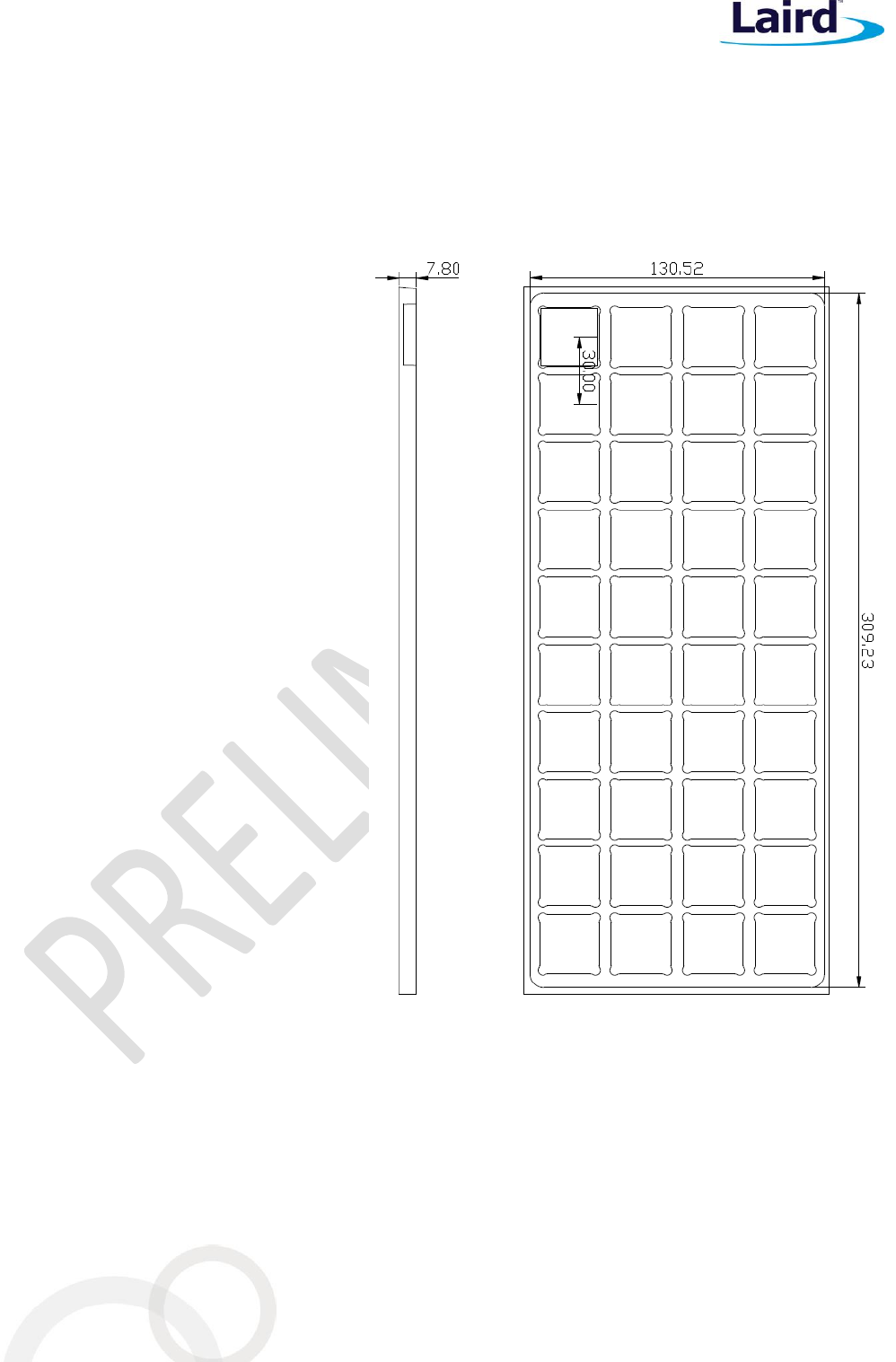
LoRa/BLE Modules
Hardware Integration Guide
Embedded Wireless Solutions Support Center:
http://ews-support.lairdtech.com
www.lairdtech.com/wireless
29
© Copyright 2016 Laird. All Rights Reserved
Americas: +1-800-492-2320
Europe: +44-1628-858-940
Hong Kong: +852 2923 0610
Manual. This Application Note is considered a living document and will be updated as new information is
presented.
The modules are designed to meet the needs of a number of commercial and industrial applications. They are
easy to manufacture and conform to current automated manufacturing processes.
Shipping
Figure 8: RM1xx Shipping Tray Details
Reflow Parameters
Prior to any reflow, it is important to ensure the modules were packaged to prevent moisture absorption. New
packages contain desiccate (to absorb moisture) and a humidity indicator card to display the level maintained
during storage and shipment. If directed to bake units on the card, see Table 20 and follow instructions specified
by IPC/JEDEC J-STD-033. A copy of this standard is available from the JEDEC website:
http://www.jedec.org/sites/default/files/docs/jstd033b01.pdf
Modules are shipped in ESD (Electrostatic
Discharge) safe trays that can be loaded
into most manufacturers pick and place
machines. Layouts of the trays are
provided in Figure 8.
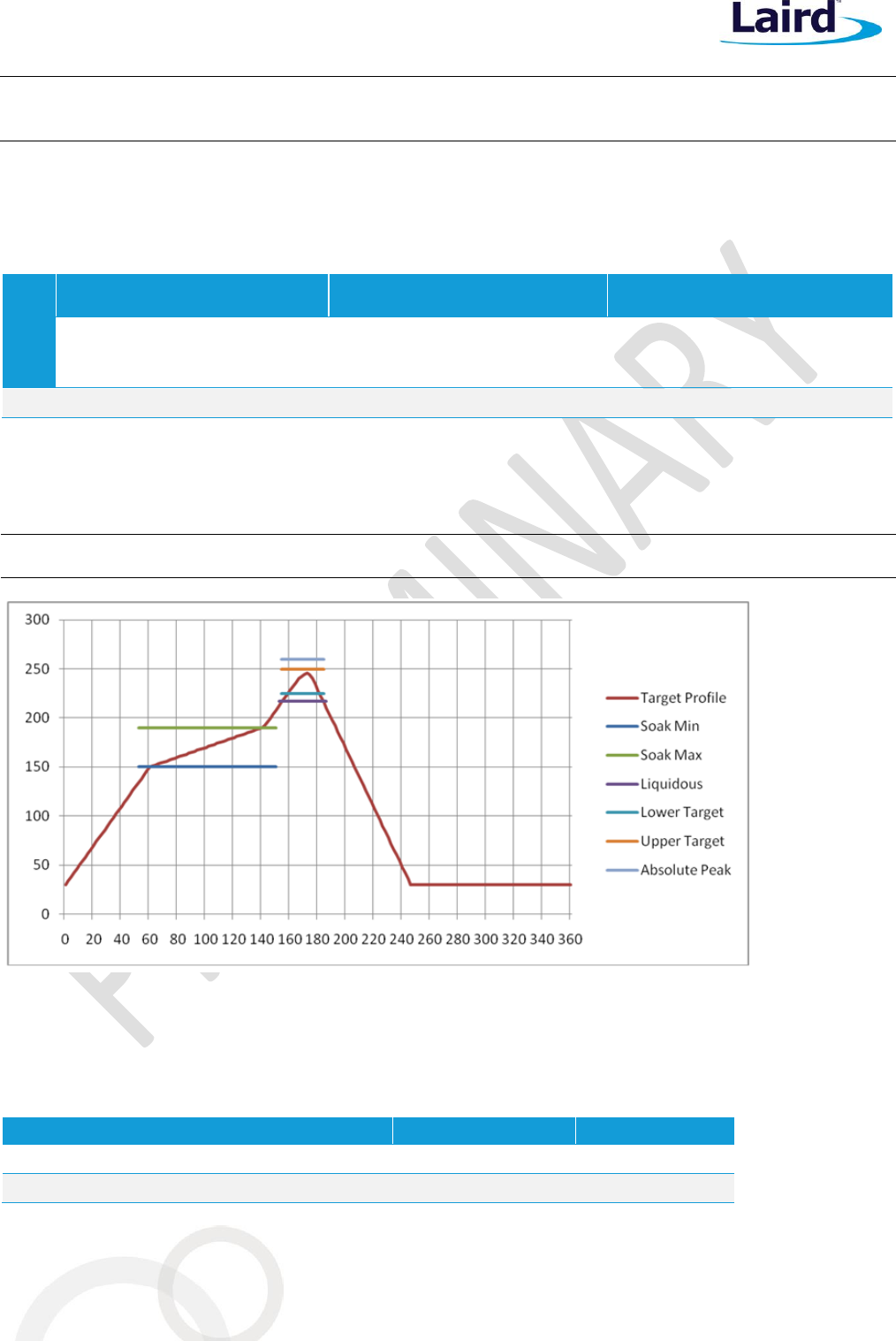
LoRa/BLE Modules
Hardware Integration Guide
Embedded Wireless Solutions Support Center:
http://ews-support.lairdtech.com
www.lairdtech.com/wireless
30
© Copyright 2016 Laird. All Rights Reserved
Americas: +1-800-492-2320
Europe: +44-1628-858-940
Hong Kong: +852 2923 0610
Note: The shipping tray cannot be heated above 65°C. If baking is required at the higher temperatures
displayed in in Table 20, the modules must be removed from the shipping tray.
Any modules not manufactured before exceeding their floor life should be re-packaged with fresh desiccate and
a new humidity indicator card. Floor life for MSL (Moisture Sensitivity Level) 3 devices is 168 hours in ambient
environment 30°C/60%RH.
Table 20: Recommended baking times and temperatures
MSL
125°C
Baking Temp.
90°C/≤ 5%RH
Baking Temp.
40°C/ ≤ 5%RH
Baking Temp.
Saturated
@ 30°C/85%
Floor Life Limit
+ 72 hours
@ 30°C/60%
Saturated
@
30°C/85%
Floor Life Limit
+ 72 hours
@ 30°C/60%
Saturated
@ 30°C/85%
Floor Life Limit
+ 72 hours @
30°C/60%
3
9 hours
7 hours
33 hours
23 hours
13 days
9 days
Laird surface mount modules are designed to be easily manufactured, including reflow soldering to a PCB.
Ultimately it is the responsibility of the customer to choose the appropriate solder paste and to ensure oven
temperatures during reflow meet the requirements of the solder paste. Laird surface mount modules conform
to J-STD-020D1 standards for reflow temperatures.
Important: During reflow, modules should not be above 260° and not for more than 30 seconds.
Figure 9: Recommended Reflow Temperature
Temperatures should not exceed the minimums or maximums presented in Table 21.
Table 21: Recommended Maximum and minimum temperatures
Specification
Value
Unit
Temperature Inc./Dec. Rate (max)
1~3
°C / Sec
Temperature Decrease rate (goal)
2-4
°C / Sec
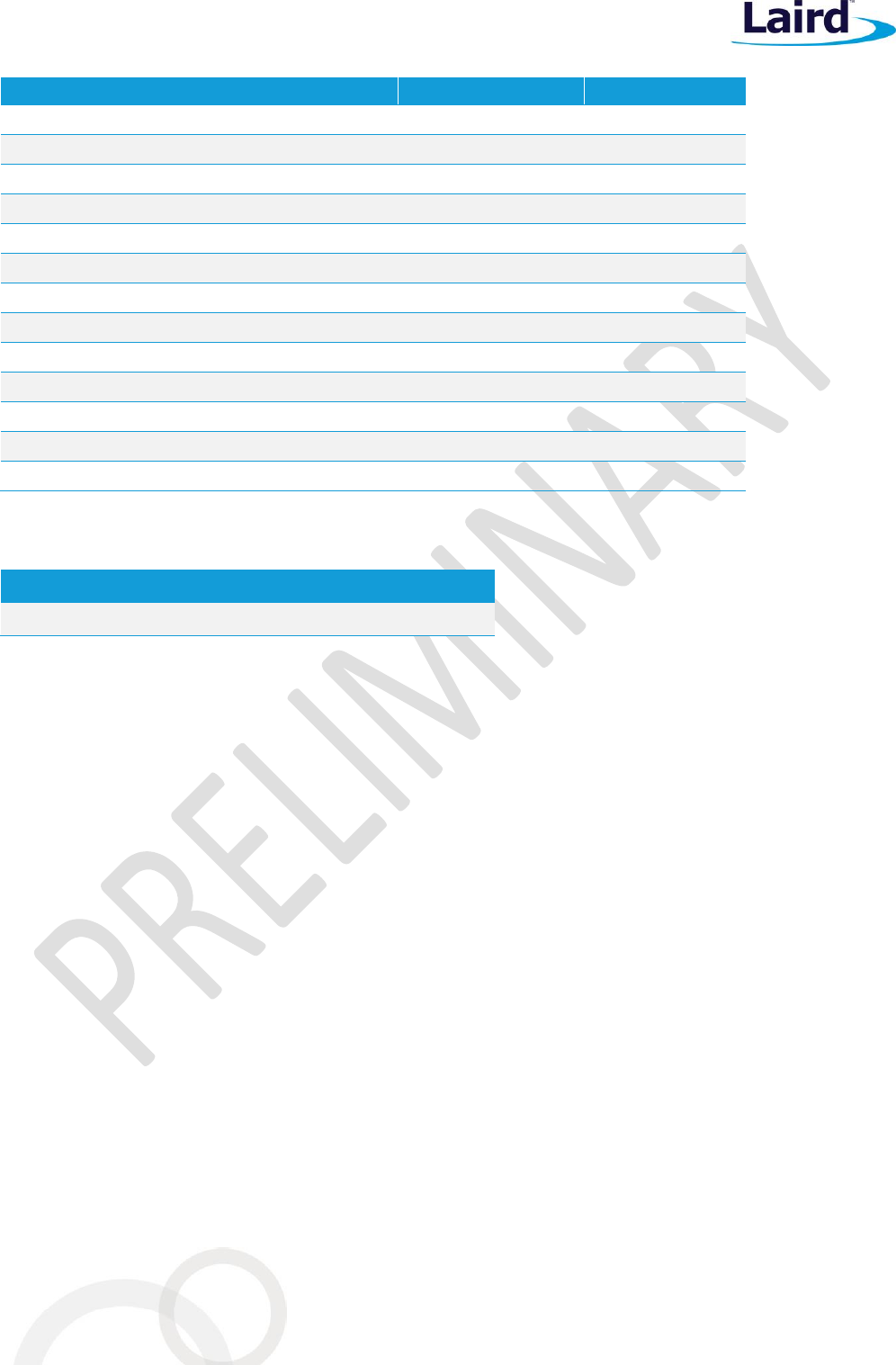
LoRa/BLE Modules
Hardware Integration Guide
Embedded Wireless Solutions Support Center:
http://ews-support.lairdtech.com
www.lairdtech.com/wireless
31
© Copyright 2016 Laird. All Rights Reserved
Americas: +1-800-492-2320
Europe: +44-1628-858-940
Hong Kong: +852 2923 0610
Specification
Value
Unit
Soak Temp Increase rate (goal)
.5 - 1
°C / Sec
Flux Soak Period (Min)
70
Sec
Flux Soak Period (Max)
120
Sec
Flux Soak Temp (Min)
150
°C
Flux Soak Temp (max)
190
°C
Time Above Liquidous (max)
70
Sec
Time Above Liquidous (min)
50
Sec
Time In Target Reflow Range (goal)
30
Sec
Time At Absolute Peak (max)
5
Sec
Liquidous Temperature (SAC305)
218
°C
Lower Target Reflow Temperature
240
°C
Upper Target Reflow Temperature
250
°C
Absolute Peak Temperature
260
°C
FCC AND IC REGULATORY STATEMENTS
Model
US/FCC
CANADA/IC
RM191-SM
SQG-RM191
3147A-RM191
The OEM must follow the regulatory guidelines and warnings listed below to inherit Laird’ modular approval.
The RM191-SM holds full modular approvals and has been certified for integration to products only by OEM
integrators under the following conditions:
1. The antenna(s) must be installed such that a minimum separation distance of 30mm is maintained
between the radiator (antenna) and all persons at all times.
2. The transmitter module must not be operating in conjunction with any other antenna or transmitter,
except in accordance with FCC multi-transmitter product procedures.
As long as the two conditions above are met, further transmitter testing will not be required. However, the
OEM integrator is still responsible for testing their end-product for any additional compliance requirements
required with this module installed (for example, digital device emissions, PC peripheral requirements, etc.).
IMPORTANT NOTE: In the event that these conditions cannot be met (for certain configurations or co-location
with another transmitter), then the FCC and Industry Canada authorizations are no longer considered valid and
the FCC ID and IC Certification Number cannot be used on the final product. In these circumstances, the OEM
integrator will be responsible for re-evaluating the end product (including the transmitter) and obtaining a
separate FCC and Industry Canada authorization.
The RM191-SM LoRa transmitter has been designed and approved to operate with the antennas listed below
with a maximum gain of 2 dBi. The required antenna impedance is 50 ohms.
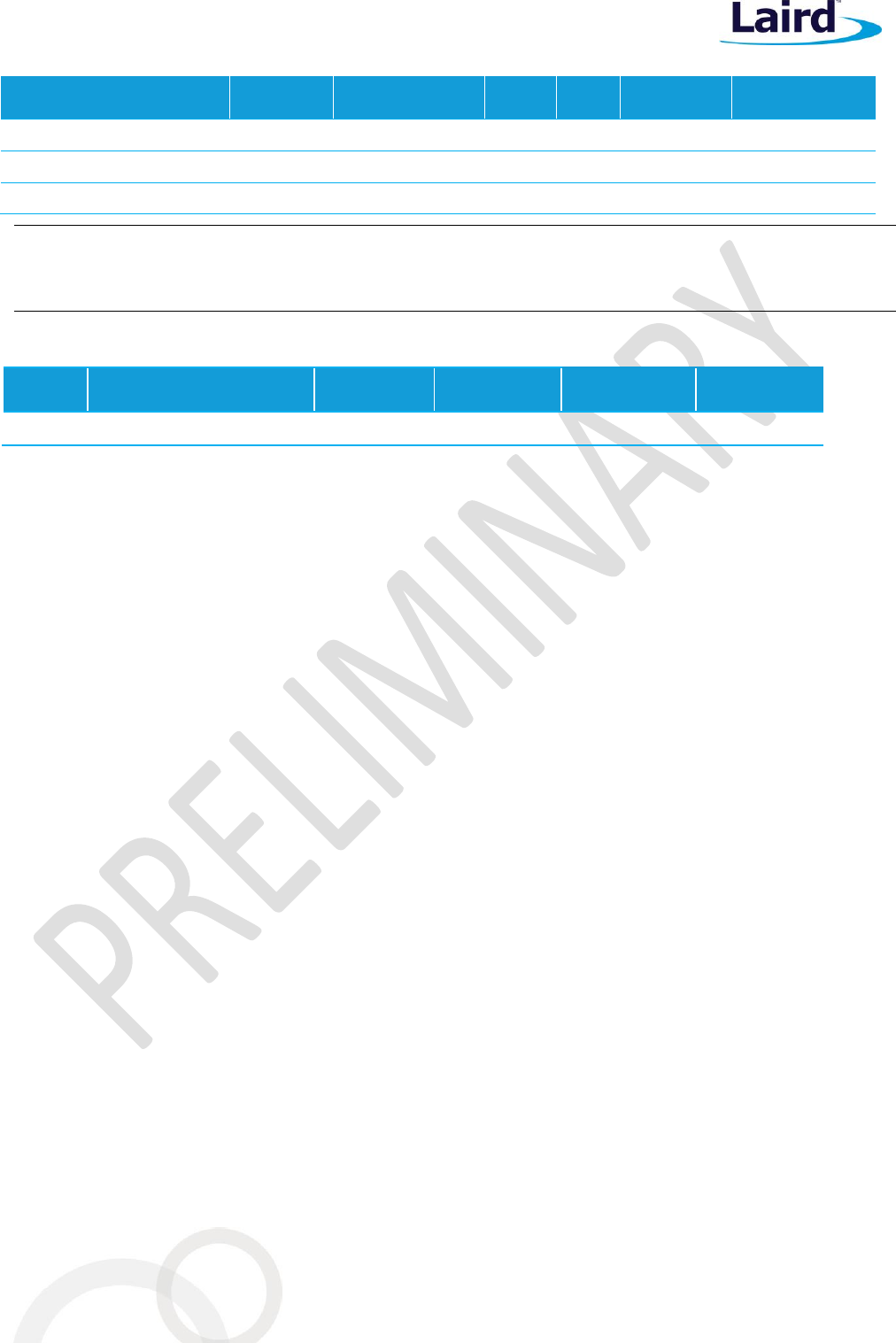
LoRa/BLE Modules
Hardware Integration Guide
Embedded Wireless Solutions Support Center:
http://ews-support.lairdtech.com
www.lairdtech.com/wireless
32
© Copyright 2016 Laird. All Rights Reserved
Americas: +1-800-492-2320
Europe: +44-1628-858-940
Hong Kong: +852 2923 0610
External Antenna Part
Number
Laird Part
Number
Mfg.
Type
Gain
(dBi)
Connector
Type
RM1xx Part
number
RFDPA131015IMBB301
TBD
Walsin
Dipole
0.9
U.FL
RM191-SM
WPANTDP036-R5A
-
World Products
Dipole
2.0
U.FL
RM191-SM
S152CL-L-PX-915S
-
Nearson
Dipole
2.0
U.FL
RM191-SM
Note: For the LoRa (external) dipole antenna, the OEM is free to choose another vendor’s antenna of like
type and equal or lesser gain (2dBi) and still maintain compliance. Reference FCC Part 15.204(c)(4) for
further information on this topic.
The RM191 BLE transmitter contains an on-board 2.4GHz chip antenna…
Item
Part Number
Mfg.
Type
Gain (dBi)
RM1xx Part
Number
1
AT5020-E3R0HBANT/LF
ACX
Ceramic
-1.5
RM191-SM
Power Exposure Information
Federal Communication Commission (FCC) Radiation Exposure Statement:
To comply with FCC RF exposure limits for general population / uncontrolled exposure, the antenna(s) used for
this transmitter must be installed to provide a separation distance of at least 30mm from all persons and
operating in conjunction with any other antenna or transmitter.
OEM Responsibilities
WARNING: The OEM must ensure that FCC and Industry Canada labelling requirements are met. This includes a
clearly visible label on the outside of the OEM enclosure specifying the appropriate Laird FCC
identifier for this product.
Contains FCC ID: SQG-RM191
Contains IC: 3147A-RM191
The OEM of the RM191-SM module must only use the approved antenna(s) listed above, which have
been certified with this module. The OEM integrator has to be aware not to provide information to
the end user regarding how to install or remove this RF module or change RF related parameters in
the user manual of the end product.
The user manual for the end product must also include the following information in a prominent
location:
To comply with FCC and Industry Canada RF exposure limits for general population / uncontrolled
exposure, the antenna(s) used for this transmitter must be installed to provide a separation distance
of at least 30mm from all persons and operating in conjunction with any other antenna or
transmitter, except in accordance with FCC multi-transmitter product procedures.
If the size of the end product is larger than 8x10cm, then the following FCC part 15.19 statement has
to also be available on visible on outside of device:
The enclosed device complies with Part 15 of the FCC Rules. Operation is subject to the following
two conditions: (1) This device may not cause harmful interference, and (2) This device must accept
any interference received, including interference that may cause undesired operation
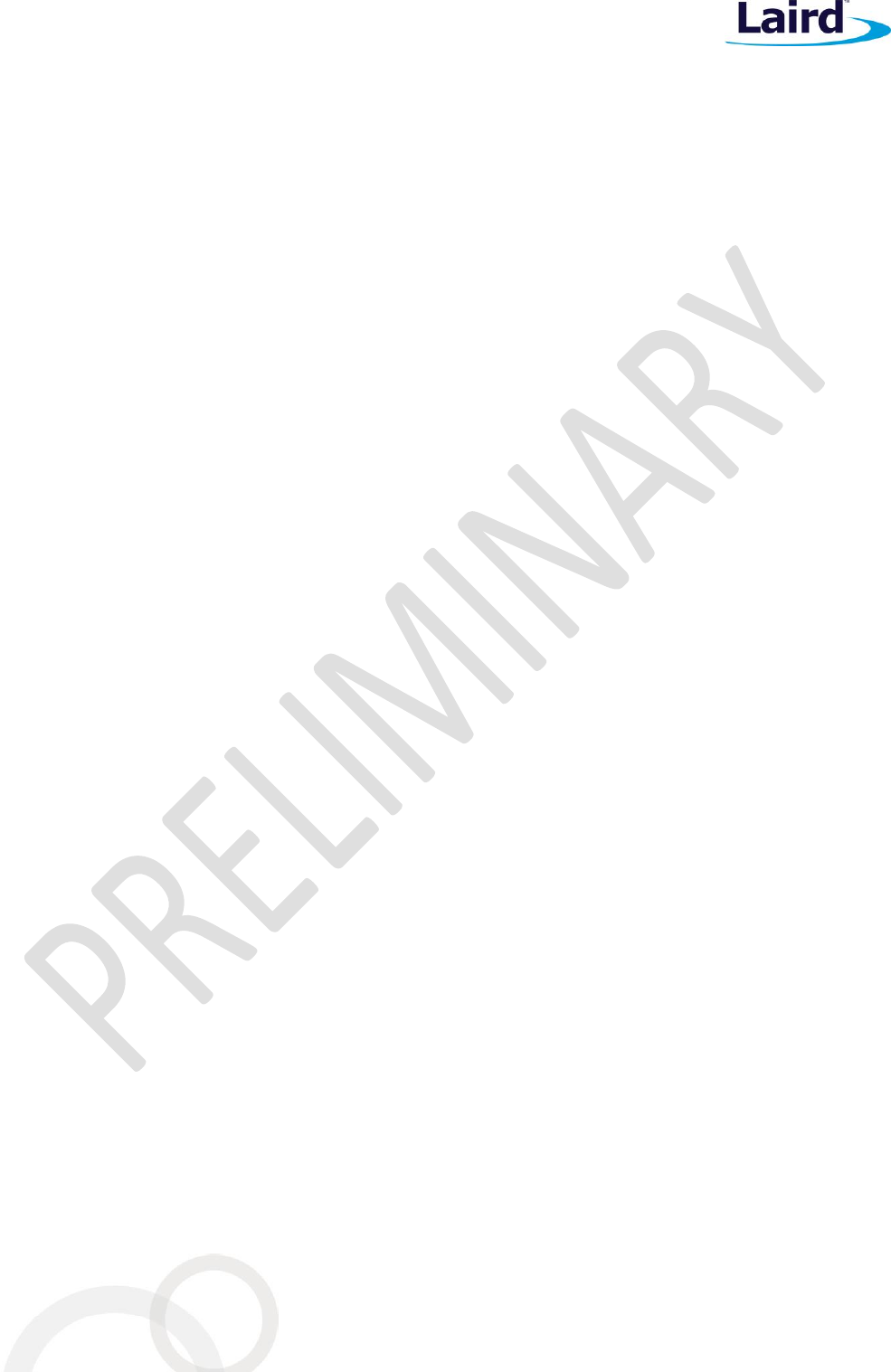
LoRa/BLE Modules
Hardware Integration Guide
Embedded Wireless Solutions Support Center:
http://ews-support.lairdtech.com
www.lairdtech.com/wireless
33
© Copyright 2016 Laird. All Rights Reserved
Americas: +1-800-492-2320
Europe: +44-1628-858-940
Hong Kong: +852 2923 0610
Label and text information should be in a size of type large enough to be readily legible, consistent
with the dimensions of the equipment and the label. However, the type size for the text is not
required to be larger than eight point.
CAUTION: The OEM should have their device which incorporates the RM191-SM tested by a qualified test
house to verify compliance with FCC Part 15 Subpart B limits for unintentional radiators.
WARNING: Changes or modifications not expressly approved by Laird could void the user’s authority to
operate the equipment.
FCC Interference Statement
This equipment has been tested and found to comply with the limits for a Class B digital device,
pursuant to Part 15 of the FCC Rules. These limits are designed to provide reasonable protection
against harmful interference in a residential installation. This equipment generates, uses, and can
radiate radio frequency energy and, if not installed and used in accordance with the instructions,
may cause harmful interference to radio communications. However, there is no guarantee that
interference will not occur in a particular installation. If this equipment does cause harmful
interference to radio or television reception, which can be determined by turning the equipment
off and on, the user is encouraged to correct the interference by one or more of the following
measures:
Re-orient or relocate the receiving antenna
Increase the separation between the equipment and the receiver
Connect the equipment to an outlet on a circuit different from that to which the receiver is
connected.
Consult the dealer or an experienced radio/TV technician for help.
FCC Warning:
“THIS DEVICE COMPLIES WITH PART 15 OF THE FCC RULES OPERATION IS SUBJECT TO THE FOLLOWING TWO
CONDITIONS: (1) THIS DEVICE MAY NOT CAUSE HARMFUL INTERFERENCE, AND (2) THIS DEVICE MUST ACCEPT
ANY INTERFERENCE RECEIVED, INCLUDING INTERFERENCE THAT MAY CAUSE UNDESIRED OPERATION.
Industry Canada (IC) Warning:
This device complies with Industry Canada license-exempt RSS standard(s). Operation is subject to the following
two conditions: (1) this device may not cause interference, and (2) this device must accept any interference,
including interference that may cause undesired operation of the device.
French equivalent is:
Le présent appareil est conforme aux CNR d'Industrie Canada applicable aux appareils radio exempts de licence.
L'exploitation est autorisée aux deux conditions suivantes : (1) l'appareil ne doit pas produire de brouillage, et
(2) l'utilisateur de l'appareil doit accepter tout brouillage radioélectrique subi, même si le brouillage est
susceptible d'en compromettre le fonctionnement.
IC Radiation Exposure Statement
To comply with Industry Canada RF exposure limits for general population / uncontrolled exposure, the
antenna(s) used for this transmitter must be installed to provide a separation distance of at least 30mm from all
persons and must not be operating in conjunction with any other antenna or transmitter.
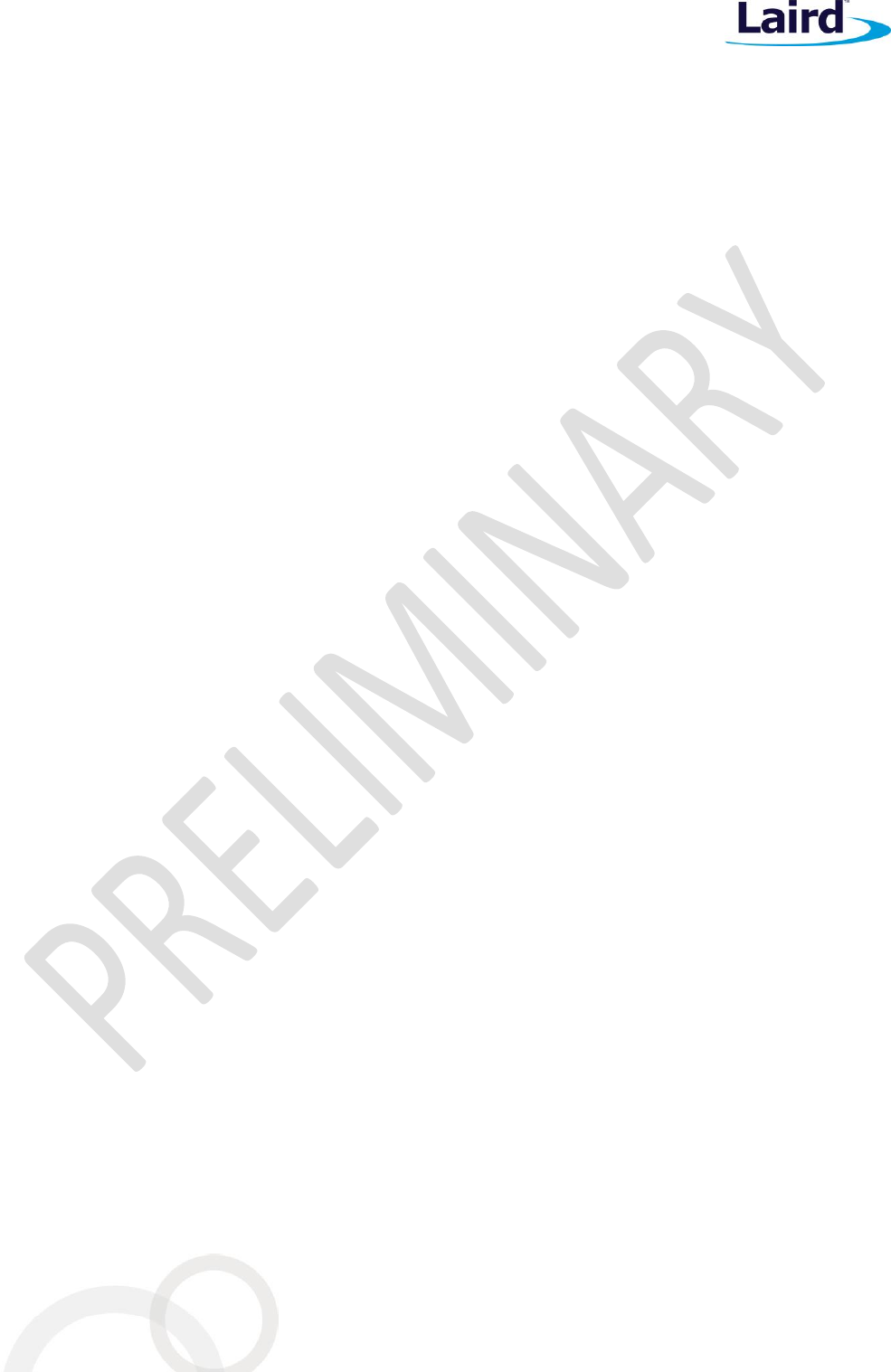
LoRa/BLE Modules
Hardware Integration Guide
Embedded Wireless Solutions Support Center:
http://ews-support.lairdtech.com
www.lairdtech.com/wireless
34
© Copyright 2016 Laird. All Rights Reserved
Americas: +1-800-492-2320
Europe: +44-1628-858-940
Hong Kong: +852 2923 0610
REMARQUE IMPORTANTE
Déclaration IC d'exposition aux radiations
Pour se conformer à Industrie Canada RF limites d'exposition pour la population générale / exposition non
contrôlée, l'antenne utilisée pour ce transmetteur doit être installée pour fournir une distance d'au moins
30 mm de toutes les personnes et ne doit pas fonctionner en conjonction avec toute autre antenne ou
transmetteur.
Modular Approval
OEM integrator is still responsible for testing their end product for any additional compliance requirements
required with this module installed (for example, digital device emissions, PC peripheral requirements, etc.).
Approbation modulaire
OEM intégrateur est toujours responsable de tester leur produit final pour les exigences de conformité
supplémentaires nécessaires à ce module installé (par exemple, les émissions de périphériques numériques, les
exigences de périphériques PC, etc.)
IMPORTANT NOTE:
In the event that these conditions cannot be met (for example certain laptop configurations or co-location with
another transmitter), then the Canada authorization is no longer considered valid and the IC ID cannot be used
on the final product. In these circumstances, the OEM integrator will be responsible for re-evaluating the end
product (including the transmitter) and obtaining a separate Canada authorization.
NOTE IMPORTANTE:
Dans le cas où ces conditions ne peuvent être satisfaites (par exemple pour certaines configurations
d'ordinateur portable ou de certaines co-localisation avec un autre émetteur), l'autorisation du Canada n'est
plus considéré comme valide et l'ID IC ne peut pas être utilisé sur le produit final. Dans ces circonstances,
l'intégrateur OEM sera chargé de réévaluer le produit final (y compris l'émetteur) et l'obtention d'une
autorisation distincte au Canada.
Le produit final doit être étiqueté dans un endroit visible avec l'inscription suivante: " RM191-SM Contient des
IC: 3147A-RM191";
CE REGULATORY
The RM186 has been tested for compliance with relevant standards for the EU market. The RM186 module has
been tested with a 2.0dBi external dipole antenna for LoRa, and the -1.5dBi on-board chip antenna for the BLE
transmitter. For the external LoRa dipole antenna, the OEM can operate any other type of antenna but must
ensure that the gain does not exceed 2.0dBi to maintain the Laird Technologies approval.
The OEM should consult with a qualified test house before entering their device into an EU member country to
make sure all regulatory requirements have been met for their complete device.
Reference the Declaration of Conformities listed below for a full list of the standards that the modules were
tested to. Test reports are available upon request.
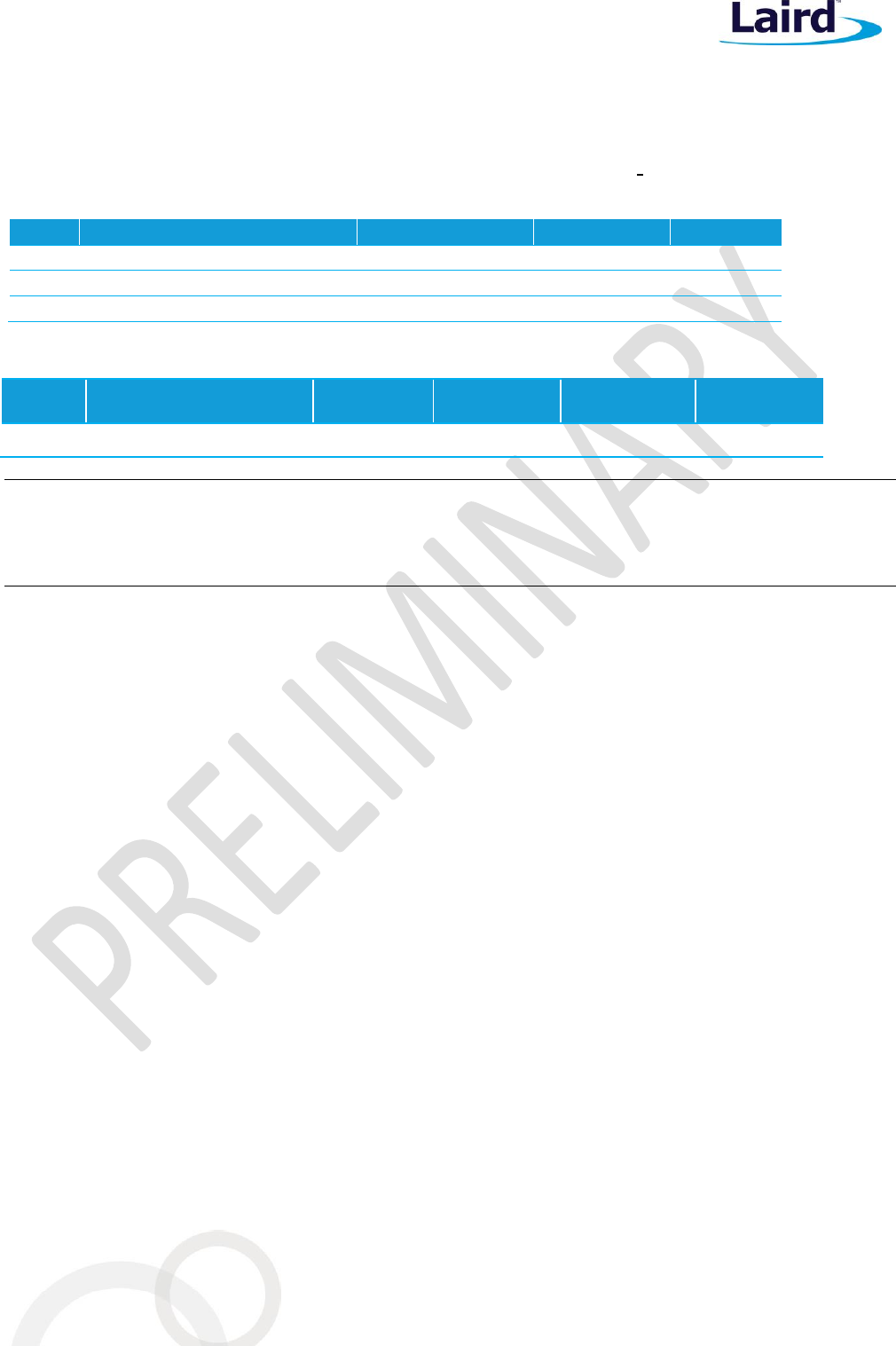
LoRa/BLE Modules
Hardware Integration Guide
Embedded Wireless Solutions Support Center:
http://ews-support.lairdtech.com
www.lairdtech.com/wireless
35
© Copyright 2016 Laird. All Rights Reserved
Americas: +1-800-492-2320
Europe: +44-1628-858-940
Hong Kong: +852 2923 0610
Antenna Information
The external flying lead U.FL dipole antennas for the 868MHz LoRa radio listed below were tested for use with
the RM186. For CE mark countries, the OEM is free to use any manufacturer’s antenna and type of antenna as
long as the gain is less than or equal to the highest gain approved for use (2.0dBi) Contact a Laird Technologies
representative for more information regarding adding antennas.
Item
LoRa Antenna Part#
artNumber
Mfg.
Type
Gain (dBi)
1
RFDPA131015IMBB301
Walsin
Dipole
0.9
2
WPANTDP036-R5A
World Products
Dipole
2.0
3
S152CL-L-PX-868S
Nearson
Dipole
2.0
The BLE transmitter on board the RM186 has been approved with an on-board -1.5dBi chip antenna…
Item
Part Number
Mfg.
Type
Gain (dBi)
RM1xx Part
Number
1
AT5020-E3R0HBANT/LF
ACX
Ceramic
-1.5
RM191-SM
Note: The RM186 module internal BLE chipset IC pins are rated 4 kV (ESD HBM). ESD can find its way through
the external 2-Wire SWD Programming/Debug Interface connector (if used on the customers design), if
discharge is applied directly. Customer should ensure adequate protection against ESD on their end
product design (using the RM186 module) to meet relevant ESD standard (for CE, this is EN301-489).
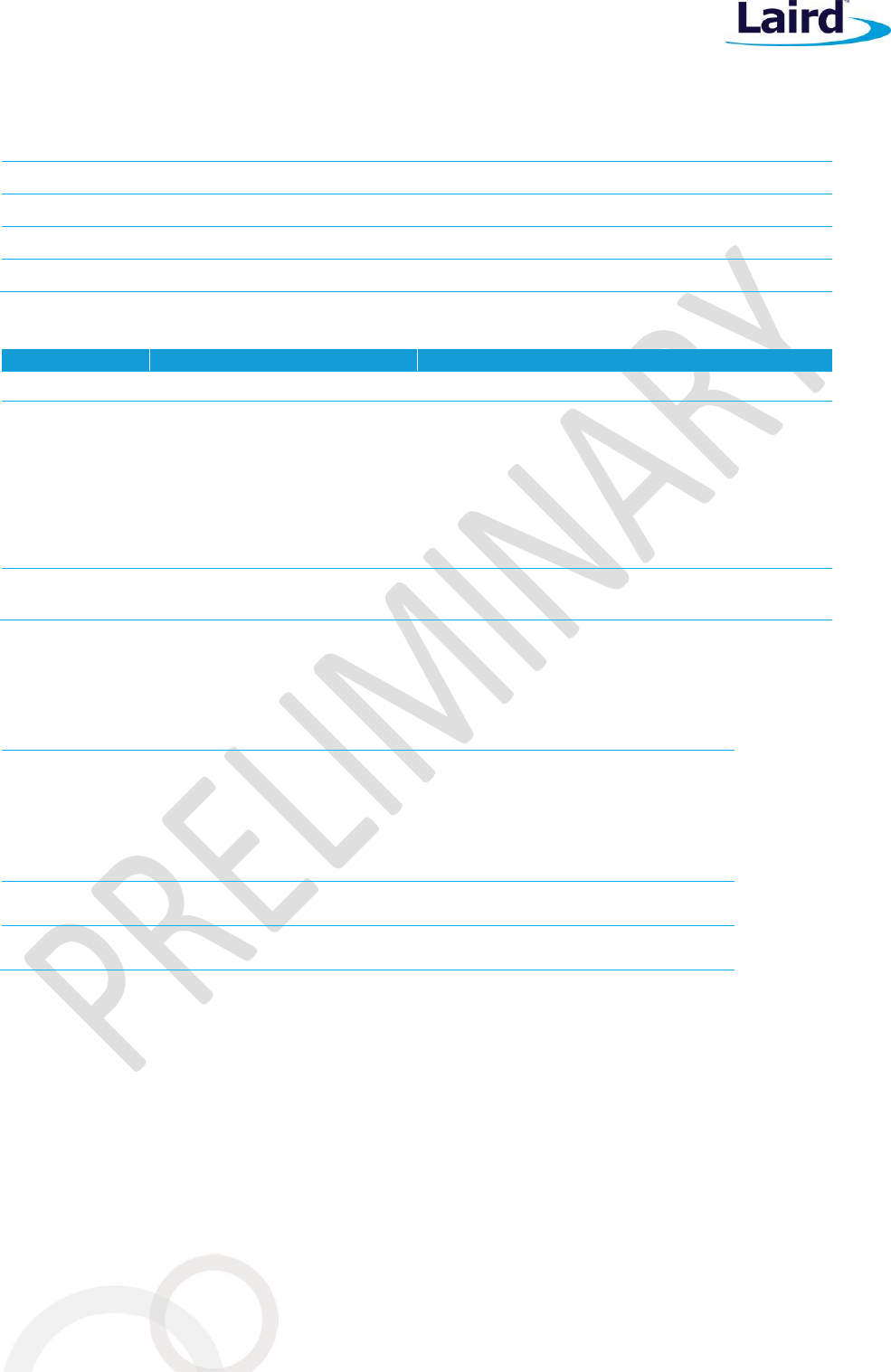
LoRa/BLE Modules
Hardware Integration Guide
Embedded Wireless Solutions Support Center:
http://ews-support.lairdtech.com
www.lairdtech.com/wireless
36
© Copyright 2016 Laird. All Rights Reserved
Americas: +1-800-492-2320
Europe: +44-1628-858-940
Hong Kong: +852 2923 0610
EU DECLARATIONS OF CONFORMITY
RM186-SM
Manufacturer:
Laird
Product:
RM186-SM
EU Directive:
RTTE 1995/5/EC
Conformity Assessment:
Annex IV
Reference standards used for presumption of conformity:
Article Number
Requirement
Reference standard(s)
3.1a
Health and Safety
EN60950-1:2006+A11:2009+A1:2010+A12:2011
3.1b
Protection requirements with
respect to electromagnetic
compatibility
EN 301 489-1 V1.9.2 (2011-09)
EN 301 489-17 V2.2.1 (2012-09)
Emissions:
EN55022:2006/A1:2007 (Class B)
Immunity:
EN61000-4-2:2009
EN61000-4-3:2006/A1:2008/A2:2010
3.2
Means of the efficient use of
the radio frequency spectrum
EN 300 328 V1.8.1 (2012-06)
Declaration:
We, Laird, declare under our sole responsibility that the essential radio test suites have been carried out and
that the above product to which this declaration relates is in conformity with all the applicable essential
requirements of Article 3 of the EU Directive 1999/5/EC, when used for its intended purpose.
Place of Issue:
Laird
W66N220 Commerce Court, Cedarburg, WI 53012
USA
tel: +1-262-375-4400
fax: +1-262-364-2649
Date of Issue:
April 2016
Name of Authorized Person:
Thomas T Smith, Director of EMC Compliance
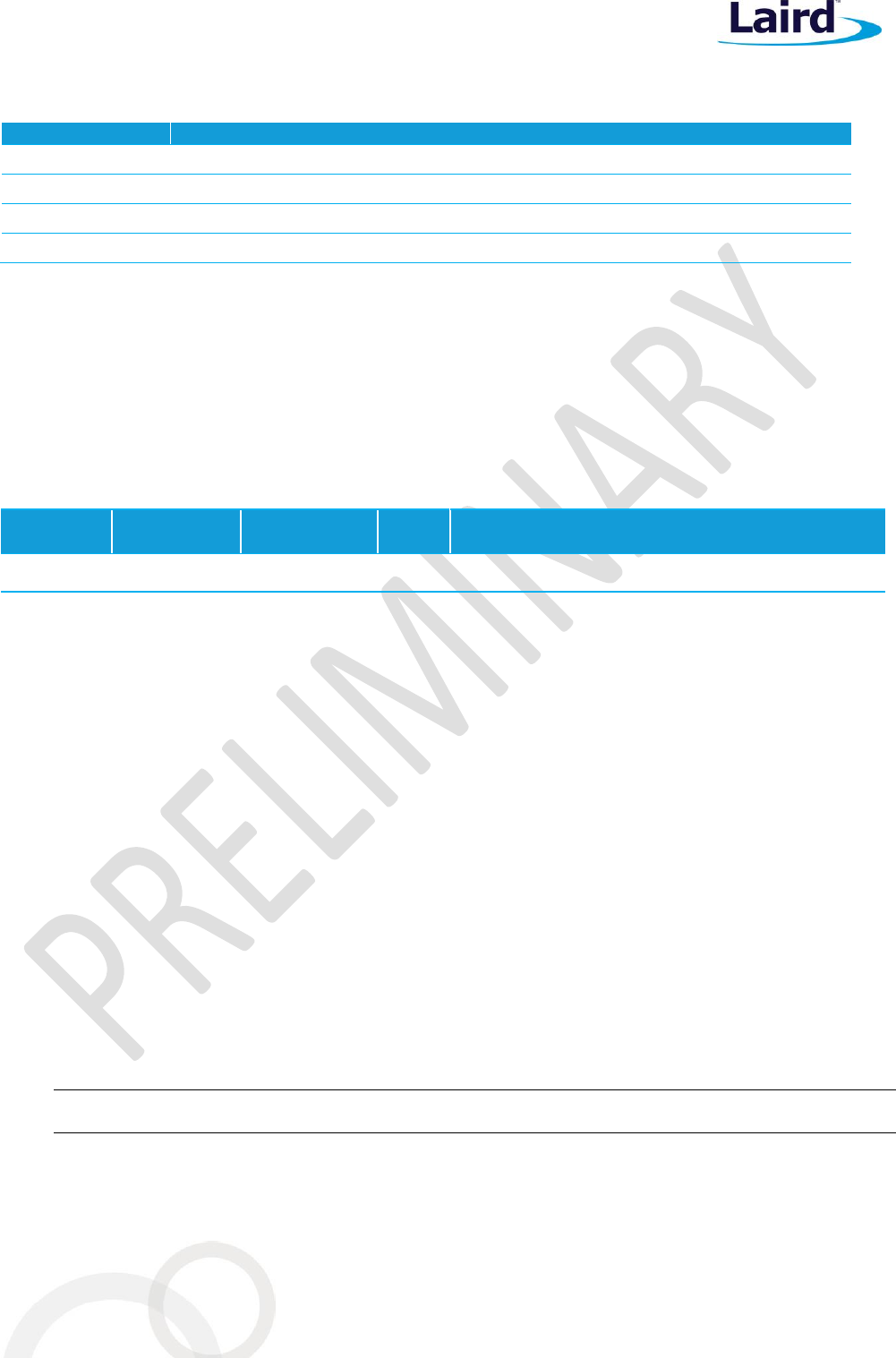
LoRa/BLE Modules
Hardware Integration Guide
Embedded Wireless Solutions Support Center:
http://ews-support.lairdtech.com
www.lairdtech.com/wireless
37
© Copyright 2016 Laird. All Rights Reserved
Americas: +1-800-492-2320
Europe: +44-1628-858-940
Hong Kong: +852 2923 0610
ORDERING INFORMATION
Part Number
Description
RM186-SM
Intelligent LoRa/BLE Module [868MHz LoRa for Europe] featuring smart BASIC
RM191-SM
Intelligent LoRa/BLE Module [915MHz LoRa for US] featuring smart BASIC
DVK – RM186-SM
Development board with RM186-SM module soldered in place
DVK – RM191-SM
Development board with RM191-SM module soldered in place
General Comments
This is a preliminary datasheet. Please check with Laird for the latest information before commencing a design. If
in doubt, ask.
BLUETOOTH SIG QUALIFICATION
Overview
The RM186 & RM191 modules are listed on the Bluetooth SIG website as a qualified End Product.
Design
Name
Owner
Declaration ID
QD ID
Link to listing on the SIG website
RM186-SM
Laird
TBD
TBD
TBD
RM191-SM
Laird
TBD
TBD
TBD
It is a mandatory requirement of the Bluetooth Special Interest Group (SIG) that every product implementing
Bluetooth technology has a Declaration ID. Every Bluetooth design is required to go through the qualification
process, even when referencing a Bluetooth Design that already has its own Declaration ID. The Qualification
Process requires each company to register as a member of the Bluetooth SIG – www.bluetooth.org
The following is a link to the Bluetooth Registration page: https://www.bluetooth.org/login/register/
For each Bluetooth Design it is necessary to purchase a Declaration ID. This can be done before starting the new
qualification, either through invoicing or credit card payment. The fees for the Declaration ID will depend on
your membership status, please refer to the following webpage:
https://www.bluetooth.org/en-us/test-qualification/qualification-overview/fees
For a detailed procedure of how to obtain a new Declaration ID for your design, please refer to the following SIG
document:
https://www.bluetooth.org/DocMan/handlers/DownloadDoc.ashx?doc_id=283698&vId=317486
Qualification Steps When Referencing a Laird End Product Design
To qualify your product when referencing a Laird end-product design, follow these steps:
1. To start a listing, go to: https://www.bluetooth.org/tpg/QLI_SDoc.cfm
Note: A user name and password are required to access this site.
2. In step 1, select the option, New Listing and Reference a Qualified Design.
3. Enter TBD or TBD in the End Product table entry.
4. Select your pre-paid Declaration ID from the drop down menu or go to the Purchase Declaration ID page.
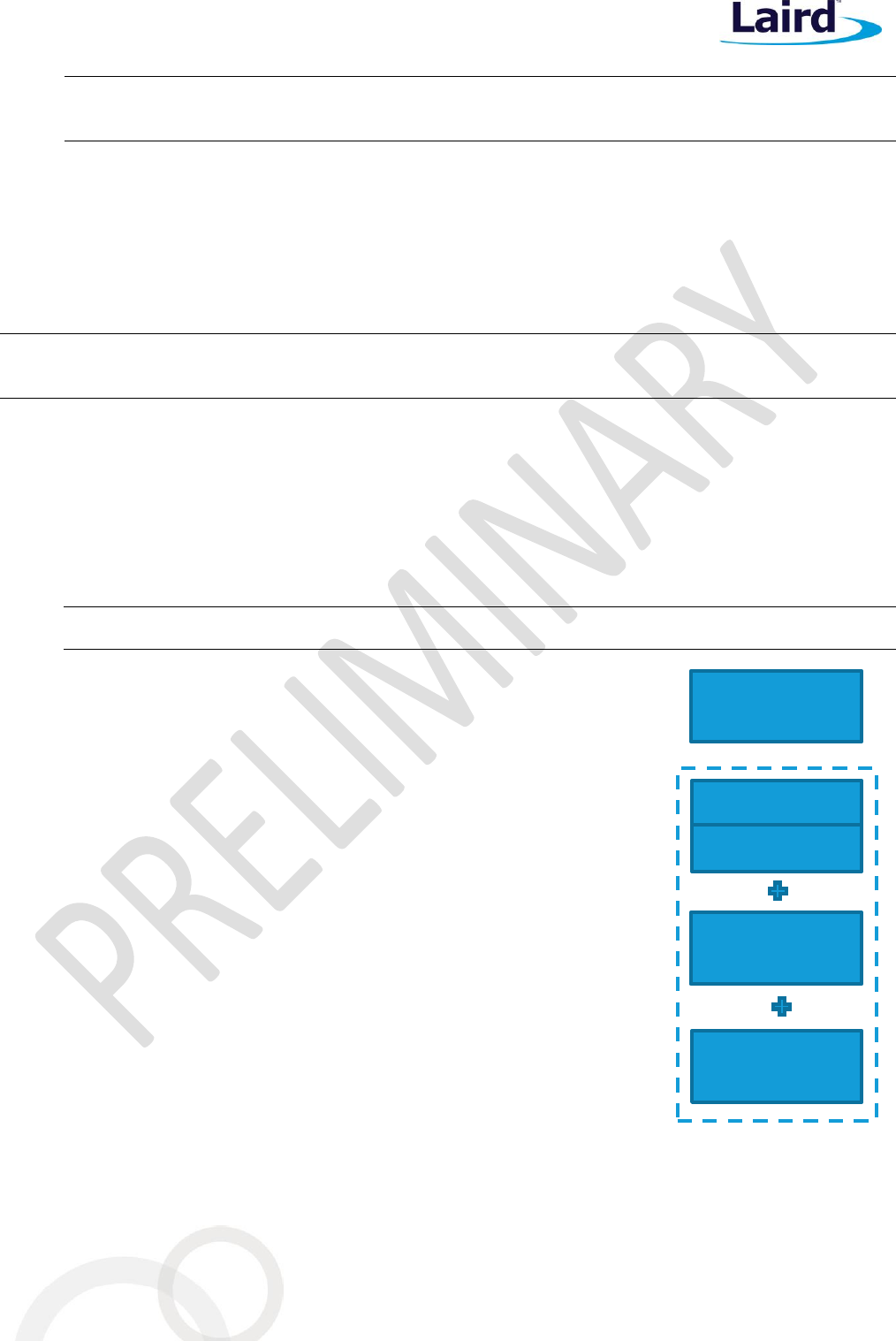
LoRa/BLE Modules
Hardware Integration Guide
Embedded Wireless Solutions Support Center:
http://ews-support.lairdtech.com
www.lairdtech.com/wireless
38
© Copyright 2016 Laird. All Rights Reserved
Americas: +1-800-492-2320
Europe: +44-1628-858-940
Hong Kong: +852 2923 0610
Note: Unless the Declaration ID is pre-paid or purchased with a credit card, you cannot proceed until
the SIG invoice is paid.
5. Once all the relevant sections of step 1 are finished, complete steps 2, 3, and 4 as described in the help
document accessible from the site.
Your new design will be listed on the SIG website and you can print your Certificate and DoC.
For further information please refer to the following training material:
https://www.bluetooth.org/en-us/test-qualification/qualification-overview/listing-process-updates
Note: If using the RM1xx with Laird Firmware and smartBASIC script, you can skip Controller Subsystem,
Host Subsystem, and Profile Subsystem.
Qualification Steps When Deviating From a Laird End Product Design
If you wish to deviate from the standard End Product designs listed under TBD or TBD, the qualification process
follows the New Listing route (without referencing a Qualified Design). When creating a new design it is
necessary to complete the full qualification listing process and also maintain a compliance folder for the design.
If your design is based on un-modified RM1xx hardware, follow these steps:
1. Reference the existing RF-PHY test report from the RM1xx listing.
Note: This report is available from Laird: ews-support@lairdtech.com
2. Combine the relevant Nordic Link Layer (LL).
3. Combine in a Host Component (covering L2CAP, GAP, ATT, GATT, SM).
4. Test any standard SIG profiles that are supported in the design, (customs
profiles are exempt).
The first step is to generate a project on the TPG (Test Plan Generator) system,
select ‘Traditional Project’. This determines which test cases apply to demonstrate
compliance with the Bluetooth Test Specifications, from the TPG you generate a
Test Declaration, (Excel format). If you are combining pre-tested and qualified
components in your design, and they are within their 3 year listing period, you are
not required to re-test those layers covered by those components.
End
Product
Laird RF-PHY
Nordic LL
Host
Layers
Profiles
Figure 10: Scope of the qualification for an End Product Design.
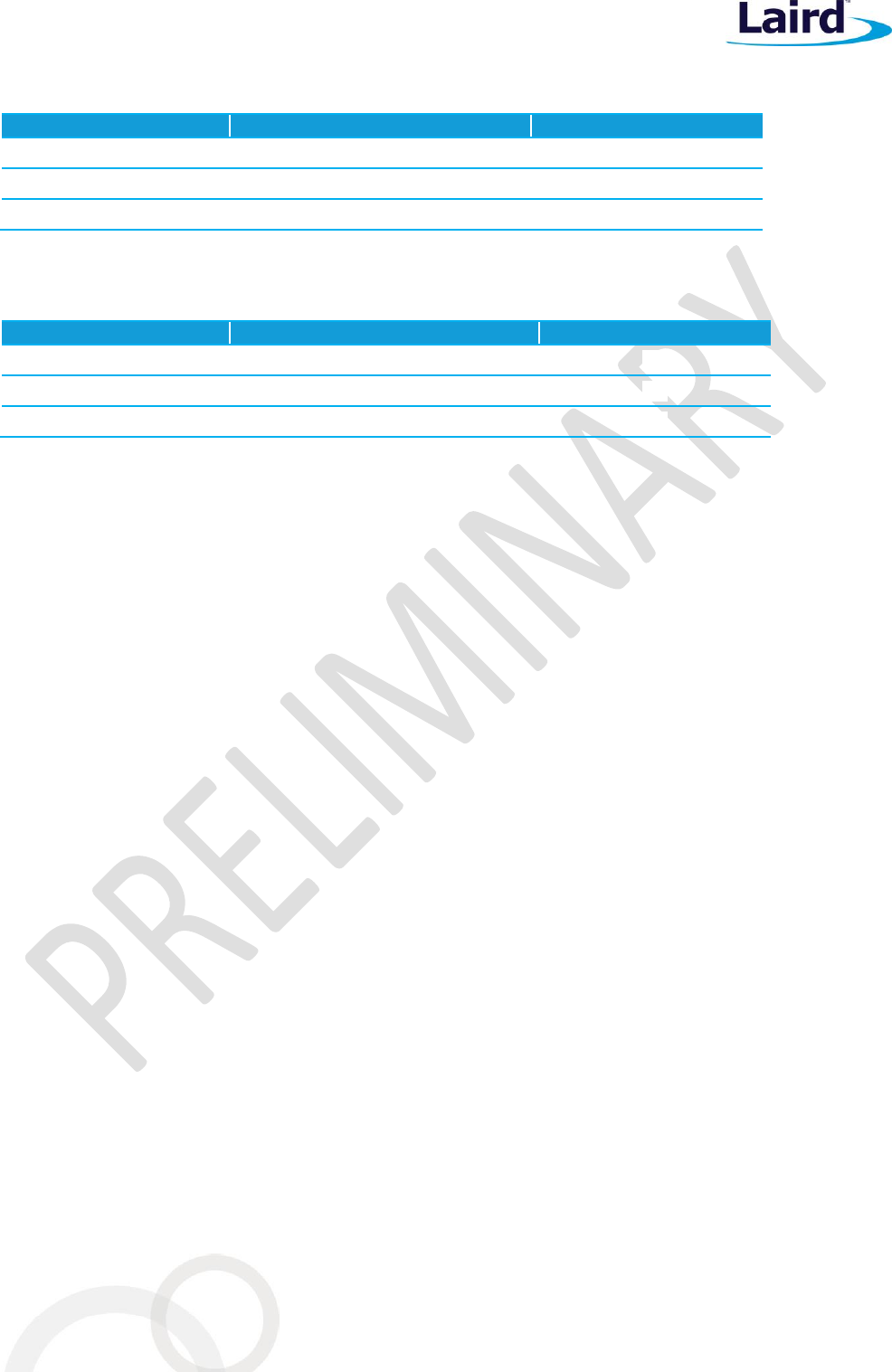
LoRa/BLE Modules
Hardware Integration Guide
Embedded Wireless Solutions Support Center:
http://ews-support.lairdtech.com
www.lairdtech.com/wireless
39
© Copyright 2016 Laird. All Rights Reserved
Americas: +1-800-492-2320
Europe: +44-1628-858-940
Hong Kong: +852 2923 0610
Examples of LL components that can be combined into a new design are:
Listing reference
Design Name
Core Spec Version
TBD
nRF51xxx stack: S110 link layer
4.0
TBD
Sx20_nRF51xxx link layer
4.1
TBD
S130_nRF51xxx link layer
4.2
*Note: Please check with Laird/Nordic for applicable LL components.
Examples of Host Stack components that can be integrated into the new design are;
Listing reference
Design Name
Core Spec Version
TBD
nRF51xxx stack: S110 host layer
4.0
TBD
Sx20_nRF51xxx host layer
4.1
TBD
S130_nRF51xxx host layer
4.2
*Note: You may choose any Host Stack and optional profiles in you design.
If the design incorporates any standard SIG LE profiles (such as Heart Rate Profile, refer to section, External to
the Core - Current and Qualifiable GATT-based Profile and Service Test Requirements), it is necessary to test
these profiles using PTS or other tools where permitted; the results are added to the compliance folder.
You are required to upload your test declaration and test reports (where applicable) and complete the final
listing steps on the SIG website. Remember to purchase your Declaration ID before you start the qualification
process; you cannot complete the listing without it.
To start a listing, go to: https://www.bluetooth.org/tpg/QLI_SDoc.cfm. In step 1, select the option, New Listing,
(without referencing a Qualified Design).
Additional Assistance
Please contact your local sales representative or our support team for further assistance:
Laird Technologies Connectivity Products Business Unit
Support Centre: http://ews-support.lairdtech.com
Email: wireless.support@lairdtech.com
Phone: Americas: +1-800-492-2320
Europe: +44-1628-858-940
Hong Kong: +852 2923 0610
Web: http://www.lairdtech.com/bluetooth